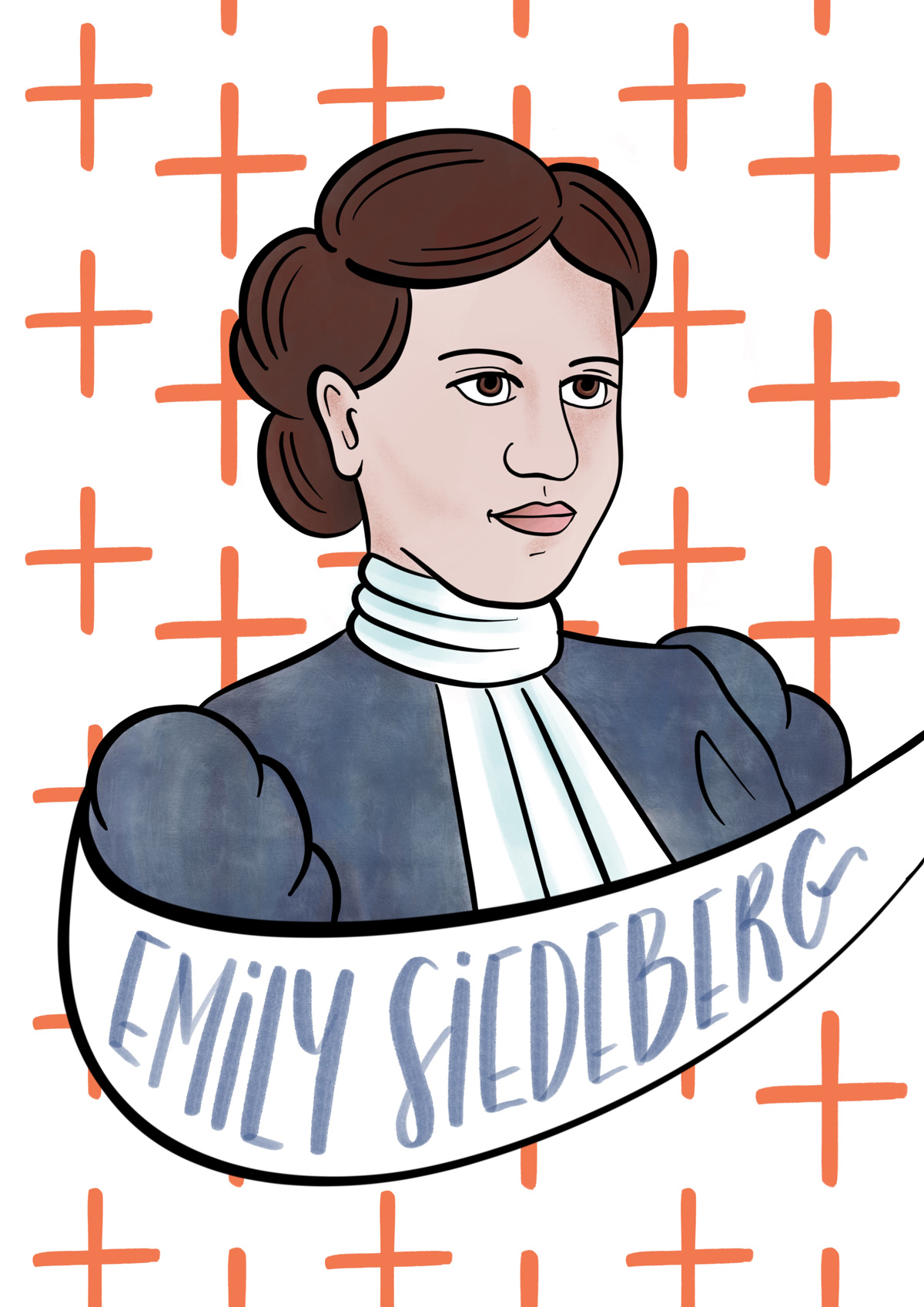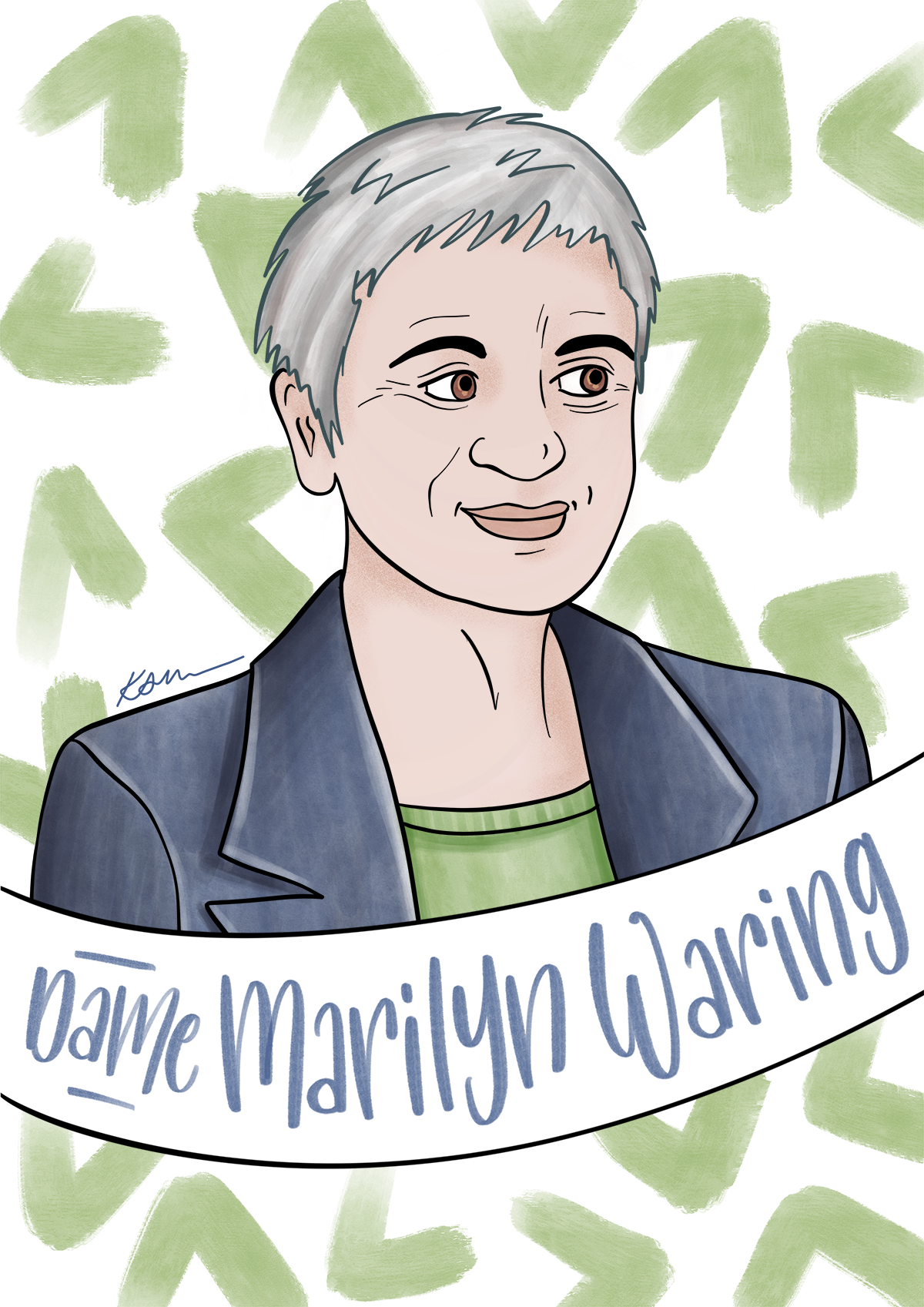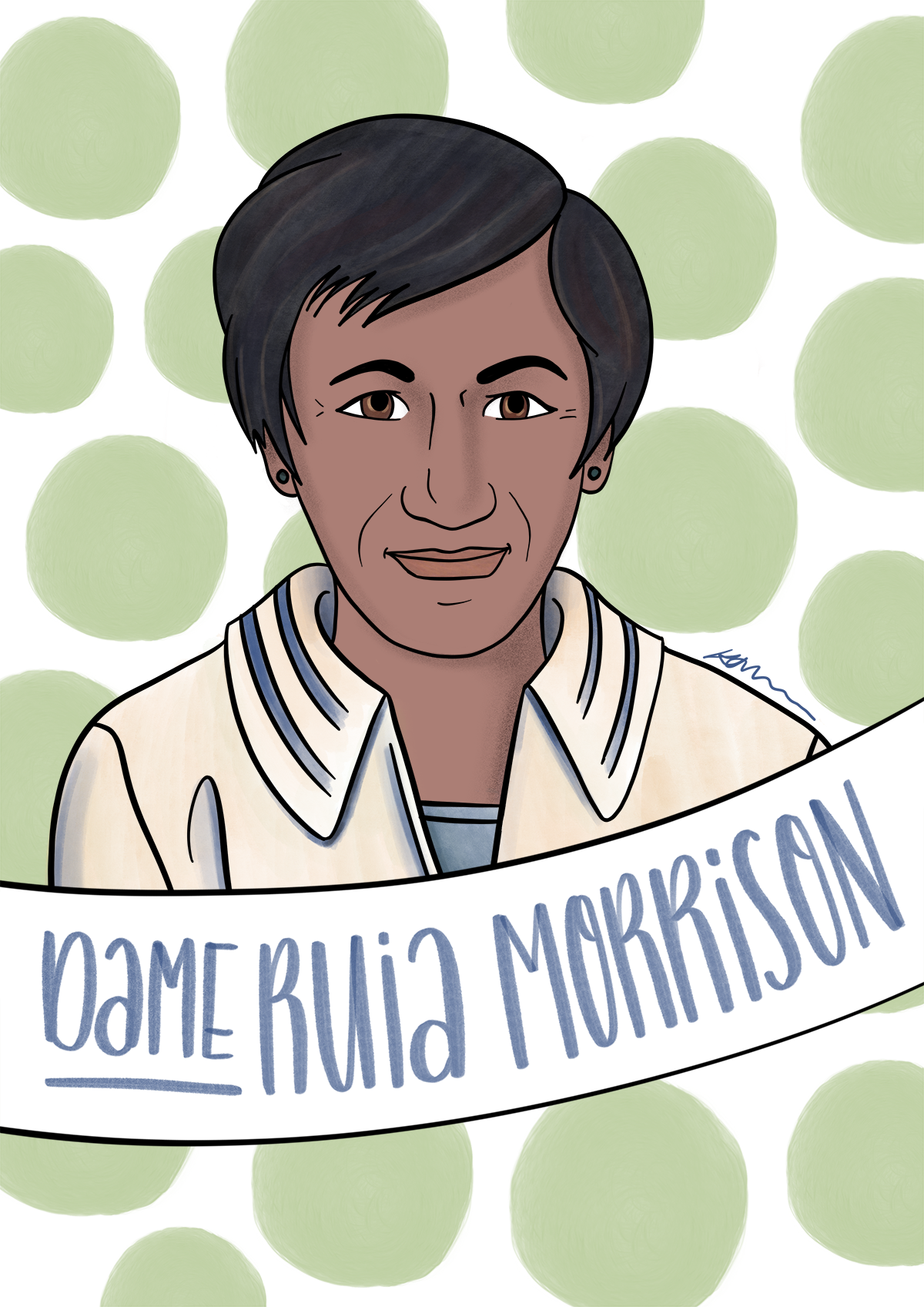DAME WHINA COOPER
TE WHAEA O TE MOTU (MOTHER OF THE NATION)
Dame Whina Cooper ONZ DBE
1895 - 1994
Te Rārawa
On September 14, 1975 at the age of 80, a frail but passionately articulate Dame Whina led 50 land protestors from Te Hāpua in the far north on a 1000km hikoi to Wellington. Her words "Not one more acre of Māori land" came to represent the struggle for Māori land rights. More than 5000 protestors arrived at the steps of Parliament on October 13.
Dame Whina was born Hohepine (Josephine) Te Wake at Te Karaka in northern Hokianga. The first child of Heremia Te Wake, a leader of Ngāti Manawa, a hapu of Te Kaitutae and Te Rarawa, and Kare Pauro Kawatihi of Te Rārawa and Taranaki descent. Dame Whina was educated at St Joseph’s Māori Girls’ College and, at 18, led her first protest to stop the draining of a local swamp. During her long and colourful life she was a wife, mother, teacher, postmistress, shopkeeper, farmer and the first female president of a rugby club.
She worked tirelessly for land rights and social justice for Māori and, in 1951, founded and was the first president of Te Rōpū Wāhine Māori Toko i te Ora (Māori Women’s Welfare League). In 1957 the League honoured her with the title Te Whaea o te Motu (Mother of the Nation).
In 1981 she was made a Dame Commander of the Order of the British Empire and, in 1991, Dame Whina was appointed to the Order of New Zealand. She died at Panguru aged 98. More than one million people watched the live television coverage of her tangi.
“Let us all remember that the Treaty was signed so that we could all live as one nation in Aotearoa.” - Dame Whina Cooper, opening the 14th Commonwealth Games in Auckland in January 1990.
More to Read
Whina, Michael King. Auckland, 1983
Bibliography
Michael King. 'Cooper, Whina', Dictionary of New Zealand Biography, first published in 2010. Te Ara - the Encyclopedia of New Zealand, https://teara.govt.nz/en/biographies/5c32/cooper-whina
https://nzhistory.govt.nz/people/dame-whina-cooper
https://www.independent.co.uk/news/people/obituary-dame-whina-cooper-1432167.html

HELEN CLARK
POLITICIAN
Helen Elizabeth Clark ONZ PC
b. 1950
Following the 1999 general election, Helen became New Zealand's first elected female Prime Minister and went on to be the first Labour Prime Minister to secure three consecutive terms in office.
She grew up on a farm near Hamilton, went to Epsom Girls’ Grammar School and completed an MA in Political Studies at the University of Auckland. Helen was first elected to Parliament in 1987 as MP for Mt Albert and represented that electorate until 2009.
She played a major role in New Zealand’s adoption of an anti-nuclear policy and received the Danish Peace Foundation Peace Prize in 1986. Four years later Helen became the first New Zealand woman appointed to the Privy Council. In 1993 she was elected leader of the Labour Party, the first woman to lead a major New Zealand political party. During her nine years in office she addressed controversial issues including Māori rights, same sex civil union and prostitution law reform and advocated strongly for climate change, sustainable development and gender equality.
On leaving parliament in 2009, Helen became the first woman to lead the United Nations Development Program. For eight years sheoversaw the UNDP’s work with developing nations and was considered by many to be the most powerful woman in the United Nations.She unsuccessfully campaigned for the position of United Nations Secretary General during 2016 and in 2018 was appointed to the Global Fund, an international organisation aiming to reform drug policy to reduce societal harm. Helen was appointed a Member of the Order of New Zealand in 2010.
“If more issues of importance to women are to rise to the top of political, legislative and budget priorities, more women must sit at the top table… Women must be drivers of development – not just passive beneficiaries of plans designed by others.” – Helen Clark
More to Read:
Women, Equality, Power Selected speeches from a life of leadership – Helen Clark
Allan and Unwin, 2018
More to Listen to:
The 9th Floor – The Commander- Helen Clark
https://www.radionz.co.nz/programmes/the-9th-floor/story/201842639/the-commander-helen-clark
More to Watch:
My Year With Helen- Gaylene Preston -https://myyearwithhelen.com/
Bibliography:
https://www.g-l-f.org/index.cfm?id=85774
https://www.nzherald.co.nz/nz/news/article.cfm?c_id=1&objectid=12115940
https://www.britannica.com/biography/Helen-Clark
https://www.nzherald.co.nz/nz/news/article.cfm?c_id=1&objectid=12115940

MAI CHEN
LAWYER. ACADEMIC. AUTHOR.
Mai Chen
b. 1964
Now recognised as one of New Zealand’s top public and constitutional law experts, Mai arrived in New Zealand from Taiwan as a six-year-old, speaking no English. In 1981, she was dux, head girl and best all-round student at Otago Girls’ High School, and went on to complete her Masters of Law at Harvard Law School in 1988.
In 1992, Mai became the youngest senior lecturer in law at Victoria University of Wellington. Two years later she co-founded Chen Palmer with former Prime Minister the Rt Hon Sir Geoffrey Palmer. It was one of New Zealand’s first boutique law firms and the first public law specialist firm in Australasia.
Her early years as a member of one of the first immigrant Taiwanese families in New Zealand, gave Mai an understanding of life as an outsider. She now works to empower women and champion diversity through her numerous governance, advisory and leadership roles and is making legal advice more accessible to all New Zealanders through her books and websites.
Mai is an adjunct professor at the University of Auckland, chairs New Zealand Global Women andthe Superdiversity Institute for Law, Policy and Business, which is working to help New Zealanders adapt to a superdiverse New Zealand. She founded New Zealand Asian Leaders and set up Superdiverse Women, which aims to empower and inspire diverse Australasian women leaders. Mai has twice been a finalist for the New Zealander of the Year Award.
More to Watch
Throwing a Rock at the Tiger – Accelerating your ability to adapt – Mai Chen https://tedxauckland.com/people/mai-chen/
On the Web
Bibliography
http://www.stuff.co.nz/national/politics/6520753/At-home-with-Mai-Chen
https://biblesociety.org.nz/mai-chen-and-the-bible/
http://www.chenpalmer.com/team/mai-chen/

DAME JENNY SHIPLEY
POLITICIAN. BUSINESSWOMAN.
Dame Jennifer Mary Shipley DNZM PC
b. 1952
In 1997 Dame Jenny became the first woman to lead the National Party and New Zealand’s first female Prime Minister. She grew up in rural Marlborough. At home her parents expected their four daughters to have opinions and engage in robust debate. On leaving Marlborough Girls’ College, Dame Jenny trained as a primary school teacher at the Christchurch College of Education.
She entered Parliament after winning the National seat of Ashburton (later renamed Rakaia) in 1987. Throughout the 1990s, as Minister of Social Welfare, Health and Women’s Affairs, Dame Jenny oversaw radical, often deeply unpopular social welfare reforms. During her two-year term as Prime Minister the Ngai Tahu Treaty claim was settled and National launched the Bluegreens. She was the first woman to chair an APEC leaders’ conference and the first Prime Minister to attend the Auckland Hero parade. National was defeated in 1999, in an election in which women led both major parties. Dame Jenny resigned as National leader in October 2001 and 10 months later retired from politics to become a company director.
Dame Jenny is a member of the Council of Women World Leaders, mentors emerging female leaders and is patron of several organisations including the Sir Edmund Hillary Outdoor Pursuits Centre. Following a trip to Namibia, she set up the Namibian Educational Trust and currently chairs Global Women NZ, and the national coordinating committee planning the 2019 Tuia – Encounters 250 commemorations. She was made a Dame Companion of The New Zealand Order of Merit in 2009.
“It's legitimate to choose. We don't have to be the same, we don't have to judge each other, we make our own choices.” – Dame Jenny Shipley, 2018
More to Listen to:
The 9th Floor – The Challenger - Jenny Shipley - Radio NZ https://www.radionz.co.nz/programmes/the-9th-floor/story/201841731/the-challenger-jenny-shipley
Bibliography
https://en.wikipedia.org/wiki/Jenny_Shipley
'Jenny Shipley', URL: https://nzhistory.govt.nz/people/jenny-shipley, (Ministry for Culture and Heritage), updated 13-Mar-2018
Dame Jenny Shipley: ‘Economic engine room lacking women’ – Weekend Herald 9 December, 2017
https://www.globalwomen.org.nz/blog/2018/dame-jenny-shipley/ https://www.nowtolove.co.nz/lifestyle/career/dame-jenny-shipley-and-helen-clark-talk-about-their-friendship-38775 https://www.nzherald.co.nz/trailblazers/news/article.cfm?c_id=1504553&objectid=12110732
https://www.nzherald.co.nz/nz/news/article.cfm?c_id=1&objectid=12124406&ref=NZH

ROSE MATAFEO
COMEDIAN. WRITER. ACTOR
Rose Matafeo
b. 1992
Charismatic and blissfully funny, Rose has carved out a spot as one of New Zealand’s best comedians. Of Samoan and Scottish-Croatian heritage, Rose was born and raised in Auckland and grew up surrounded by a creative family. Her parents were Rastafarian and Rose and her older brothers had a lot of freedom throughout their childhood. At the age of 15 Rose 'fell' into stand-up comedy while at Auckland Girls Grammar school and soon after won an award at the 2007 New Zealand International Comedy Festival. She has since staged five solo shows as part the festival.
At 21, Rose won the coveted Billy T Award for comedy for The Rose Matafeo Variety Hour in 2013, having previously been nominated for her show Scout's Honour in 2012. She has gone on to have a very successful screen career, writing and presenting on several TV shows, including as a lead writer and co-star of Three's sketch show Funny Girls. Based in London since 2015, Rose has also become a regular face on British television.
In 2018 Rose performed her show Horndog at the Edinburgh Fringe Festival and won the highly acclaimed award for Best Comedy Show, becoming only the fifth solo woman to take the title and the first solo person of colour. The award is said to be the comedic equivalent of an Olympic gold medal and it is a trailblazing achievement for someone so young.
Bibliography
https://en.wikipedia.org/wiki/Rose_Matafeo
https://www.theguardian.com/stage/2018/aug/25/rose-matafeo-wins-edinburgh-best-comedy-show-award
https://www.nzonscreen.com/person/rose-matafeo
https://www.nzherald.co.nz/entertainment/news/article.cfm?c_id=1501119&objectid=11638185
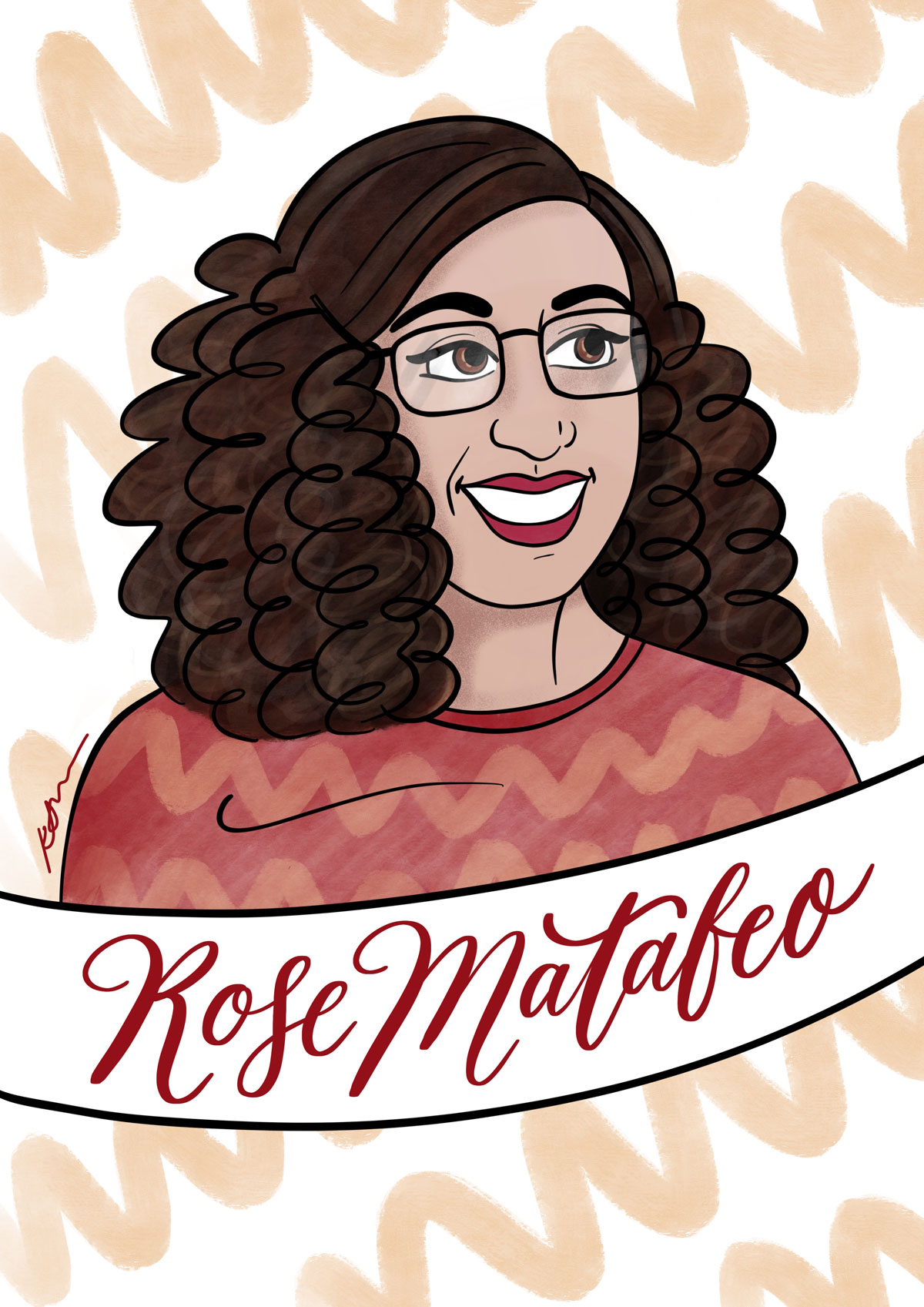
DAME SOPHIE PASCOE
PARALYMPIC SWIMMER
Dame Sophie Frances Pascoe, DNZM
b. 1993
Sophie is New Zealand's most successful Paralympian and the ultimate example of what you can do when you decide to make the most of life.
At two years old, Sophie was in an accident involving a ride-on lawnmower at her family's Christchurch property. As a result, her left leg was amputated below the knee, while the rear of her right leg was left with severe scarring. As a child, her parents encouraged her to give everything a go and Sophie has never let her disability hold her back.
Sophie started swimming at the age of seven and was soon offered the opportunity to train with the QEII Swim Club. This was the beginning of her swimming career and at just 15, Sophie competed at the Beijing 2008 Paralympic Games, becoming New Zealand's youngest Paralympian and the youngest ever New Zealander to win a medal. She has represented New Zealand at three summer Paralympic Games, winning nine gold medals and six silver medals.
In 2009 Sophie was made a Member of the New Zealand Order of Merit for her services to swimming. In 2016 she was awarded the Sport New Zealand Leadership Award at the Halbergs, and nominated for a prestigious Laureus Award. She was named as the flagbearer for the 2018 New Zealand Commonwealth Games Team on the Gold Coast, where she went on to win two gold medals.
Sophie competed at her fourth Paralympic games in Tokyo 2020 winning both a silver and a bronze medal.
In 2022 Sophie was promoted to Dame Companion of the New Zealand Order of Merit, for services to swimming.
"Yes, I'm different because I'm disabled. But I'm also different because I'm a world champion. Not many people can say that." - Sophie Pascoe
More to Read
Autobiography - Sophie Pascoe – Stroke of Fate
Bibliography
http://www.rebelsport.co.nz/whatsyourwhy-sophie
https://en.wikipedia.org/wiki/Sophie_Pascoe
http://www.paralympics.org.nz/Para-Athletes/Athlete-Profiles/Sophie-Pascoe

DAME FARAH PALMER
RUGBY ICON
Dame Farah Rangikoepa Palmer, DNZM
b. 1972
Ngāti Maniapoto, Ngāti Waiora, Waikato, Ngāti Mahuta
Once described as the most successful team captain in New Zealand sport, Farah is a global rugby icon who captained the Black Ferns to three consecutive World Cup titles. In her 35-test career, she was on the losing side just once.
Farah grew up in the small King Country town of Piopio. At school she was a keen sportswoman, playing netball competitively and participating in athletics, swimming, tennis, and cross-country. She began playing rugby while studying at the University of Otago. With a killer instinct and never-say-die attitude, she represented Otago, Waikato and Manawatu at provincial level before joining the Black Ferns in 1996. The following year she was named captain and went on to lead the team in 30 test matches.
Farah played for New Zealand for a decade and during that time achieved her doctorate and began lecturing at Massey University. She is highly regarded in academia for her expertise on Māori and gender issues in sport and for encouraging women and Māori to put themselves forward and achieve at the highest level.
In 2007 Farah became an Officer of the New Zealand Order of Merit (ONZM) for services to women's rugby and sport and in 2014 was one of the first women inducted into the World Rugby Hall of Fame. In 2016, the Women's Provincial Championship was renamed the Farah Palmer Cup and she became the first woman to be appointed to the board of New Zealand Rugby in its 124-year history.
In the 2023 New Year Honours, Farah was promoted to Dame Companion of the New Zealand Order of Merit, for services to sport, particularly rugby.
Bibliography
https://teara.govt.nz/en/photograph/40046/farah-palmer
http://www.allblacks.com/Player/Index/1156?team=Ferns
https://en.wikipedia.org/wiki/Farah_Palmer
https://web.archive.org/web/20081014095010/http://taiohi.co.nz/issue23/farah-palmer.html
https://www.odt.co.nz/sport/rugby/otago/influence-award-palmer

LORDE
GRAMMY AWARD-WINNING SINGER/SONGWRITER
Ella Marija Lani Yelich-O’Connor, aka Lorde
b. 1996
Lorde is a Grammy award-winning singer/songwriter whose level of international success surpasses any other New Zealand musician. Her fascination with royalty and the aristocracy influenced her stage name, and she soon began to write and perform as 'Lorde'. Lorde grew up in Devonport and her mother, who is a poet, encouraged her to read widely, which has strongly influenced her songwriting. Throughout her childhood she also listened to her parent’s favourite artists, including Cat Stevens, Fleetwood Mac and jazz and soul musicians Etta James and Billie Holiday.
At the age of 12 Lorde signed with Universal Music Group and began working with songwriter and record producer Joel Little. She released her debut record The Love Club EP as a free download at 16. Royals, her debut single from the EP, became an international phenomenon topping the charts globally. By 17 she was the youngest solo artist to achieve a number-one single on the US Billboard charts since the 1980s. A month later she released her debut full-length album, Pure Heroine.
In 2014 Lorde won Grammy Awards for Best Pop Solo Performance and Song of the Year for Royals. Royals also won the MTV Video Music Award for best rock video, making Lorde the first female artist in MTV history to win in that category.
Lorde’s music, vision and artistic execution continues to be original and authentic and in 2017 her album Melodrama earned a Grammy nomination for Album of the Year.
Bibliography
https://en.wikipedia.org/wiki/Lorde
https://www.britannica.com/biography/Lorde
https://www.allmusic.com/artist/lorde-mn0003085111/biography
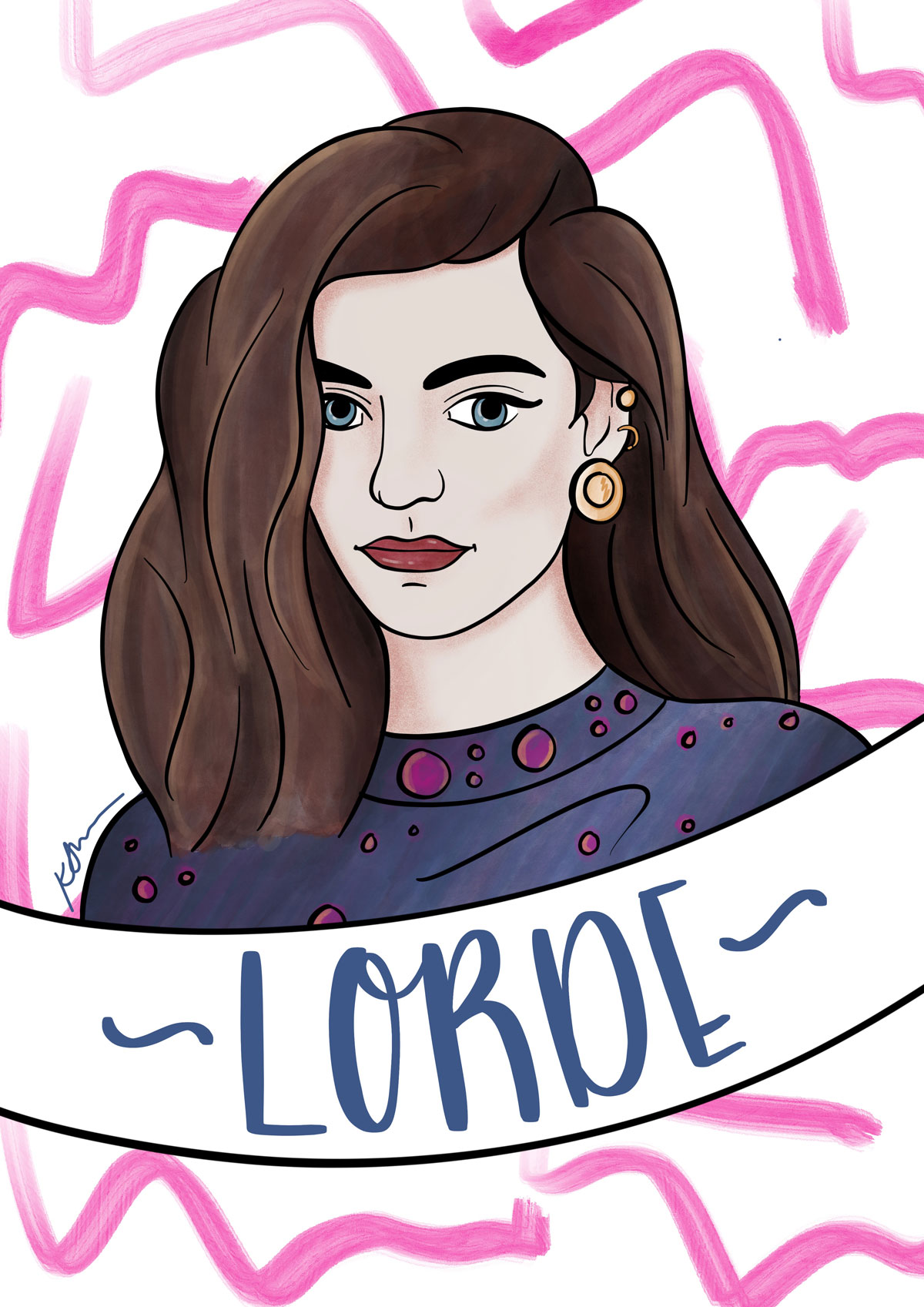
LYDIA KO
GOLFER
Bo-Gyung "Lydia" Ko
b. 1997
At just 17 years old, Lydia became the youngest professional golfer to be ranked number one in the world. Born in Seoul, South Korea, Lydia moved to New Zealand with her family when she was six. The previous year Lydia’s aunt had given her a 7-iron and putter, which she started to play with. Her father would take her to the driving range and people began to notice the young girl hitting balls. Her mother asked a professional to teach her but was told Lydia was too young. That didn’t stop Lydia and she was competing in New Zealand amateur championships by the time she was seven. She has been making international sporting history ever since.
At 15 Lydia became the youngest winner on the LPGA Tour when she took the Canadian Open title, and in 2013 she became the youngest golfer in history to win the New Zealand Women’s Open. After winning back-to-back LPGA championships as an amateur, the LPGA waived its age limit of 18 to allow the 16-year-old Lydia to join the professional tour.
In 2015, 18-year-old Lydia won The Evian Championship in France, making her the youngest woman to win a major championship. A year later she won a silver medal at the 2016 Rio Olympics and was named Young New Zealander of the Year.
Lydia trains for more than 35 hours a week and, due to her achievements and relaxed playing style, she has been hailed as the greatest young golfer – male or female – ever to have played the game.
Bibliography
http://www.lpga.com/players/lydia-ko/98109/bio
https://en.wikipedia.org/wiki/Lydia_Ko
https://media.newzealand.com/en/story-ideas/new-zealand-golfer-lydia-ko/
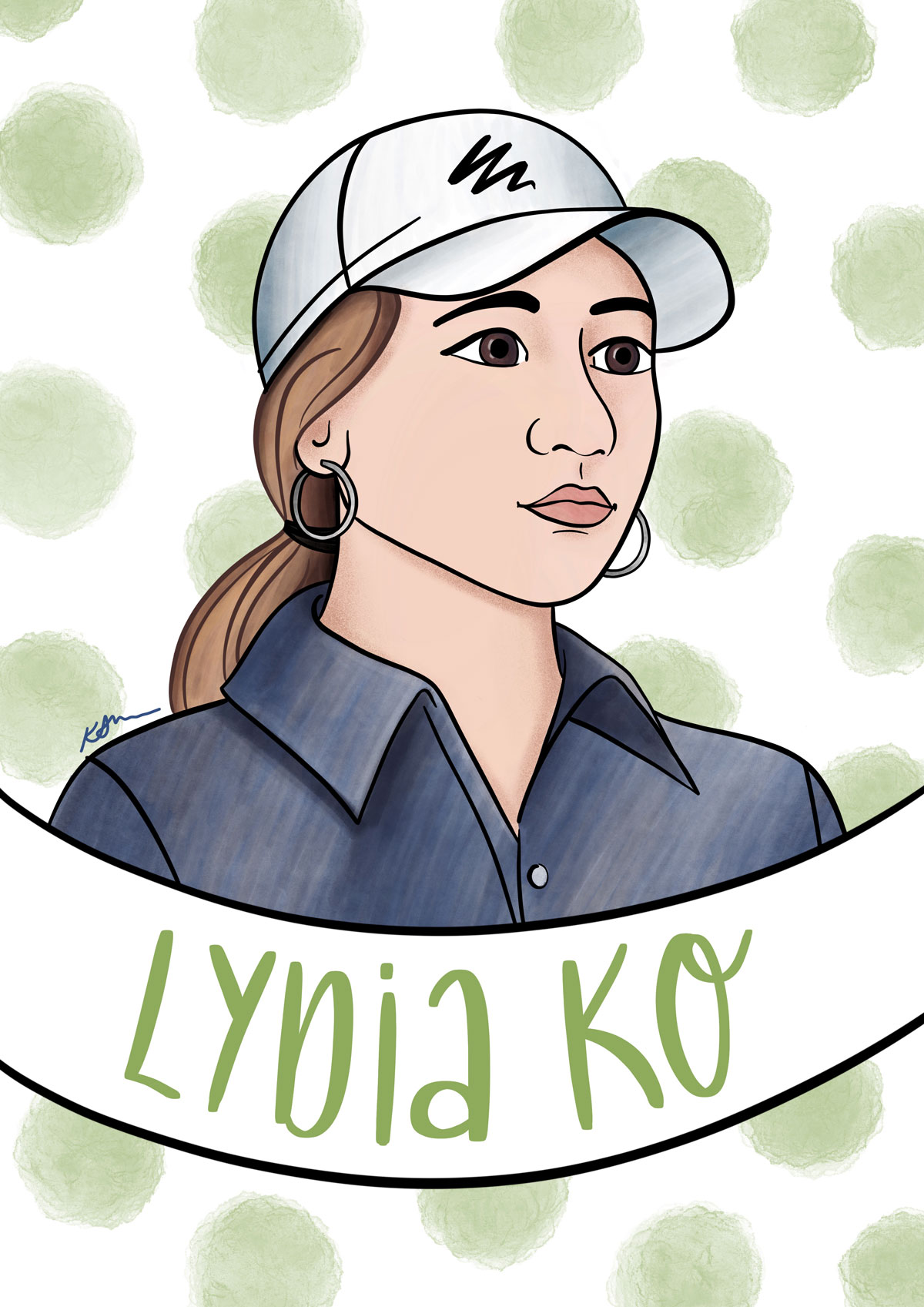
DIGGERESS TE KANAWA
TOHUNGA RARANGA (MASTER WEAVER)
Diggeress Rangituatahi Te Kanawa CNZM QSO
1920 - 2009
Ngāti Maniapoto, Ngāti Kinohaku
All her life Diggeress worked with muku (flax fibre) and she became one of New Zealand’s premier artists and most renowned weavers. She grew up in Oparure, daughter of Taonui Hetet and Dame Rangimarie Hetet, also a tohunga raranga. Her father named her in honour of the WWI army trench diggers.
Diggeress learned traditional weaving from her mother and completed her first piupiu (flax skirt) at 14. Together they led the revival of Māori weaving in the 1950s.
Softly spoken and generous with her time, Diggeress was an inspirational teacher and known for her humility, aroha and commitment. She had outstanding design skills and was an expert in preparing harakeke (flax) and using earthen dyes. In 1992 she wrote Weaving a Kakahu, detailing the process of weaving a feathered cloak. Diggeress exhibited internationally and her work was gifted to many dignitaries, including Sir Henry Ngata, the Queen of Denmark, Queen Elizabeth II, and Māori King Tuheitia Paki.
Diggeress married Tana Te Kanawa and they raised 12 children, many of whom became acclaimed artists. She made each of her children a cloak reflecting their personality and these are held in trust at the Waikato Museum.
In 2000 Diggeress was made a Companion of the New Zealand Order of Merit and in 2002 she became a New Zealand ‘Icon Artist’. In 2005 she received the Māori Arts Board premier award, Te Tohu Tikitike o Te Waka Toi, recognising her Lifetime Commitment to Maori Weaving, and in 2007 Diggeress received an honorary doctorate from University of Waikato for her dedication to the craft.
Puritia ngā taonga a ō tātou tūpuna
(Hold fast to the treasures of our ancestors)
– a proverb Diggeress chose to live by
More to Read
Te aho tapu / the sacred thread – Diggeress Te Kanawa. Exhibition guide. Waikato Museum of Art and History, 2004.
Weaving a Kakahu – Diggeress Te Kanawa. Reprinted by Puwaha ki te Ao Trust, 2006
More to Watch
https://www.hetetschoolofmaoriart.com/blog/rangimarie-hetet-diggeress-te-kanawa-with-kahu-te-kanawa
Rangimarie Hetet & Diggeress Te Kanawa with Kahu Te Kanawa
Interviews August 15, 2017 A short film from Te Ara Encyclopaedia of New Zealand featuring Rangimarie Hetet, her daughter Diggeress Te Kanawa, and granddaughter Kahu Te Kanawa. Erenora Puketapu-Hetet and daughter Kataraina appear briefly at the end.
Aku Mahi Whatu Māori –1972 – produced by Barry Barclay, features Diggeress and Rangimarie and is about weaving a korowai.
Bibliography
https://www.thearts.co.nz/artists/diggeress-rangituatahi-te-kanawa
http://www.stuff.co.nz/national/2709479/Icon-artist-Diggeress-Te-Kanawa-dies
https://collections.tepapa.govt.nz/topic/3652
https://www.komako.org.nz/person/1156
http://www.stuff.co.nz/waikato-times/news/15866/High-university-honour-for-Diggeress

PARRIS GOEBEL
DANCER. CHOREOGRAPHER. DIRECTOR.
Parris Renee Goebel
b. 1991
Bold, colourful and downright fearless, Parris has conquered the world stage as an award-winning dancer, choreographer and director.
Born and raised in Manurewa, her childhood was full of music and as soon as she could walk Parris was dancing to everything from Michael Jackson to Toni Braxton. Early on her dad recognised school wasn’t going to take Parris where she wanted to go, so at age 15 he pulled her out of school to help her pursue her dream of being a dancer. Around this time Parris formed the ReQuest dance group with four female friends. ReQuest went on to win back-to-back gold medals at the HHI World Hip Hop Dance Championships in Las Vegas, putting them on the international map.
At 17 she opened The Palace Dance Studio in Penrose, where dancers – especially females – could take hip hop seriously and work towards a career in dance. The Palace has since become one of the most respected hip hop studios in the world. Six dance crews operate out of The Palace – ReQuest, Sorority, Bubblegum, Royal Family, Royal Family Varsity and Kingsmen – all of which have won multiple international hip hop championships.
Parris has worked with multiple international artists including Justin Bieber, Rihanna, Janet Jackson, Jennifer Lopez and Nicki Minaj. She has choreographed routines and starred in music videos, movies and large-scale performances.
Parris continues to teach throughout the US, Europe, Asia, Australia and New Zealand. Together with her sisters, Kendal and Narelle, Parris also runs Sisters United – an organisation that helps empower young women through the creative arts.
“So girls, the moral of the story is: you’ve got to believe in yourselves. Whatever you aspire towards, you can achieve it. Be courageous, put yourself out there and don’t ever let anyone tell you it’s not possible to achieve your goal, because they will try.” – Parris Goebel
More to Read
Young Queen by Parris Goebel
Bibliography
Young Queen by Parris Goebel, Mary Egan Publishing 2018
http://www.thearts.co.nz/artists/parris-goebel
http://www.parachutemusic.com/blog-main/how-parris-goebel-her-sisters-are-helping-young-women
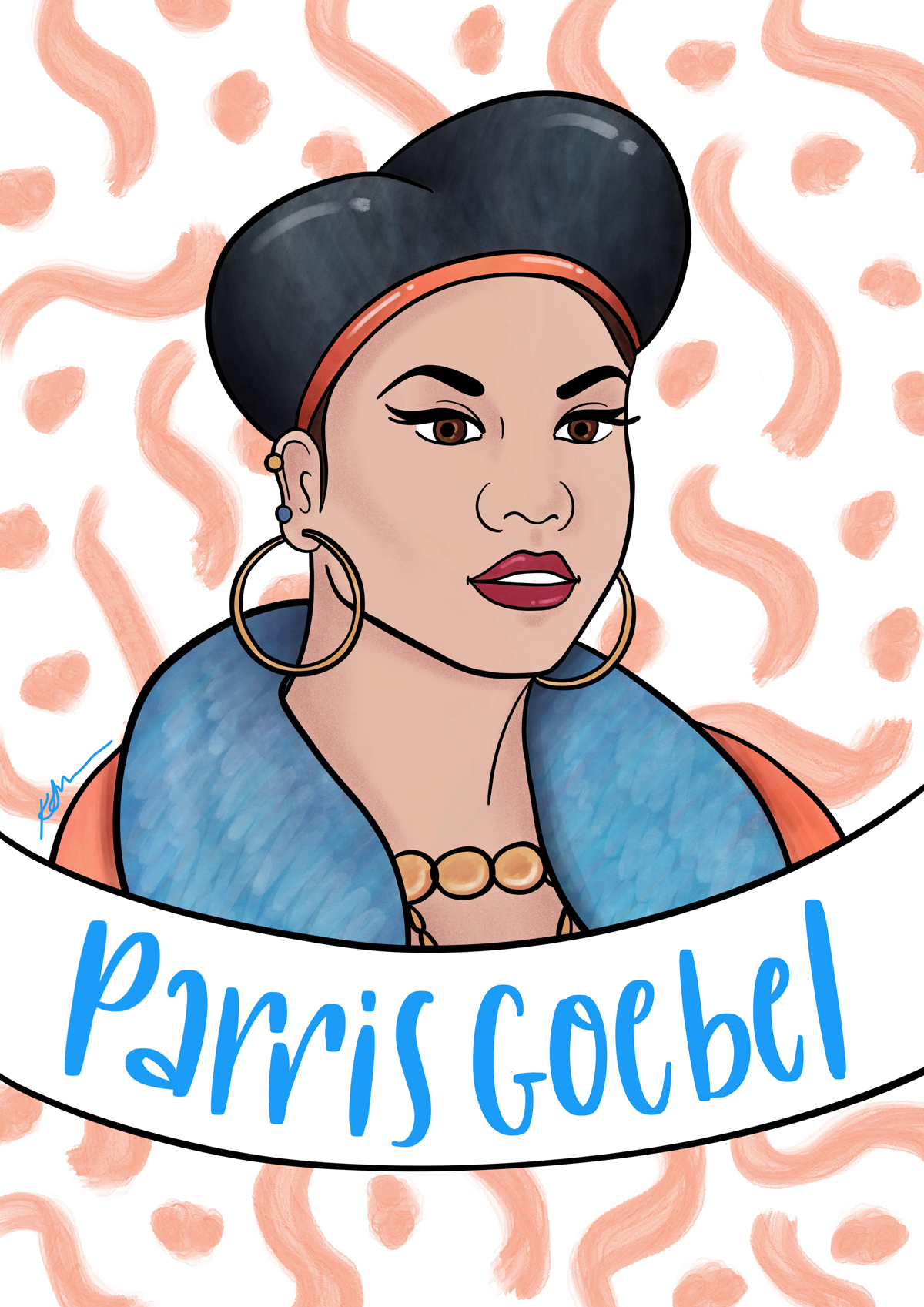
GEORGINA BEYER
WORLD’S FIRST TRANSGENDER MAYOR AND MP
Georgina Beyer
b. 1957
Te Āti Awa, Ngāti Mutunga, Ngāti Raukawa, Ngāti Porou
Georgina lived many different lives before becoming the world’s first transgender mayor and Member of Parliament. She is one of very few former sex workers to hold public office and has changed attitudes by living a proud and public life as a transgender woman.
Born George Bertrand and assigned as a male at birth, she left school at 16 and became part of the Wellington gay nightclub scene as a singer, drag queen performer and then a sex worker. Georgina had gender reassignment surgery in 1984, burning all her old belongings the night before she transitioned. Three years later she was nominated for a GOFTA award for her role as a transgender prostitute, in the movie Jewels Darl.
In 1995, the relatively conservative town of Carterton voted her in as mayor and in 1999 she won the staunchly National seat of Wairarapa for Labour. She was known for her rousing, often unscripted parliamentary speeches and it was such a speech that secured three key votes to ensure the passing of legislation to decriminalise sex work in 2003. When she left Parliament in 2007, Georgina said she was proud of her contribution to the Prostitution Reform Act and the Civil Union Bill, though she regretted supporting the Foreshore and Seabed legislation. After several years on dialysis and a kidney transplant in 2017, Georgina is now in good health. She has been invited to the Oxford Union in October 2018 to speak about her experience as a public figure.
“You have to remember: law is easy to change, attitudes throughout a country are not. It takes generations and role models to show the nation that we’re not the horrible, demented, crazy people they might think we are.” – Georgina Beyer, 2018
More to Watch:
Jewels Darl - https://www.nzonscreen.com/title/about-face-jewels-darl-1985 Georgie Girl - https://www.nzonscreen.com/title/georgie-girl-2001-
Bibliography
https://www.stuff.co.nz/national/politics/105515701/Former-politician-Georgina-Beyer-invited-to-speak-at-the-Oxford-Union
https://thespinoff.co.nz/society/14-02-2018/georgina-beyer-still-has-a-fire-in-her-belly/ https://sites.google.com/site/aotearoawomen/home/1
https://en.wikipedia.org/wiki/Georgina_Beyer
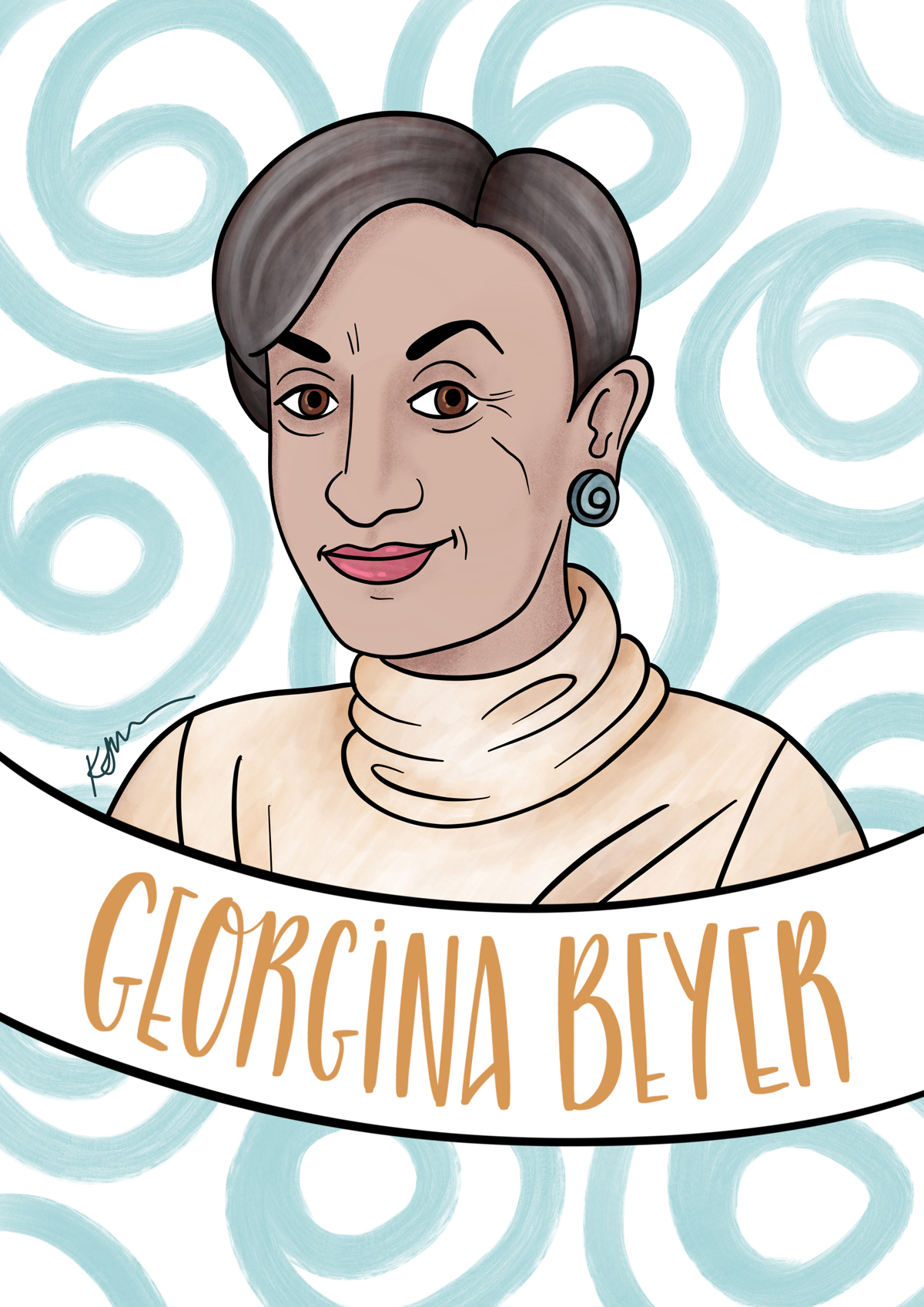
ANNA PAQUIN
ACADEMY AWARD-WINNING ACTOR
Anna Helene Paquin
b. 1982
At just 11 years old, Anna became the first New Zealander to win an Academy Award for acting. Originally born in Winnipeg, Manitoba, Anna moved to New Zealand with her family at age four. Based in Wellington, Anna was a keen musician playing the viola, cello and piano.
She leapt into her stage debut at age seven playing a skunk. As a child, being an actress was not her main goal. Anna had ambitions to be Prime Minister of New Zealand! However, at age nine, she followed her sister to an open casting call for a new movie directed by Jane Campion. With no professional acting experience (except for her role as a skunk) Anna beat out 5000 other young girls to win the part of Flora McGrath in The Piano.
Her performance as the daughter of a mute woman in this dark and haunting film received strong reviews. In 1993 she received the Academy Award for Best Supporting Actress, making her the second-youngest Academy Award winner in Oscar history. Anna remains the only New Zealand woman to receive an Academy Award for acting.
After the divorce of her parents, Anna moved to Los Angeles with her mother and siblings. It was here she went on to have a successful career as a child actress, appearing in several films including Fly Away Home and Jane Eyre. Since then she has successfully made the difficult transition from child actor to adult actor in both film and television. She continues to live and work in Los Angeles with her husband and children.
Bibliography
https://nzhistory.govt.nz/page/kiwis-win-oscars-piano

DAME MIRA SZÁSZY
MĀORI LEADER. EDUCATOR.
Miraka (Mira) Raharuhi Petrecevich Szászy DBE
1921 - 2001
Ngāti Kurī, Te Aupouri, Te Rarawa
Her dedication to elevating the status of Māori women and improving Māori education made Dame Mira one of the most outstanding New Zealand women leaders of the 20th century.
She was born in Te Tiriki, Northland to Lovre Petricevich (a Dalmation gumdigger) and Makareta Raharuhi. Her husband, Albert Szászy, was of Hungarian descent.
Dame Mira attended high school in Auckland and was one of 65 Māori trainee teachers in the early 1940s. She wrote directly to Prime Minister Peter Fraser requesting an education bursary so she could finish her Education degree. This was granted and, in 1945, Dame Mira became the first Māori woman graduate from the University of Auckland. In 1949 she completed a Diploma in Social Science at the University of Hawaii. She was one of the first Māori welfare officers and then taught in primary and secondary schools for 30 years.
Dame Mira was the first secretary of Te Rōpū Wahine Māori Toko i te Ora (Māori Women’s Welfare League) and became the league’s president in the mid-1970s. She was active on boards and advisory committees working to improve education for Māori. She exposed sexism in Māoridom, fought for speaking rights for women on the marae and urged Māori women to stand for public office.
She was made a Dame Commander of the Order of the British Empire in 1990. In 1998 the University of Auckland established The Mira Szászy Research Centre, the first dedicated Māori and Pacific research facility in business and economics. She died at Ngataki aged 80.
“I don’t believe that giving women their rights as human beings is a destructive thing. I think it is a very positive thing and I believe that the liberation of every human being is part of the development of human society as a whole.” – Dame Mira Szászy
Bibliography
A History of New Zealand Women, Barbara Brookes Bridget Williams Books, 2016
https://suffrage125science.auckland.ac.nz/
https://teara.govt.nz/en/biographies/6s2/szaszy-miraka

DAME ALISON HOLST
FOOD WRITER AND TV CHEF
Dame Alison Margaret Holst DNZM
b. 1938
For more than 40 years, Dame Alison was New Zealand’s leading television chef and food writer. Since 1966, she has sold 4.5 million copies of her 100 different recipe books, some written in collaboration with her son, Simon. Her recipes focus on ‘everyday food for home cooks’ that is nutritious, reasonably cheap and quick and easy to make.
Dame Alison graduated from the University of Otago with a Bachelor of Home Science and then trained as a teacher. She was teaching at the Home Science School in Dunedin when the NZBC (now TVNZ) asked her to front a new television programme, Here’s How. They wanted her to teach New Zealanders how to cook real family meals. There was no one to teach her the role of a presenter so she borrowed a book from the library and, in 1965, Dame Alison became New Zealand’s first female television chef. At the time she had no idea of the impact her friendly, unassuming style would have on at least three generations of home cooks.
Dame Alison’s popular cooking fundraisers raised more than $4 million for Plunket, playcentres, schools and kindergartens, and she energetically promoted New Zealand lamb and beef overseas.
In 1997 Dame Alison was awarded a Doctorate of Science from the University of Otago and, in 2011, she was appointed a Dame Companion of the New Zealand Order of Merit for services to the food industry.
“I hope I have helped New Zealand women, because they are hardworking and they fit an awful lot into the day” – Dame Alison Holst
More to Watch
A Homegrown Cook: The Dame Alison Host Story https://www.youtube.com/watch?v=zo1ivMcKTAA
More to Read
A Home-grown Cook: The Dame Alison Holst Story by Alison Holst (Hyndman Publishing, 2011)
Bibliography
https://en.wikipedia.org/wiki/Alison_Holst
http://www.nzherald.co.nz/nz/news/article.cfm?c_id=1&objectid=10697227
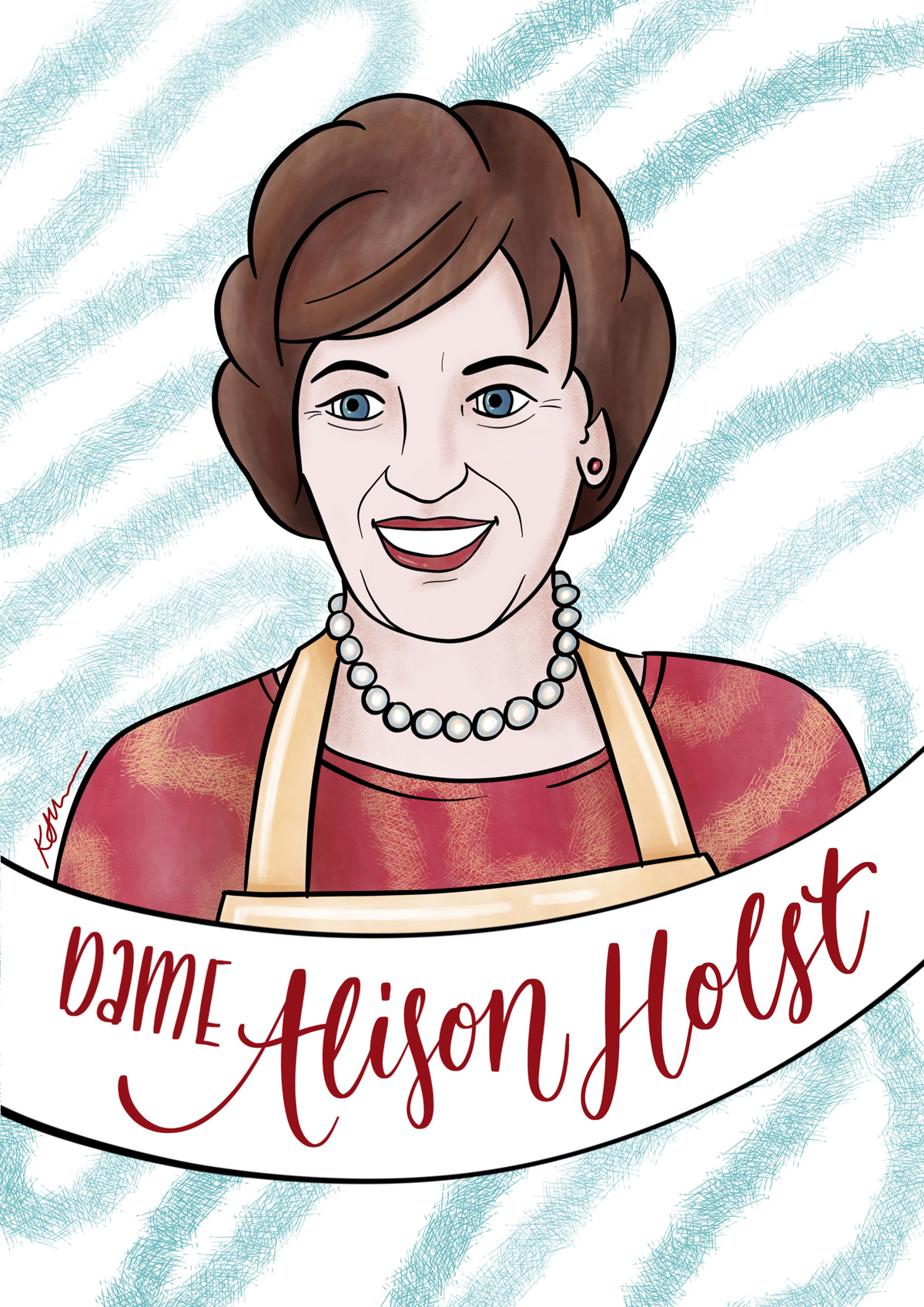
ELIZABETH GUNN
FOUNDER OF NZ HEALTH CAMPS
Dr. Elizabeth (Lizzie) Catherine Gunn MBE
1879 – 1963
For almost 50 years Elizabeth worked to improve the health of New Zealand children. Her most innovative initiative was setting up the country’s first health camp in 1919.
After finishing at Otago Girls’ High School, Elizabeth trained as a doctor in Edinburgh, returning to New Zealand in 1912 to join the NZ School Medical Service. She had to petition the Prime Minister, William Massey, to be allowed to serve in the NZ Army Medical Corp during WWI.
After the war, Elizabeth began a legendary 30 years of service in the Whanganui- Manawatu School Medical Service. She was autocratic and forthright and she got things done. On occasion she would rather tactlessly and loudly criticise a mother’s parenting ability but many had great respect for her advice. She was the first school doctor to invite parents to medical inspections, she set up ‘toothbrush drills’ and introduced milk in schools long before it became government policy. During the depression she provided many local children with school uniforms.
Elizabeth usually dressed in a grey suit, white shirt and tie, and often proudly wore her WWI medals. Her first health camp was a ‘canvas camp’ on a farm in Turakina. She ran it with military precision, providing malnourished, disadvantaged and asthmatic children with rest, fresh air, exercise and good food.
Elizabeth retired from public service in 1940 but continued as a private practice paediatrician for many more years. She was appointed a Member of the British Empire in 1951.
Bibliography
Margaret Tennant. 'Gunn, Elizabeth Catherine', Dictionary of New Zealand Biography, first published in 1996. Te Ara - the Encyclopedia of New Zealand, https://teara.govt.nz/en/biographies/3g24/gunn-elizabeth-catherine
https://en.wikipedia.org/wiki/Elizabeth_Gunn_(paediatrician)
https://www.standforchildren.org.nz/whakapapa/
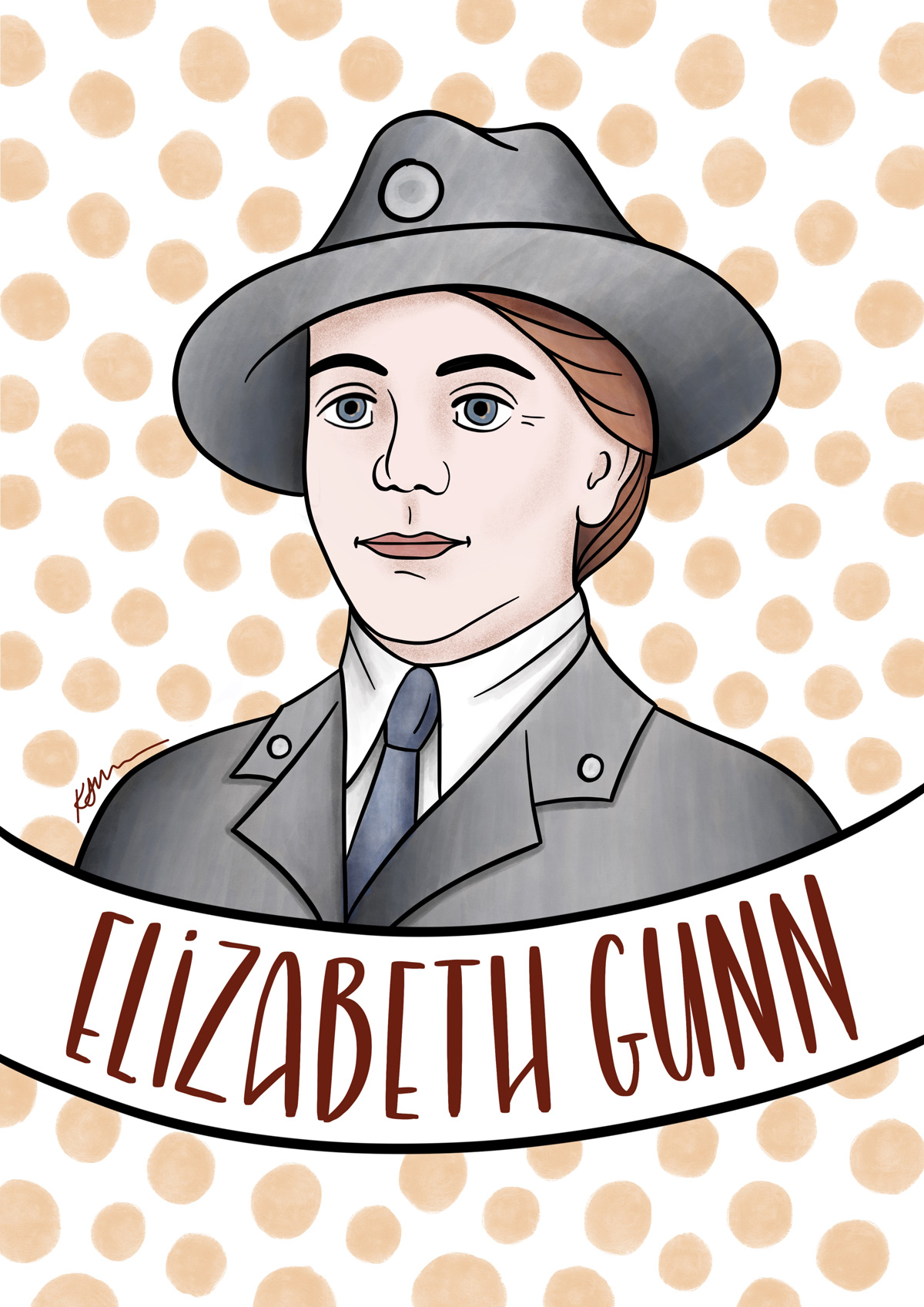
KATE EDGER
FIRST NEW ZEALAND FEMALE UNIVERSITY GRADUATE
Kate Milligan Evans née Edger
1857 – 1935
In July 1877, Kate was awarded a Bachelor of Arts degree in mathematics and Latin from the University of New Zealand, becoming the first New Zealand female university graduate and the first woman in the British Empire to be awarded a Bachelor of Arts degree.
She was 16 when her clergyman father arranged for her to study with the top boy’s class at Auckland College and Grammar school because there was no secondary school for girls. She gained a university scholarship and, on graduating, became first assistant at Christchurch Girls High School and completed her Master of Arts at Canterbury College. At 26, Kate was appointed foundation headmistress for Nelson Girls’ College. Slightly built, quiet and reserved, she was a passionate and gifted teacher. She had great physical stamina and, for seven years, she worked with characteristic determination to establish a school that provided a first-class education for girls. At 33, she married Welsh clergyman William Evans. On moving to Wellington, her husband embarked on unpaid community work and Kate supported their family of three young sons by running a small private school in their home.
All her life Kate was active in public life as a suffragist, as President and Vice President of the Wellington branch of the New Zealand Society for the Protection of Women and Children for 30 years, and as dominion secretary of the League of Nations of New Zealand.
Today the Kate Edger Educational Charitable Trust annually presents over 100 financial awards to help women fulfil their educational goals.
Bibliography
Unpretending Excellence: A Life of Kate Edger, Katrina Ford. The Kate Edger Charitable Trust, 2017
https://en.wikipedia.org/wiki/Kate_Edger
'Kate Edger', URL: https://nzhistory.govt.nz/people/kate-edger, (Ministry for Culture and Heritage), updated 8-Nov-2017
Beryl Hughes. 'Edger, Kate Milligan', Dictionary of New Zealand Biography, first published in 1993. Te Ara - the Encyclopedia of New Zealand, https://teara.govt.nz/en/biographies/2e3/edger-kate-milligan
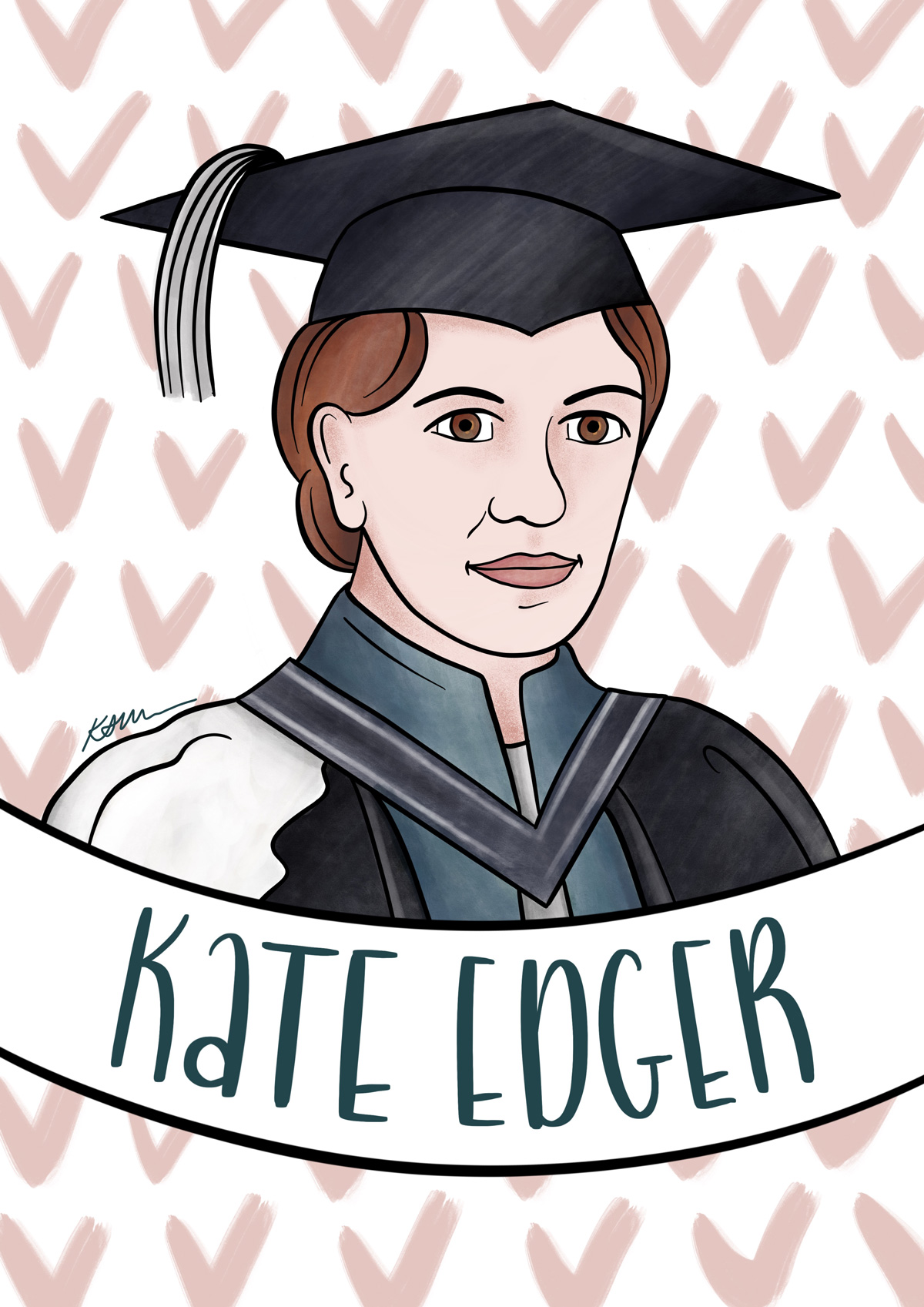
JUDY BAILEY
TELEVISION NEWS PRESENTER - ‘MOTHER OF THE NATION’
Judy Ann Bailey ONZM
b. 1953
Her career at TVNZ spanned 30 years and the title ‘Mother of the Nation’ affectionately described Judy’s 18-year role as a 6pm newsreader on TV One. She is New Zealand’s longest serving news presenter and, for Judy, the highlight of that job was bringing moments of history into people’s living rooms night after night.
After graduating as a journalist, Judy was determined to secure a job with the NZBC (which later became TVNZ). She had decided nothing less would do and, in 1971, she joined the NZBC as a radio and television reporter. In 1980, she began the first of two long co-presenting partnerships. For nine years Judy presented the regional news on Top Half with John Hawkesby, their easy banter brightening the dullest news. On moving to the 6pm Network News on TV One, Judy was joined by Richard Long for a hugely popular 15-year news reading partnership. Judy became a sole newsreader in 2004 and she left TVNZ a year later saying an emotional goodbye to the nation on December 23, 2015.
For many years Judy has worked tirelessly as patron of several charities including North Shore Hospice, Women’s Refuge and the Muscular Dystrophy Association. She is a trustee, educator and advisor for the Brainwave Trust Aotearoa. In 2010, Judy was appointed an Officer of the New Zealand Order of Merit for her services to broadcasting and the community.
More to read
My Own Words by Judy Bailey (Penguin, 2006)
Bibliography
https://www.nzonscreen.com/person/judy-bailey
http://www.brainwave.org.nz/who-we-are/our-people/governance/judy-bailey-onzm-dipjourn/
http://www.nzherald.co.nz/nz/news/article.cfm?c_id=1&objectid=10348638
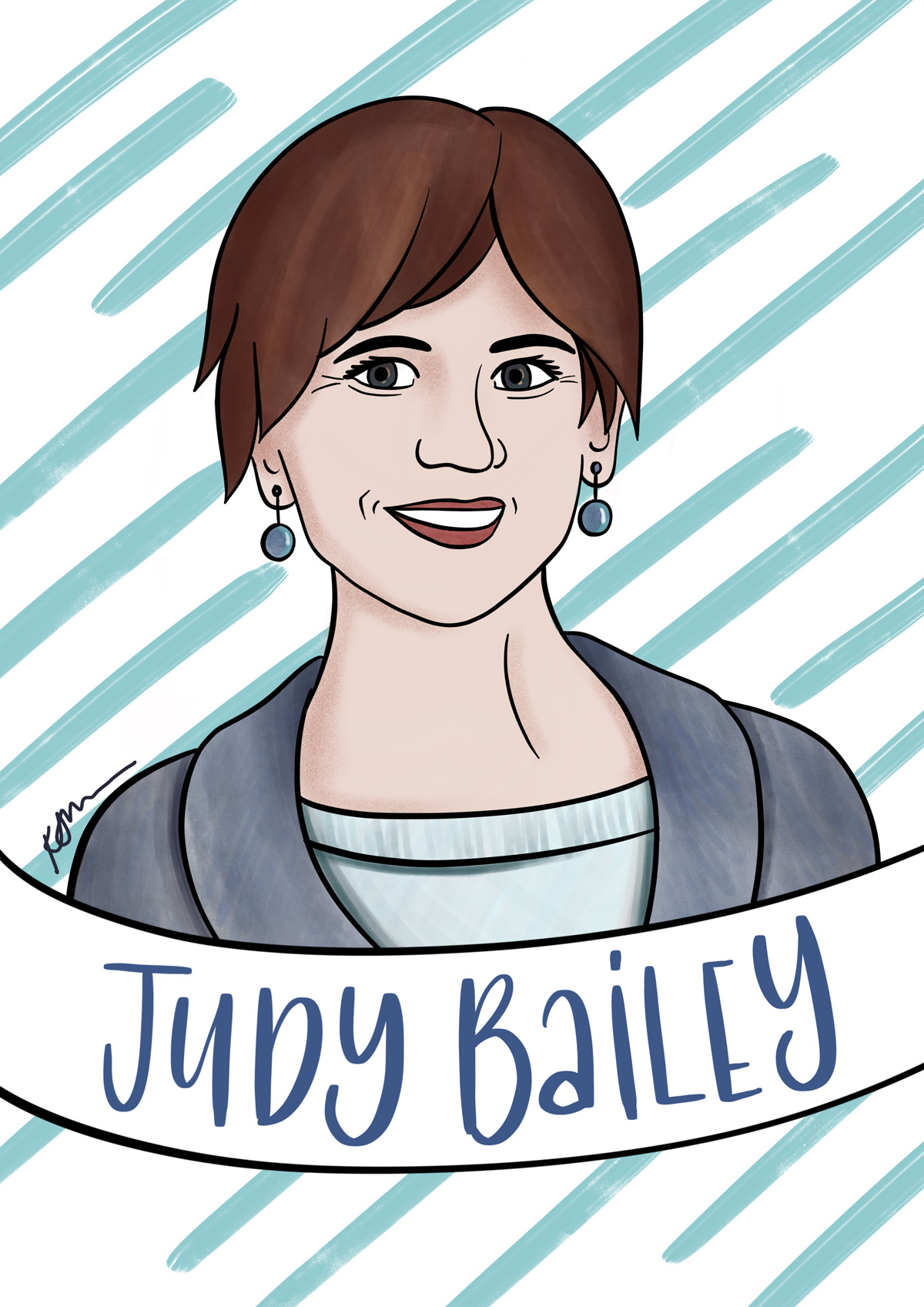
Whetū Tirikātene-Sullivan
FIRST FEMALE MĀORI CABINET MINISTER
Hon Dr. Whetū Marama Tirikātene-Sullivan ONZ
1932 – 2011
Ngāi Tahu, Ngāti Kahungunu
For 29 years Whetū served her people as a trailblazing Member of Parliament for southern Māori. In 1967, she cut short her academic career to enter politics following the death of her father, long serving MP Sir Eruera Tirikātene. In 1972, Whetū became Minister for Tourism, the first female Maori cabinet minister, and the only woman in cabinet. She was a pioneer in the fight for women’s rights and the first New Zealand politician to be pregnant during the parliamentary session. To ensure no one doubted her ability to continue in politics she returned to parliament six days after her baby was born by caesarean section. Whetū strongly advocated for Te Reo and her passionate support for Māori lead to advances in the establishment of the Waitangi Tribunal, Māori and Papakāinga Housing and Māori Broadcasting, and she successfully battled to retain the Māori seats under MMP.
Born at Ratana Pa, Whetū trained in social work, then political science at Victoria, University of Wellington. All her life she was a committed member of the Rātana Church and a staunch supporter of the Māori Women’s Welfare League.
Whetū was an accomplished fencer and a New Zealand title holder in ballroom and Latin American dancing. She supported Māori artists and designers and had a great sense of style, often wearing long flowing gowns decorated with dramatic koru prints.
In 1993, Whetū was made a Member of the Order of New Zealand recognising her outstanding service to the Crown and the people of New Zealand.
Bibliography
A History of New Zealand Women by Barbara Brookes (Bridget Williams Books, 2016)
https://www.dpmc.govt.nz/honours/recipients/tirikatene-sullivan-honourable-mrs-tini-whetu-marama-onz
https://www.radionz.co.nz/news/political/80675/whetu-tirikatene-sullivan-dies
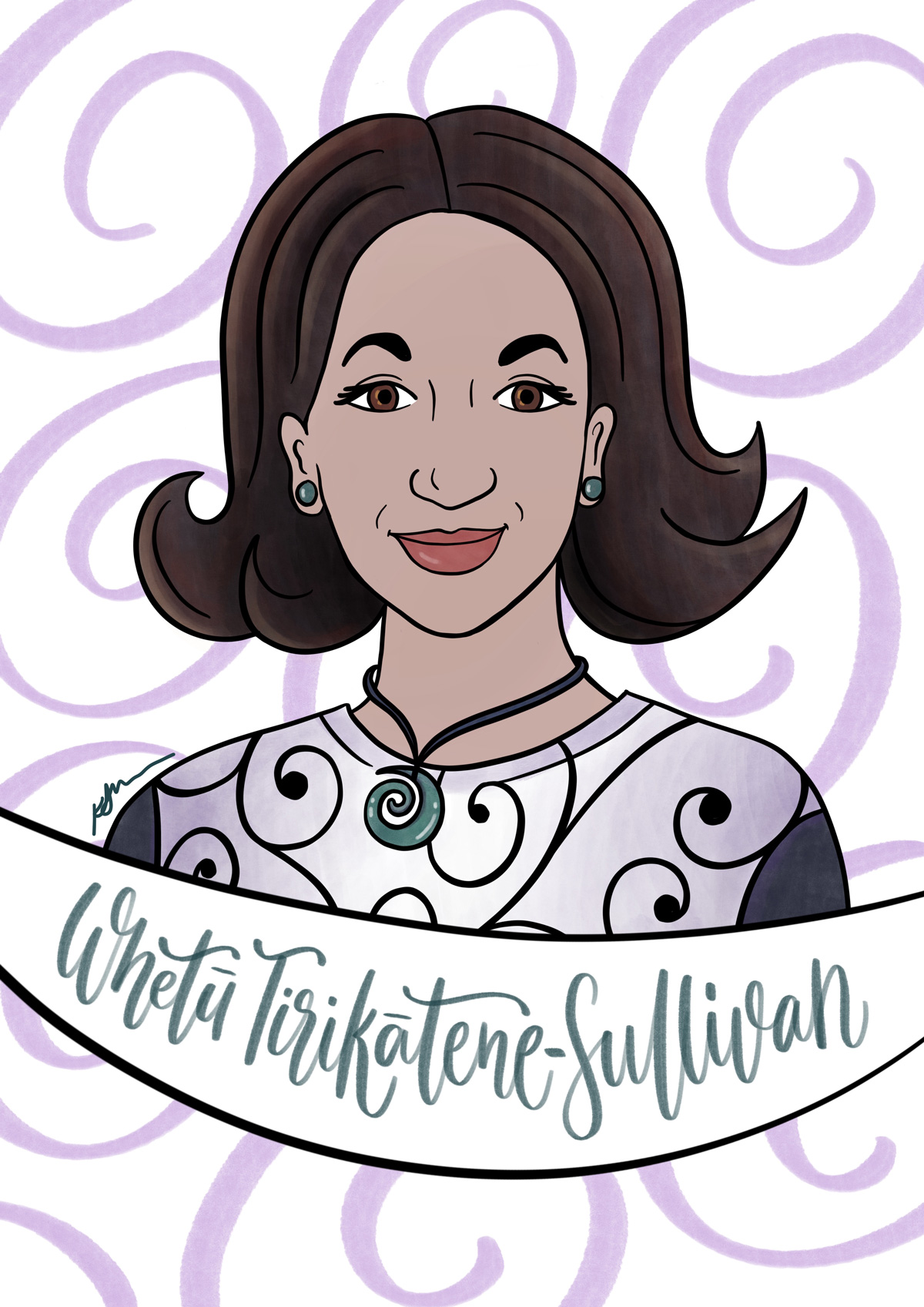
Dame Luamanuvao Winnie Laban
FIRST FEMALE PACIFIC ISLAND MEMBER OF PARLIAMENT
Hon Dame Luamanuvao Winifred Alexandra Laban DNZM, QSO
b. 1955
Dame Winnie became the first Pacific Island woman in the New Zealand Parliament when in 1999 she was selected as a Labour list MP. She went on to become Minister of Pacific Island Affairs and Minister for the Community and Voluntary Sector. Dame Winnie’s parents migrated to New Zealand from Samoa in the early 1950s. They instilled in her the belief that family, relationships and education were the key to success and happiness, and Dame Winnie has advocated tirelessly for social justice and improved opportunities for the Pacific community.
She has lived most of her life in Wainuiomata and attended Wellington Girls’ College and Erskine College. After graduating from Victoria University of Wellington with a degree in social work, Dame Winnie worked as a family therapist, probation officer, school councillor, and in community development. In 1992, the Samoan village of Vaiala, Vaimauga, bestowed the matai chiefly title Luamanuvao on her, in recognition of her work with the Pacific Island community in New Zealand.
Dame Winnie has held the position of Assistant Vice-Chancellor (Pasifika) of Victoria University of Wellington since 2010. She is also a member of the Arts Board of Creative New Zealand and patron of organisations as diverse as the New Zealand Cancer Society Relay for Life, the Wellington Pasifika Business Network, and the Wellington Warriors.
In 2018 Dame Winnie was made a Dame Companion of the New Zealand Order of Merit (DCNZ) for her services to education and the Pacific Community.
“It is important to work hard, to study and learn, to find your bliss in education.” - Hon Dame Luamanuvao Winnie Laban
Bibliography
https://www.infonews.co.nz/profile.cfm?id=816
https://www.pressreader.com/new-zealand/the-new-zealand-herald/20180604/281663960694562
https://www.radionz.co.nz/national/programmes/queensbirthday/audio/2018647765/dame-winnie-laban
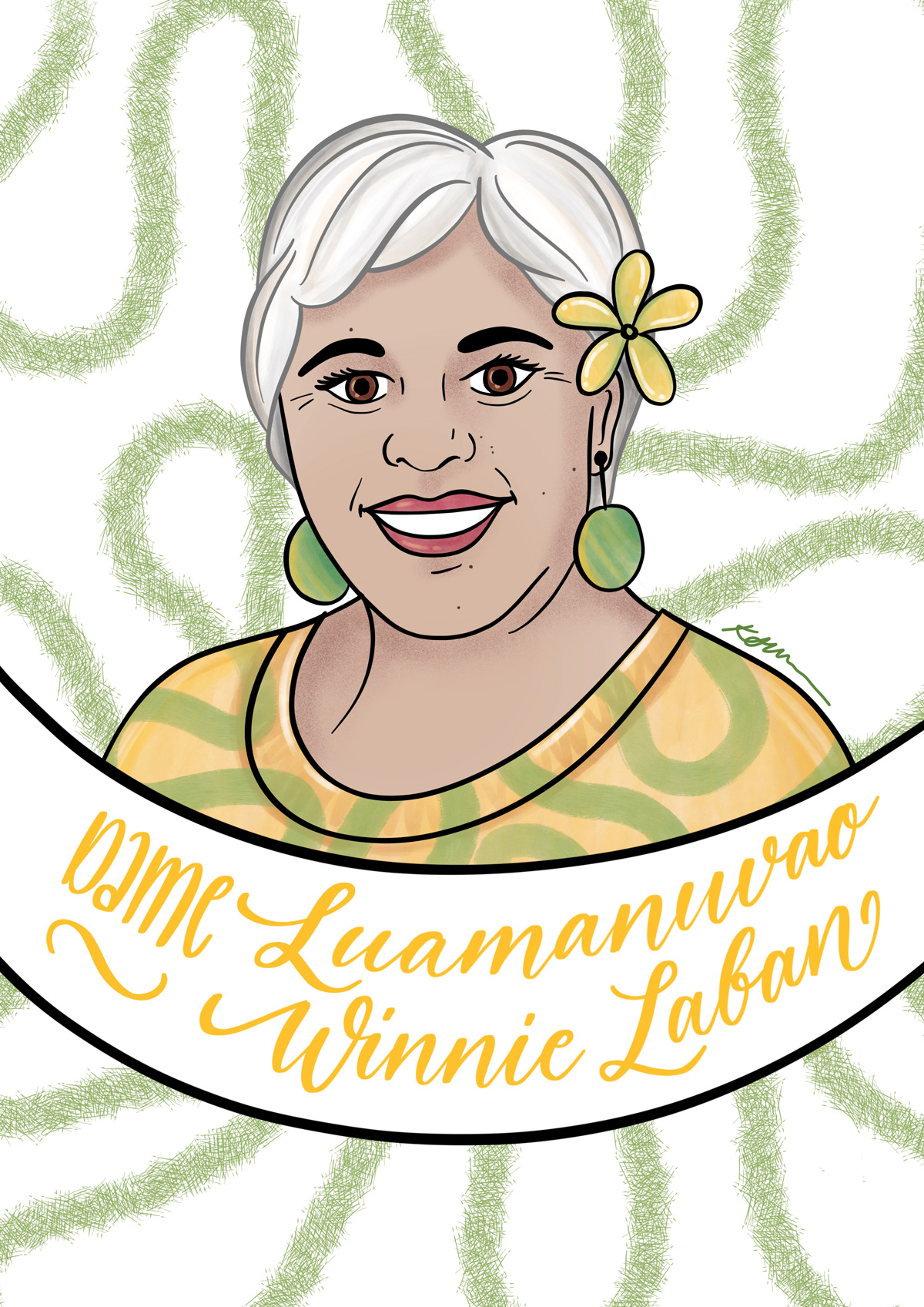
JANE MARIA ATKINSON
PIONEER. LETTER WRITER. COMMUNITY LEADER
Jane Maria Atkinson
1824 - 1914
Jane Maria was born and raised in England, where she felt she had nothing useful to do. She was 29 when she arrived in New Plymouth with a "mob" of inter-related Richmonds, Atkinsons and Hursthouses. Maria (as she preferred to be called), brought with her the Unitarian values of free thought, high principles and intellectual integrity that she had grown up with. On the voyage to New Zealand she met her future husband Arthur, who was nine years her junior. They shared an unstoppable energy for colonial life and their marriage was a surprisingly equal union for the time, each keeping some personal independence. Though pioneer life was initially hard, Maria relished the absence of servants and the freedom to explore the outdoors. She was the first woman to climb Mt Taranaki – although she had gone along just to cook.
Maria became a prominent member of the Nelson community after moving to the South Island with Arthur in 1867, setting up a family school, running a debating team, supporting the Temperance Union and promoting women’s suffrage. She was a passionate supporter of education for women and in 1877 returned to England to help younger family members complete their education. On her return four years later, she campaigned for the establishment of Nelson College for Girls, which opened in 1883.
Maria was intelligent, articulate and a prolific letter writer. She had a perceptive eye for colonial life and her 60 years of correspondence provides a unique picture of the life of a pioneer woman in New Zealand.
“The most solidly educated women are the most useful in every department of life, and that so-called ‘feminine refinement’ is fatal to female usefulness.” - Maria Atkinson, 1870
More to read
Born to New Zealand: a biography of Jane Maria Atkinson, by Frances Porter. BWB Bridget Williams Books, Wellington, 1995
Bibliography
The Book of New Zealand Women / Ko Kui Ma Te Kaupapa. Bridget Williams (ed), Charlotte Macdonald (ed), Merimeri Penfold (ed). Bridget Williams Books, 1991
Frances Porter. 'Atkinson, Jane Maria', Dictionary of New Zealand Biography, first published in 1990. Te Ara - the Encyclopedia of New Zealand, https://teara.govt.nz/en/biographies/1a11/atkinson-jane-maria
http://pukeariki.com/Learning-Research/Taranaki-Research-Centre/Taranaki-Stories/Taranaki-Story/id/576/title/peak-pioneer-jane-maria-atkinson
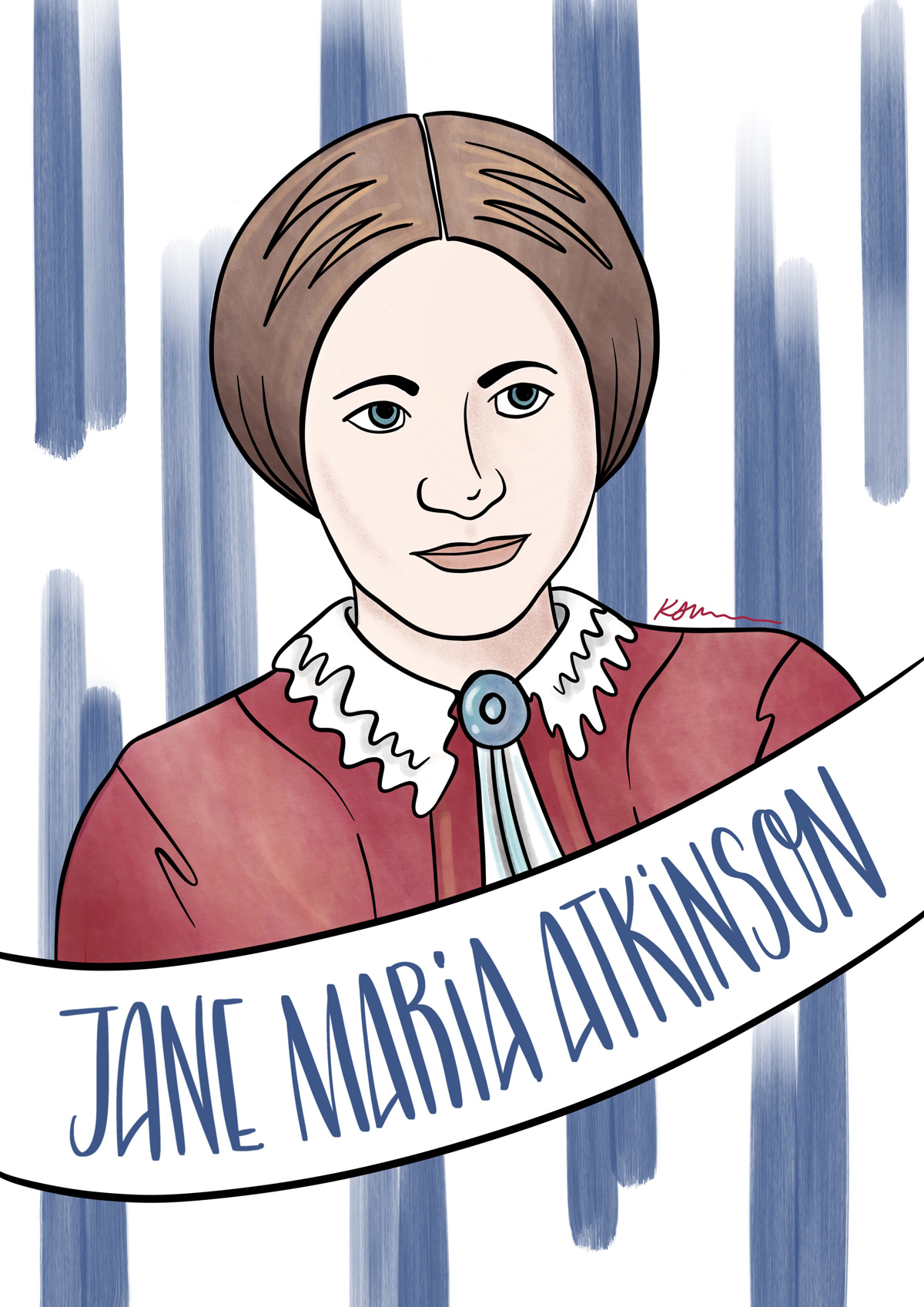
KATE SHEPPARD
SUFFRAGIST & SOCIAL REFORMER
Katherine Wilson Sheppard
1847 - 1934
For six years Kate led the fight to secure the vote for New Zealand women. She was an energetic and highly organised leader and her persuasive writing, effective debating and dogged perseverance inspired women around the country to take action. Kate was impatient with women who sat around looking delicate! Three petitions were presented to Parliament between 1891 and 1893, the final one signed by almost 32,000 women. On 19 September 1893, the Electoral Act 1893 was passed and New Zealand became the first country in the world to grant full voting rights to women.
Kate was born Catherine Wilson Malcolm in Liverpool, England, educated in Scotland and came to New Zealand when she was 21. She was a founding member of the Women’s Christian Temperance Union (WCTU) and in 1885 became leader of its franchise department. Kate continued to promote social justice for women and in 1895 she became editor of the White Ribbon – the WCTU’s newspaper and the first fully female owned and operated publication in NZ.
She helped establish the National Council of Women in 1896 and was elected its first president. Kate spoke at suffrage rallies in Britain and America, where women were not granted the right to vote until after WWI. She was elected honorary vice president of the International Council of Women in 1908 and made a life member of the National Council of Women in 1923.
Kate’s only child and her young granddaughter both died before her and she has no living descendants. On her death, the Christchurch Times wrote: “A great woman has gone, whose name will remain an inspiration to the daughters of New Zealand while our history endures.”
“All that separates, whether of race, class creed or sex, is inhuman and must be overcome.” – Kate Sheppard
To watch
https://www.nzonscreen.com/title/inquiry-nothing-venture-nothing-gain-1974
https://www.nzonscreen.com/title/votes-for-women-what-really-happened-2012
Bibliography
Tessa K. Malcolm. 'Sheppard, Katherine Wilson', Dictionary of New Zealand Biography, first published in 1993, updated May, 2013. Te Ara – the Encyclopedia of New Zealand, https://teara.govt.nz/en/biographies/2s20/sheppard-katherine-wilson
Coney, Sandra: Standing in the Sunshine-A history of New Zealand Women since they won the vote. Penguin Books NZ Ltd, 1993
The Book of New Zealand Women / Ko Kui Ma Te Kaupapa. Bridget Williams (ed), Charlotte Macdonald (ed), Merimeri Penfold (ed). Bridget Williams Books, 1991
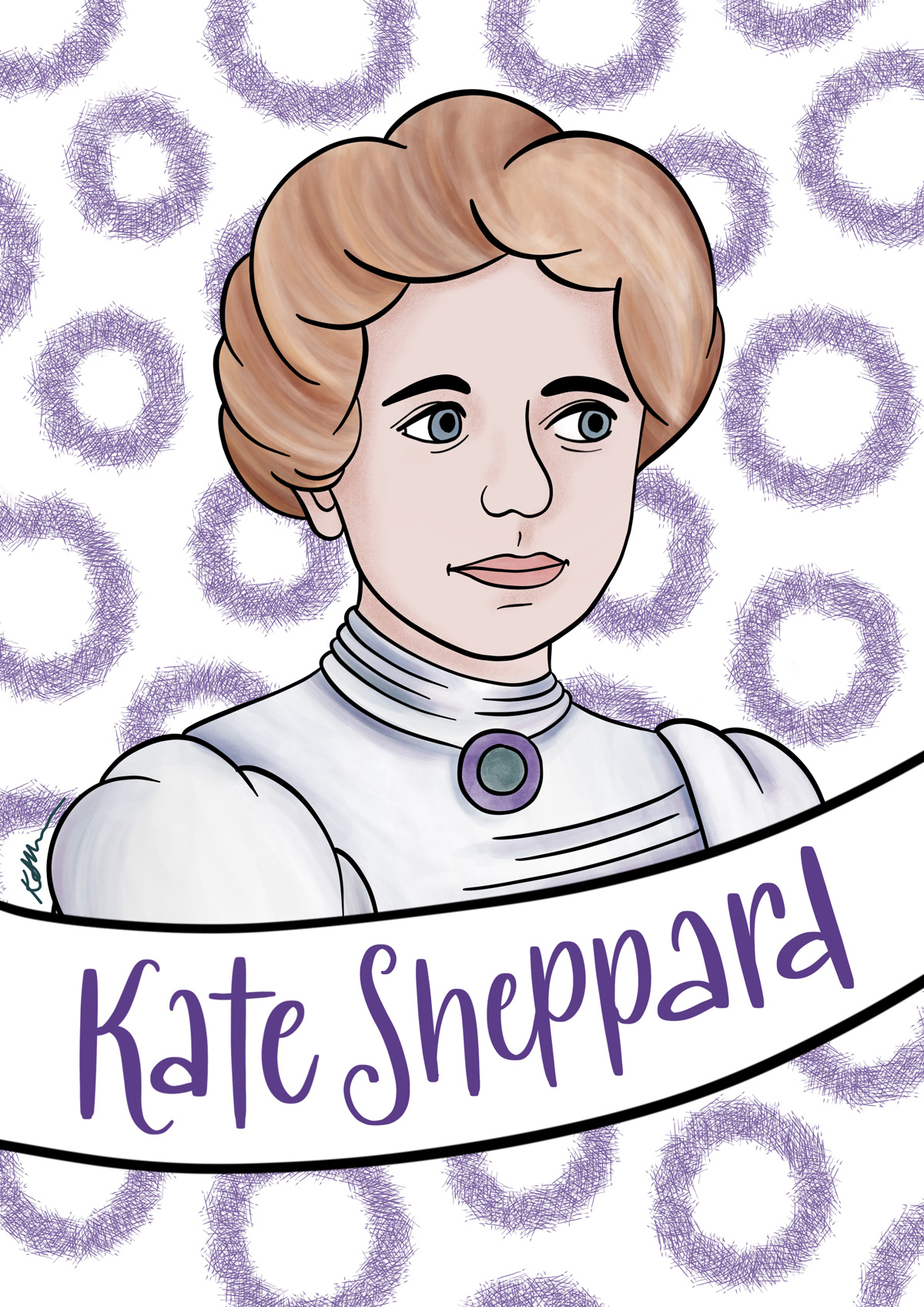
TE PAEA HINERANGI (GUIDE SOPHIA)
TOURIST GUIDE
Te Paea Hinerangi (Guide Sophia)
1830 - 1911
Ngāti Ruanui
Te Paea Hinerangi, known as ‘Guide Sophia’ was the most famous woman in the Rotorua area during the late 19th century, renowned for her guided tours of the Pink and White Terraces (Ōtūkapuarangi and Te Tarata) and Whakarewarewa. She had attended the Wesleyan Native Institution in Auckland and was bilingual. She was a guide, philosopher and friend to the thousands of tourists who crossed her path.
Te Paea was born in Kororāreka (Russell) to Scotsman Alexander Gray and Kotiro Hinerangi. She married twice, had 17 children and settled at Te Wairoa on the shores of Lake Tarawera. Eleven days before the Mt Tarawera eruption, Te Paea was leading a tour group when the lake level suddenly changed and a ghostly waka appeared. This was interpreted as a warning of a disaster. On the night of June 10, 1886, 62 people sheltered in Te Paea’s whare at Te Wairoa during the eruption. Its strong construction ensured all survived.
After the eruption, Te Paea became a guide at Whakarewarewa and, in 1896, she was appointed caretaker of the Whakarewarewa thermal reserve. Here she hosted thousands of tourists including several royal parties.
Te Paea was a public figure and a role model. Her independence and skill encouraged many Tūhourangi women to achieve financial independence by working as guides. She was also committed to the work of the NZ Women’s Christian Temperance Union. Te Paea died at Whakarewarewa on 4 December 1911, and many of her descendants still live in the area.
Bibliography
Jenifer Curnow. 'Hinerangi, Sophia', Dictionary of New Zealand Biography, first published in 1993, updated July, 2015. Te Ara - the Encyclopedia of New Zealand, https://teara.govt.nz/en/biographies/2h37/hinerangi-sophia
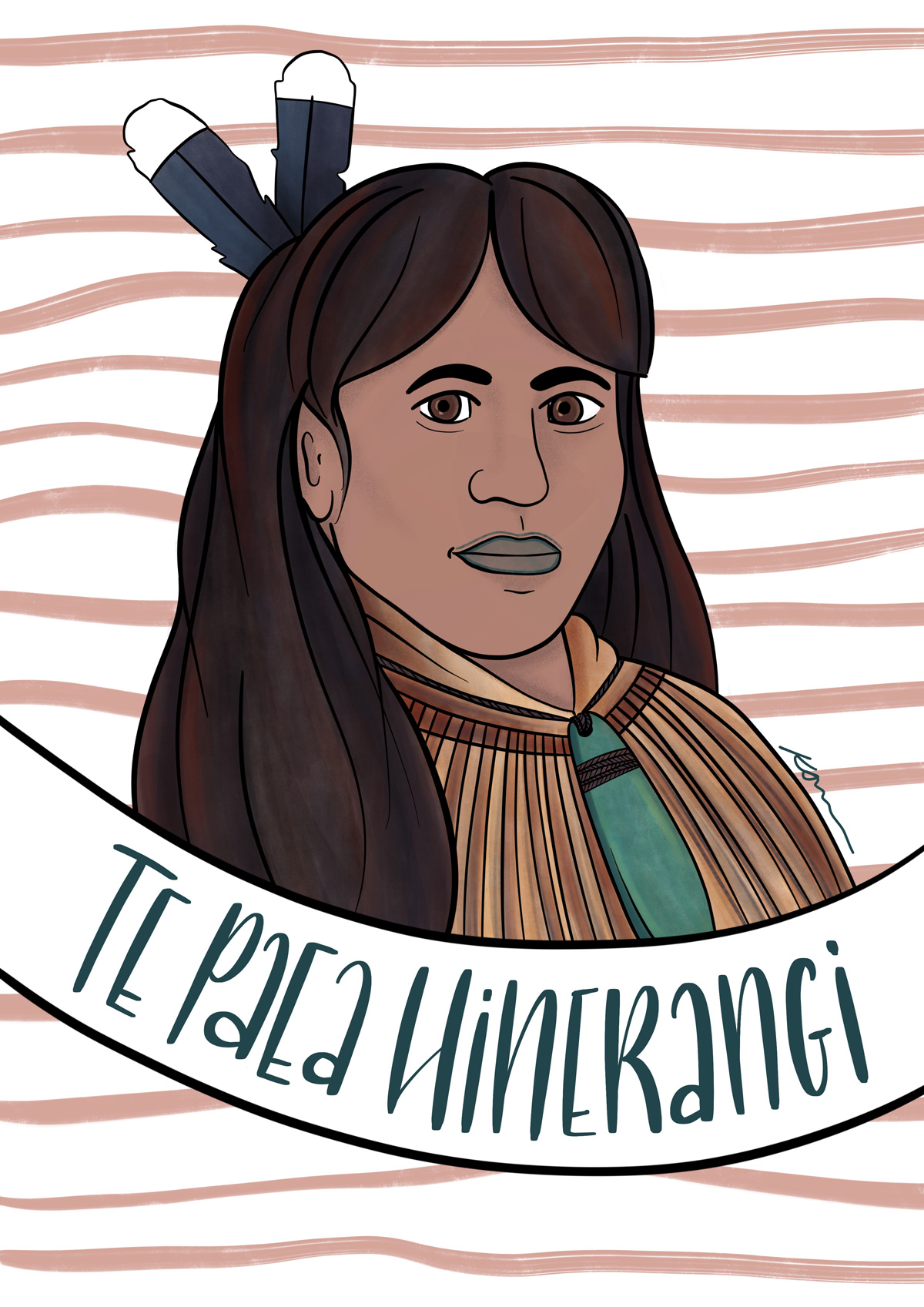
HANA TE HEMARA
ACTIVIST
Hana Te Hemara
1940 - 1999
Te Āti Awa, Ngāti Raukawa
On 14 September 1972, Hana climbed the steps of Parliament flanked by activists Syd Jackson and Lee Smith to present a petition signed by 33,000 New Zealanders. It was Māori Language Day and the petition requested that “courses in Māori language and aspects of Māori culture be offered in school”. At the time the Māori language was in decline and support for it was considered a radical act. Hana was a dynamic orator and passionate activist and her remit to the 1970 Young Māori Leaders Conference was the impetus for the petition. She travelled the length of the country collecting signatures and, together with Ngā Tamatoa and Te Reo Māori Society, led the modern Te Reo Māori language revitalisation.
Hana was the seventh of 12 children, born in Puketapu and educated at the Waitara Convent. She had to leave school at 15, but six years later passed School Certificate English and when she was 30 she enrolled at the University of Auckland to study politics and New Zealand history. With her then husband Syd Jackson, she was a founding member and dynamic leader of Ngā Tamatoa.
Hana worked with Hone Tuwhare to set up the first Māori Artists and Writers’ Conference in 1973 and she was a driving force behind the establishment of Kōhanga Reo language nests. During the 1980s Hana formed the first Māori Business and Professional Association, organised the first Māori fashion award, Te Kopu Tu Tangata Designers’ Award, and the Kokahu Fashion shows which ran in conjunction with the landmark Te Māori exhibitions.
“My vision is to see Māori independence and a better country where all aspects of Māori values can be upheld and shared with all the people in this country”
– Hana Te Hemara, 1994
Special thanks to Ramari Slattery and Nganeko Eriwata
To Watch
Ngā Tamatoa - 40 years on- https://www.nzonscreen.com/title/nga-tamatoa-2012
Bibliography
Brown, Amy and Carlin, Jocelyn: Mana Wahine- Women who show the way. Reed Books,1994
https://www.komako.org.nz/person/1139
https://www.nzherald.co.nz/nz/news/article.cfm?c_id=1&objectid=15781 – Māoridom mourns top activist
http://www.maoritelevision.com/news/regional/today-marks-43-years-maori-language-petition
https://nzhistory.govt.nz/media/photo/maori-language-petition-1972
https://www.youtube.com/watch?v=LUDJbvCWf1w - Professor Rawinia Higgins speaking about the importance of the Māori Language Petition
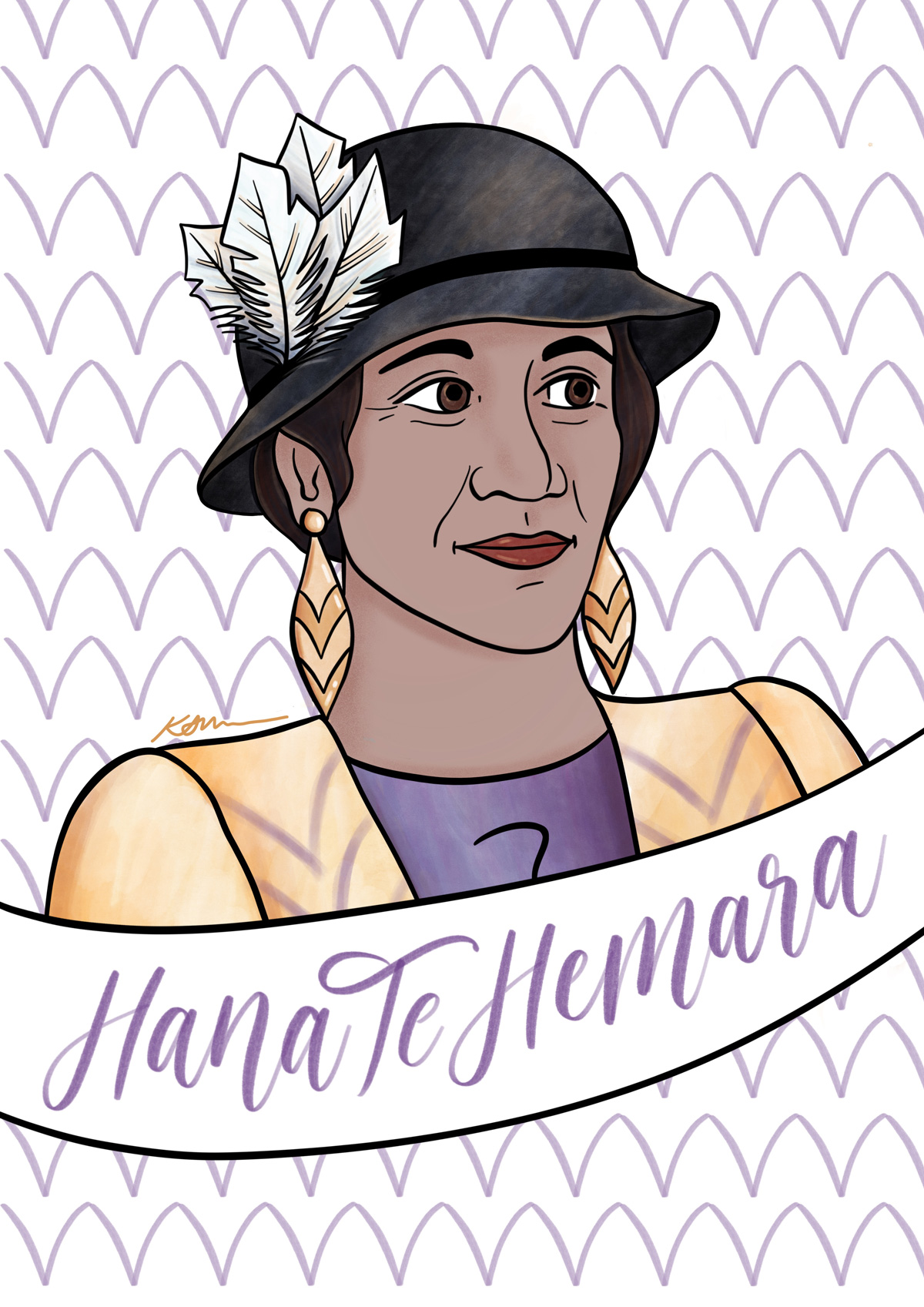
ELIZABETH YATES
FIRST WOMAN MAYOR IN THE BRITISH EMPIRE
Elizabeth Yates née Oman
1845 - 1918
When she won the mayoralty of Onehunga in 1893 by just 13 votes, Elizabeth became the first woman mayor in the British Empire. She received congratulations from Premier Richard Seddon and Queen Victoria but, locally, opposition was fierce. Four councillors and the town clerk resigned not wanting to work under ‘petticoat government’. Council meetings were often disrupted by fierce arguments and Elizabeth’s somewhat ‘tactless and dictatorial manner’ and disregard for established council procedures did not help. Spectators jammed the council chambers, often hooting and jeering during the altercations, and the newspapers reported proceedings in detail.
Elizabeth had immigrated to New Zealand with her parents in the mid-1850s. Her husband, Michael Yates, was elected Mayor of Onehunga in 1888 and Elizabeth had always helped him with his work. She was a strong supporter of women’s suffrage and the first woman to vote under the 1993 Electoral Act. That same year, Michael stood down as mayor because of ill health and Elizabeth contested the by-election. Few expected her to win. Just 12 months later she was resoundingly defeated in the local body elections despite having managed the council out of debt, upgraded roads and sanitation and reorganised the fire brigade.
Elizabeth did not make friends easily and, after several failed attempts at re-election and the death of her husband in 1902, she started drinking and developed dementia. In 1907, Elizabeth was committed to the Auckland Mental Hospital in Avondale where she remained until her death in 1918.
Bibliography
A History of New Zealand Women, Barbara Brookes Bridget Williams Books, 2016
Janice C. Mogford. 'Yates, Elizabeth', Dictionary of New Zealand Biography, first published in 2010. Te Ara - the Encyclopedia of New Zealand, https://teara.govt.nz/en/biographies/2y1/yates-elizabeth
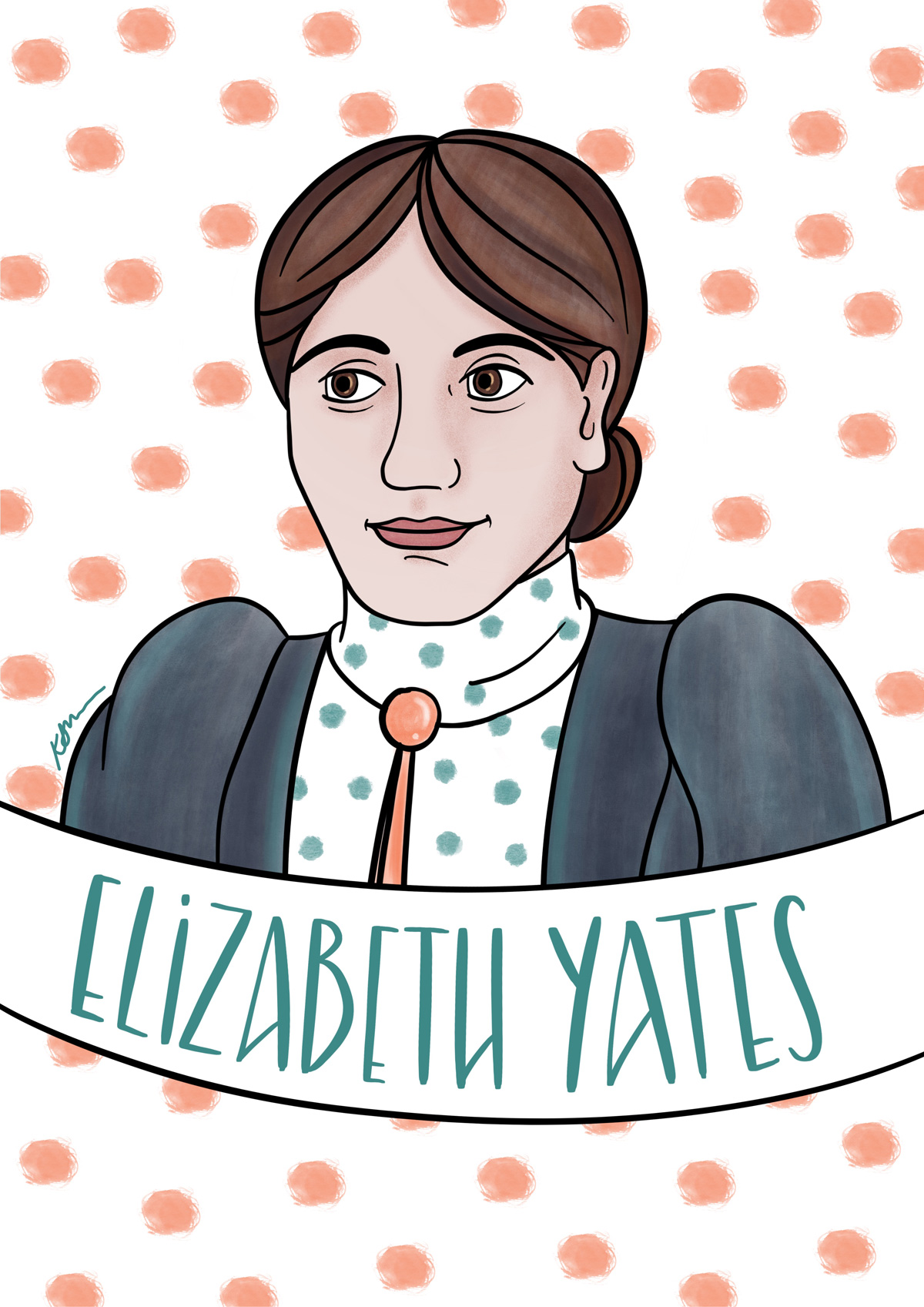
DAME MARILYN WARING
POLITICIAN. FEMINIST. ACTIVIST
Dame Marilyn Joy Waring DNZM
b. 1952
When she won the Raglan seat for the National Party in 1975, Marilyn was just 23 and became New Zealand’s youngest Member of Parliament. Only four of the 87 MPs were women. From 1978 to 1981 she was the only woman in the National Party caucus and she said parliament felt like a boys club. In her first speech to parliament she pledged to represent her electorate, the youth and women of New Zealand. In caucus she chose to sit directly opposite Prime Minister Robert Muldoon, making it clear to him that she would fearlessly make her opinions heard. Marilyn’s decision to cross the floor and support Labour’s nuclear-free legislation led Muldoon to call the 1984 snap election and she did not stand for re-election.
Marilyn is internationally acclaimed as an economist and an activist for female human rights and environmental issues. She is also a prominent spokesperson for gay and lesbian rights. In her 1988 book, If Women Counted, Marilyn argued that women's unpaid work was not counted as productive work and this book is considered to be the founding document of feminist economics. She completed her PhD in political economy in 1989.
In 2005 Marilyn was nominated for the Nobel Peace Prize. Since 2006 she has been Professor of public policy at Auckland University of Technology’s Institute of Public Policy. She was made a Companion of the New Zealand Order of Merit in 2008 for her services to women and economics.
In the 2020 New Year Honours, Marilyn was appointed a Dame Companion of the New Zealand Order of Merit, for services to women and economics.
“This place, Parliament, is the extreme of what is not a woman’s world. There is very little of the female world here.”
- Marilyn Waring, 1984.
More to Watch
Who's Counting? Marilyn Waring on Sex, Lies and Global Economics https://www.youtube.com/watch?v=WS2nkr9q0VU
More to Read
In the Lifetime of a Goat: Writings 1984 - 2000
Bibliography
Celebrating Women- New Zealand Women and their Stories- Mediawomen of New Zealand , Cape Catley Ltd, 1984
https://en.wikipedia.org/wiki/Marilyn_Waring
http://www.marilynwaring.com/news/2015-womensday.html
http://www.nzherald.co.nz/nz/news/article.cfm?c_id=1&objectid=11272095

FRANCES ALDA
SOPRANO
Fanny Jane Davis
1879 – 1952
Recognised as one of the great sopranos of the 20th Century, Frances was the first New Zealander to establish an international operatic career. She sang at Covent Garden and La Scala, and gave 369 performances with The Metropolitan Opera in New York during her 35-year career. Her finest role was Mimi in Puccini’s La Boheme, which she sang 80 times, partnering with all the leading tenors of the time, including Enrico Caruso.
Frances was born in Christchurch and named Fanny Davis. Her mother died when Frances was four and she was raised in Melbourne by her musical maternal grandparents. Frances was a musically gifted child and, when she was 22, she left for Europe; a girl from the ‘colonies’ determined to make it in the ruthless world of European opera. She changed her name to the more Italian-sounding Frances Alda and made her acclaimed operatic debut in Paris in 1904. Following her move to New York, she married Giulo Gatti-Casazza, the general manager of the Metropolitan Opera. It was a tempestuous 18-year relationship which, at times, limited her career.
Frances was a presence; beautiful, with stunning red hair, unconventional and never afraid to give her opinion. She was an advocate for women’s rights in the music profession, a great supporter of young artists and was one of the first opera stars to appear on radio.
She died in Venice aged 73 and, despite spending most of her life overseas, Frances remained a proud and patriotic New Zealander.
More to Read
Men, Women and Tenors, Frances Alda, Boston, 1937
More to Listen to
Frances Alda: O mio babbino caro (1919) https://www.youtube.com/watch?v=UTZZQM7Z_yk
Frances Alda: Two Maori Songs (1928) https://www.youtube.com/watch?v=sMiw06wOUSI
Bibliography
Adrienne Simpson. 'Alda, Frances', Dictionary of New Zealand Biography, first published in 1996. Te Ara - the Encyclopedia of New Zealand, https://teara.govt.nz/en/biographies/3a9/alda-frances
http://www.nzedge.com/legends/frances-alda/
The Book of New Zealand Women / Ko Kui Ma Te Kaupapa. Bridget Williams (ed), Charlotte Macdonald (ed), Merimeri Penfold (ed). Bridget Williams Books, 1991

DAME ANNE SALMOND
ANTHROPOLOGIST. HISTORIAN. ENVIRONMENTALIST.
Professor Dame Mary Anne Salmond DBE FRSNZ
b. 1945
Through her research and writings, Dame Anne has brought Māori stories to a Pākehā audience and built bridges between New Zealand’s different cultures.
She grew up in Gisborne and in her teens became fascinated with Māori culture. She graduated from the University of Auckland with a Masters of Arts in anthropology and completed her PhD in 1972. From 1971 she collaborated with Erurera and Amiria Stirling of Te Whānau-ā-Apanui and Ngāti Porou on three books on Māori life, including the award-winning Euruera: Teachings of a Māori Elder. Since the 1990s Dame Anne has written multiple award-winning books on cross cultural encounters and the early exchanges between Pacific Islanders and European explorers in the Pacific. The Trial of the Cannibal Dog won the Montana Award for history and the Montana Medal for nonfiction in 2004.
Dame Anne is a Fellow of the Royal Society Te Apārangi and in 1995 became a Dame Commander of the Order of the British Empire in 1995. In 2013 she was named New Zealander of the Year and also became the first social scientist awarded the Rutherford Medal, the highest award of the Royal Society Te Apārangi.
She has long been a passionate environmentalist and, in 2000, Dame Anne and her husband began the restoration of the Longbush Ecosanctuary in Gisborne. She is patron of several environmental organisations including Te Awaroa: 1000 Rivers, which aims to restore 1000 waterways across New Zealand by 2050.
Dame Anne has been Distinguished Professor of Māori studies and anthropology at the University of Auckland since 2001.
“If we all link arms and reach across, we could join forces to do anything” – Dame Anne Salmond
More to Read:
Tears of Rangi: Experiments Across Worlds by Anne Salmond (Auckland University Press, 2017)
The Trial of the Cannibal Dog: Captain Cook in the South Seas, by Anne Salmond (Penguin, 2004) (winner of the Montana Medal for Non-fiction in 2004)
Euruera: Teachings of a Māori Elder by Euruera Stirling and Anne Salmond (Oxford University Press. 1980) (first equal Wattie Book Awards, 1981)
More to Listen to: https://www.radionz.co.nz/national/programmes/sunday/audio/201852079/anne-salmond-tears-of-rangi
Bibliography
https://www.noted.co.nz/archive/listener-nz-2013/dame-anne-salmond-wins-rutherford-medal/
https://en.wikipedia.org/wiki/Anne_Salmond
http://www.bookcouncil.org.nz/writer/salmond-anne/
http://www.stuff.co.nz/national/8366898/Dame-Anne-wins-NZer-of-the-Year
https://royalsociety.org.nz/members/memberpage/388
http://www.nzherald.co.nz/lifestyle/news/article.cfm?c_id=6&objectid=11899254

DAME NAOMI JAMES
OCEAN SAILOR
Dame Naomi Christine James DBE
b. 1949
On 8 June 1978 Dame Naomi nursed the 53-foot Express Crusader into Dartmouth Harbour becoming the first woman to sail solo around the world via Cape Horn in a record breaking 272 days, beating Sir Francis Chichester’s record by two days. Dame Naomi was a very private person who disliked crowds but she returned a celebrity and, aged 29, became the youngest New Zealander to be made a Dame.
Dame Naomi grew up on a remote dairy farm in Hawkes Bay and trained as a hairdresser before heading to Europe by ship. She was seasick for much of the voyage. She was 23 when she taught herself to swim and she only learnt to sail after meeting her future husband, sailor Rob James.
She left Dartmouth on 9 September 1977 in a borrowed boat with little real sailing experience. For the first three months she confused latitude (which she measured by sextant) and longitude (determined by complex calculations). In the South Atlantic she lost radio contact for 8000 miles and her kitten, Boris, fell overboard. Six months into the voyage a five-metre wave capsized the boat and she was miraculously saved by the self-righting keel. For much of the voyage she would snatch no more than 1.5 hours sleep at a time; sometimes she went for days without rest.
Dame Naomi retired from sailing in 1982. Six months later her husband, Rob, drowned in a sailing accident, 10 days before the birth of their daughter. Dame Naomi now lives in Cork, Ireland.
“I was terrified I would not find the Canary Islands. When they loomed into view I was so pleased with myself I thought I had discovered them!” Dame Naomi commenting on the navigational challenges early in her circumnavigation.
Bibliography
https://www.independent.co.uk/news/the-forgotten-dame-who-sailed-round-the-world-1530210.html
http://www.nzherald.co.nz/sport/news/article.cfm?c_id=4&objectid=11920616
https://www.nzhalloffame.co.nz/New-Zealand-Sports-Hall-of-Fame-Inductees/J/Naomi-James
More to read
At one with the sea by Naomi James (Hutchinson, 1979)
At sea on land by Naomi James (Hutchinson/Stanley Paul, 1981)

NURUL SHAMSUL
POET. MUSLIM TRAILBLAZER. MISS UNIVERSE NZ FINALIST 2018.
Nurul Zuriantie Binti Shamsul
b. 1997
A self-proclaimed farm girl at heart, Nurul is making history and redefining what it means to be beautiful as the first contestant in Miss Universe New Zealand to wear hijab.
Originally born in Ampang, Selangor Nurul has been raised in New Zealand by her Malaysian father and Indonesian mother since she was five years old. Growing up in a pink two-storey farm house in Morrinsville, Nurul was the only Asian girl at her rural country school. Speaking no English when she arrived, Nurul learnt English through poetry and nursery rhymes. This was the beginning of her love of writing and poetry.
At age 17 her poem ‘The Liberation of Wine’ was published in the 50th edition of New Zealand Poetry, the country’s longest-running poetry magazine. She has since been published in several publications including Blackmail Press and the Otago University Literary Society Press. Currently majoring in Psychology at the University of Waikato Nurul is the first in her family to attend tertiary education. Nurul uses her voice as a blogger to talk about issues around mental health, feminism, human rights, travel and beauty.
In 2018 Nurul was announced as one of the 20 finalists for Miss Universe New Zealand, one of the first in the world to do so wearing a hijab.
In New Zealand, where Muslims make up two percent of the population, Nurul is breaking boundaries and stereotypes, pioneering a new and inclusive culture of beauty that is more than skin deep.
Who
Are
We
To 'believe' the media?
Don't look at me.
Look into me;
For I am a girl
Liberated
With her silk pashmina,
Wine red scarf.
- From The Liberation of Wine by Nurul Shamsul in New Zealand Poetry 2015
Bibliography
https://www.thegirlinthewineredscarf.com/new-page/
https://www.nst.com.my/opinion/columnists/2018/06/377472/creating-waves-and-redefining-beauty
http://cleo.com.my/nurul-shamsul-is-miss-universe-new-zealands-first-indo-malay-hijabi-finalist/
https://www.thestar.com.my/news/nation/2018/07/13/ordinary-girl-embarks-on-extraordinary-quest/
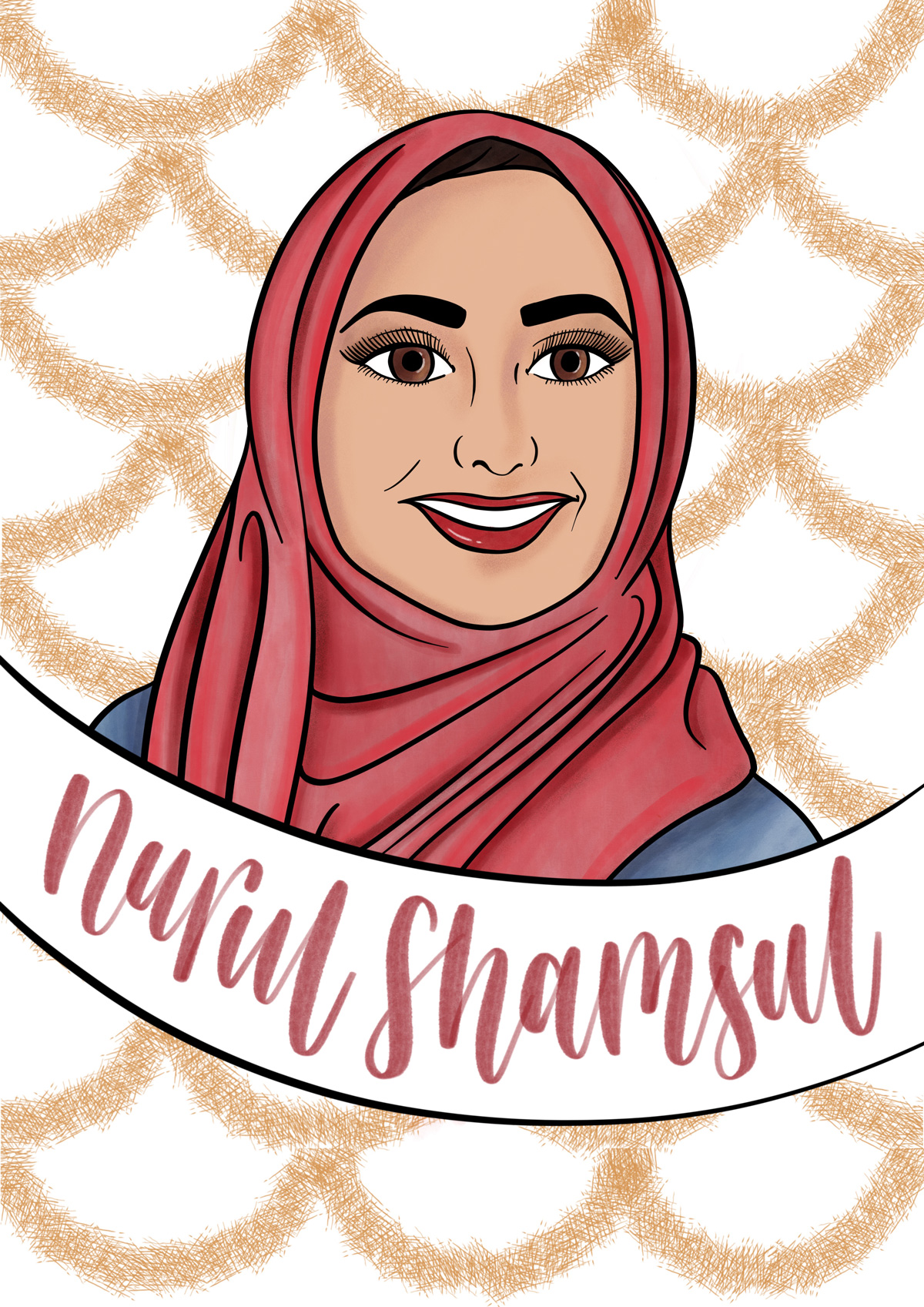
DAME JACINDA ARDERN
YOUNGEST LEADER OF THE LABOUR PARTY
WORLD’S YOUNGEST FEMALE HEAD OF GOVERNMENT
Dame Jacinda Kate Laurell Ardern GNZM
b. 1980
By any standard, Jacinda’s 18 months from January 2017 were unprecedented for a New Zealand politician. She was in her ninth year as a Labour list MP at the start of 2017. In February, she was elected MP for Mt Albert and by March was deputy leader of the Labour Party. On 1 August, Jacinda became the youngest ever leader of the New Zealand Labour Party just seven weeks before the general election. The media coined the word 'Jacindamania' to describe the positive effect this had on Labour party support. On 19 October 2017, aged 37, Jacinda became New Zealand’s second youngest prime minister and the world’s youngest female head of government. In June 2018, she became the first New Zealand leader, and only the second world leader, to have a child while holding office. Neve Te Aroha Ardern Gayford was born on Thursday, June 21 2018.
Jacinda went to school in Morrinsville and joined the Labour party when she was 17. In 2001, she graduated from the University of Waikato with a Bachelor of Communication Studies in politics and public relations. She worked as a researcher for MPs Phil Goff and Helen Clarke, and was a senior policy adviser on a team of 80 for British Prime Minister Tony Blair. In 2008, Jacinda came into parliament as a Labour list MP. She has always been strong advocate for children, women, and the right of every New Zealander to have meaningful work.
On 19 January 2023, Jacinda announced she would resign as Labour leader and prime minister by 7 February and leave Parliament by the 2023 general election. She cited a desire to spend more time with her partner and daughter and an inability to commit to another four years.
During her five years in office she dealt with the Christchurch Mosque shootings, the White Island Eruption and the COVID-19 Pandemic.
On 26 May 2022, Jacinda was awarded an honorary Doctor of Laws degree by Harvard University for contributions that "shape the world".
In the 2023 King's Birthday and Coronation Honours, Jacinda was appointed a Dame Grand Companion of the New Zealand Order of Merit (GNZM), for services to the State.
Bibliography
https://en.wikipedia.org/wiki/Jacinda_Ardern
http://www.nzherald.co.nz/nz/news/article.cfm?c_id=1&objectid=11897476
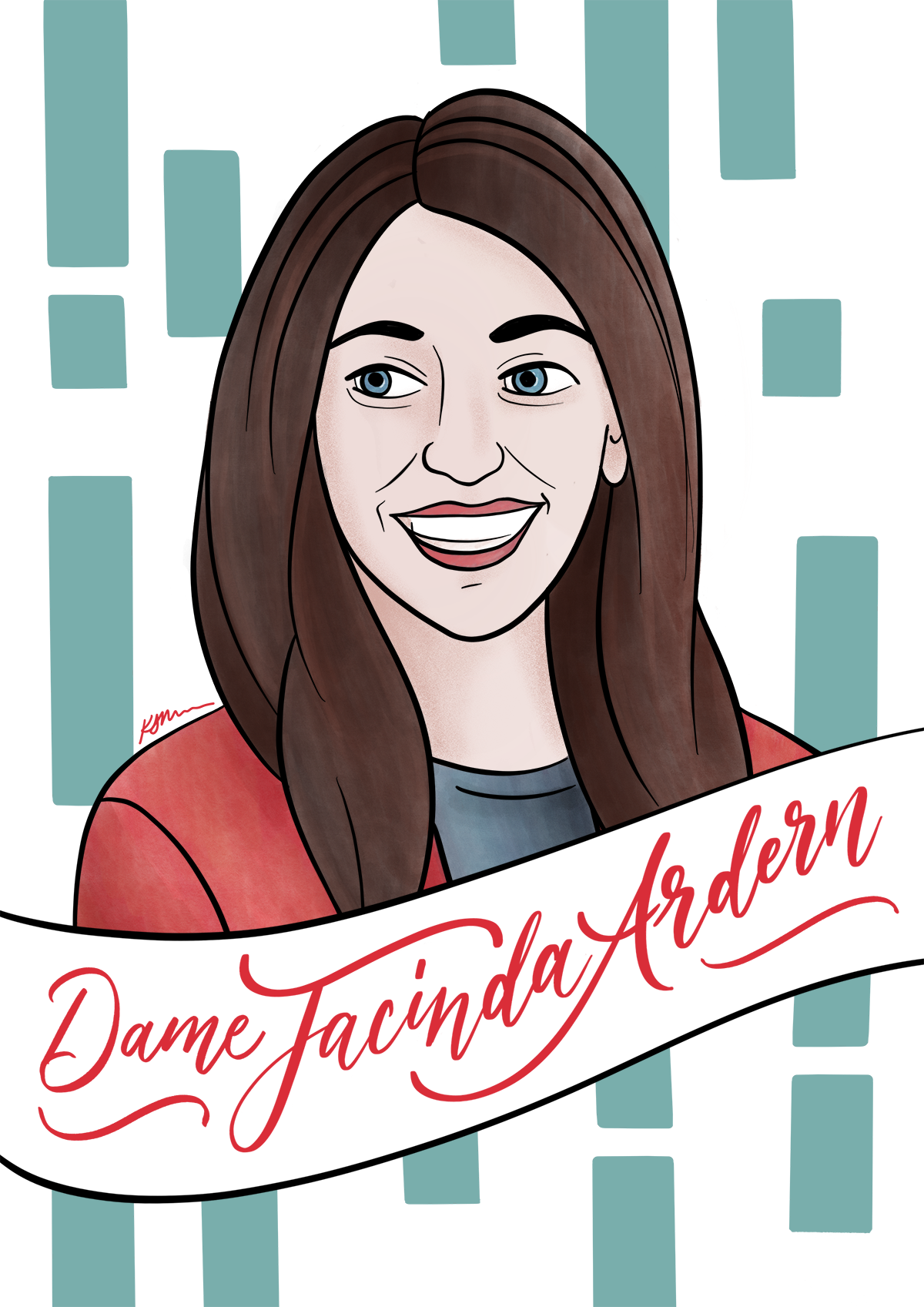
LUCY MOORE
THE MOTHER OF NEW ZEALAND BOTANY
Dr. Lucy Beatrice Moore MBE FRSNZ
1906 - 1987
Known as ‘the mother of New Zealand botany’, Lucy was a pioneer in botanical research. She tramped into remote parts of New Zealand to carry out ground-breaking plant research. Conditions were rough; Lucy’s sleeping bag was an unlined canvas sack and her tent was a flysheet draped over branches. She grew up near Warkworth, boarded at Epsom Girls’ Grammar and, in 1929, graduated with a Master of Science with first class honours. Lucy’s often highly-original research was internationally acclaimed but she was unsuccessful in securing a university teaching position because she was a woman.
In 1938, Lucy was appointed to the botany division of the Department of Scientific and Industrial Research (DSIR) in Wellington where she worked for 33 years. She studied weeds, seaweeds, high country plants and made outstanding contributions to the first two volumes of the Flora of New Zealand series.
During World War II, imports of Japanese agar ceased. Agar was essential for medical research and Lucy was asked to find seaweed that could be used to manufacture it in New Zealand. She discovered a variety on the East Cape and arranged a for school children to collect the seaweed for pocket money.
Lucy became a Fellow of the Royal Society Te Apārangi in 1947 and, in 1965, was the first woman to win the Hutton Medal for outstanding services to systemic and applied botany in New Zealand.
She was also awarded a Most Excellent Order of the British Empire (MBE), a Doctorate of Science and the Marsden Medal for services to science.
“Few botanists may ever again equal her range of expertise... inspired by a vision, and practised with dedication.” - John Morton
Bibliography
John Morton. 'Moore, Lucy Beatrice', Dictionary of New Zealand Biography, first published in 2010. Te Ara - the Encyclopedia of New Zealand, https://teara.govt.nz/en/biographies/5m55/moore-lucy-beatrice
https://en.wikipedia.org/wiki/Lucy_Moore_(botanist)
https://royalsociety.org.nz/150th-anniversary/150-women-in-150-words/1918-1967/lucy-moore/
https://www.roadshow.org/content/resources/NZscientists/LucyMoore.php
The Book of New Zealand Women / Ko Kui Ma Te Kaupapa. Bridget Williams (ed), Charlotte Macdonald (ed), Merimeri Penfold (ed). Bridget Williams Books, 1991
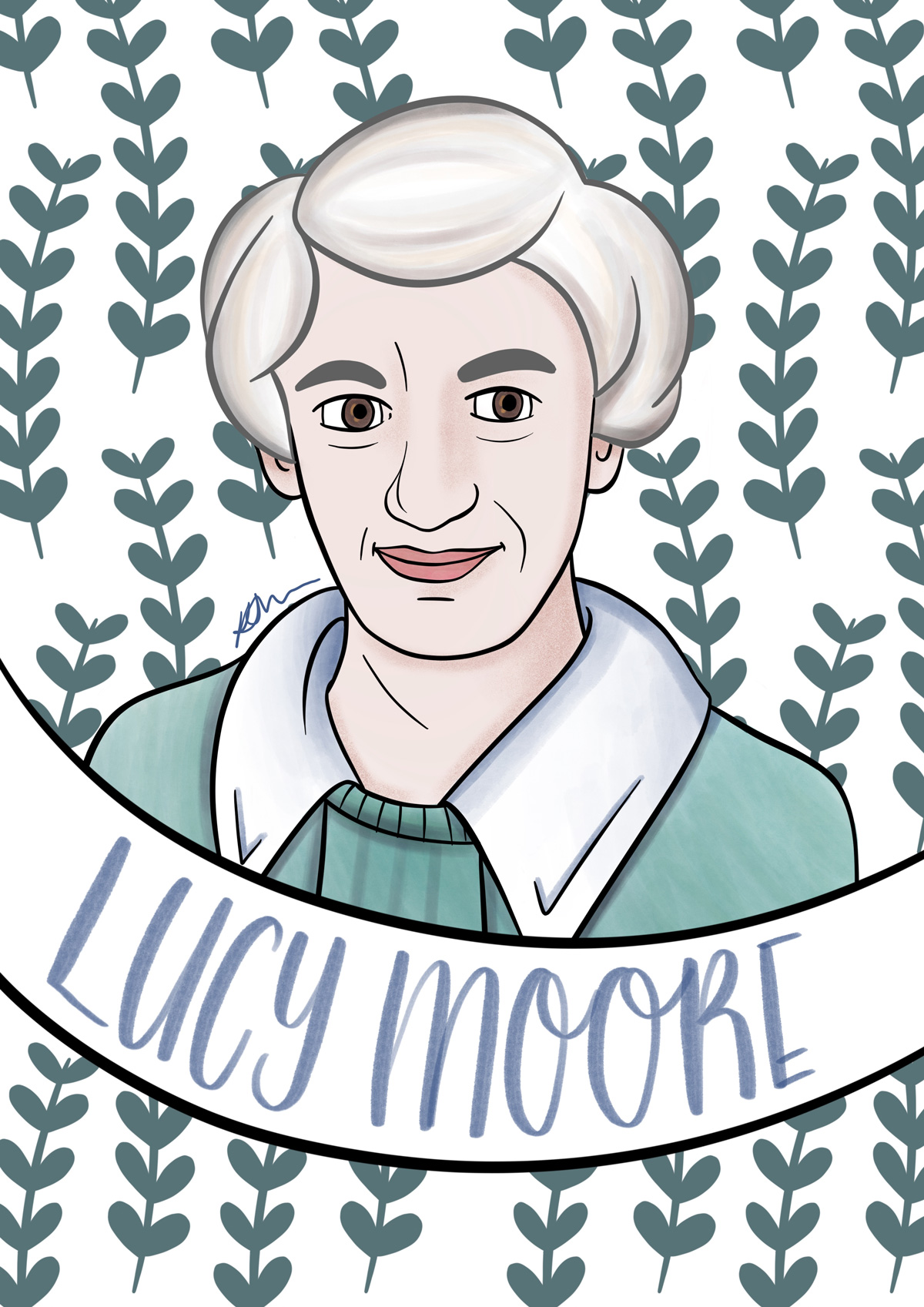
AUNT DAISY
FIRST LADY OF RADIO
Maud Ruby Basham MBE
1879 - 1963
For three decades from 1933 Aunt Daisy was New Zealand’s best known and most respected radio broadcaster. Each weekday morning at 9am her signature tune, Daisy Bell, and her energetic “Good morning, good morning, good morning everybody” greeted her listeners. For 30 minutes she would talk, unscripted – at a dazzling 200 words per minute – providing recipes, household hints, and comments on films, concerts and even the Dean’s Sunday Sermon. She would only advertise products she had used and a product mentioned in the morning was likely to sell out by mid-afternoon.
Daisy grew up in Victorian London and was 12 when her widowed mother moved the family to New Plymouth. She trained in singing and as a teacher then, in the late 1920s, with the support of her husband, Fred, Daisy began writing and broadcasting pieces on composers. She became Aunt Daisy after taking over the children’s session on 1YA and then moved to her own slot on 1ZB in 1933. During World War II she reported on the lives of women living on military bases. In 1944, she visited the US and, over tea with Eleanor Roosevelt, passed on messages from American personnel stationed in New Zealand. Aunt Daisy published a dozen recipe and hints books and her cookbook was in its 22nd reprint in 2010.
She was awarded Most Excellent Order of the British Empire (MBE) in 1956 for services to broadcasting. Her vitality, charisma, strength and resilience made her seem ageless and many were shocked to learn she was 83 when she died, just a few days after her final broadcast.
Bibliography
1998. Te Ara - the Encyclopedia of New Zealand, https://teara.govt.nz/en/biographies/4b11/basham-maud-ruby
The Book of New Zealand Women / Ko Kui Ma Te Kaupapa. Bridget Williams (ed), Charlotte Macdonald (ed), Merimeri Penfold (ed). Bridget Williams Books, 1991

DAME RUIA MORRISON
TENNIS PLAYER
Dame Ruia Mereana Morrison-Davey DNZM MBE
b. 1936
Te Arawa, Ngāti Tūwharetoa
Regarded as one of New Zealand’s best tennis players, Ruia won 13 senior national titles and was the first New Zealand woman to play at Wimbledon, reaching the quarter-finals in 1957 and making the final 16 in 1958, 1959 and 1960. At her peak she was ranked ninth in the world.
Ruia was born in Tikitere, the third child of Hingawaka (Waki) Morrison and Tanira Kingi. By age eight, she was playing on dirt courts with a bat her father had made. After her first racquet broke because she hit the ball so hard, she played with her father’s full sized racquet. On leaving Queen Victoria School for Girls, Ruia enrolled at Auckland Teachers' College, though her study was frequently interrupted by major tennis tournaments.
Ruia was only 1.54m tall but was an aggressive player with a strong forehand and a near perfect volley. In the 1950s there was little media interest in women’s tennis but Ruia, with her charm, sparkling personality and excellent all-round game, single-handedly lifted the profile of women’s tennis in New Zealand.
When the New Zealand Lawn Tennis Association refused to give her financial support to go to Wimbledon, the Ruia Morrison Wimbledon Fund Committee was established and raised the money for her fare and expenses, first through Māori tribal communities and then through a nationwide appeal.
Ruia was made a Member of the British Empire in 1960 for services to Māori people and New Zealand tennis. Ruia retired from tennis in 1982 after a 30-year competitive playing career.
In the 2021 Queen's Birthday Honours, Ruia was appointed a Dame Companion of the New Zealand Order of Merit, for services to tennis
"Everybody's got gifts, it's the passion with which you use them that counts."- Ruia Morrison
More to listen to http://www.radionz.co.nz/national/programmes/teahikaa/audio/2556271/ruia-morrison-davy
More to watch
Māori and tennis: acing it at 80 https://teara.govt.nz/en/video/41484/ruia-morrison
Bibliography
http://maorisportsawards.co.nz/profiles/ruia-morrison-davy-mbe/
Standing in the sunshine - a history of New Zealand women since they won the vote by Sandra Coney (Penguin Books NZ Ltd, 1993)
Michael Romanos, Ruia Morrison, Tu Tangata (July 1986)
Basil Keane, 'Māori and sport – hākinakina - Māori and sport from the late 20th century', Te Ara - the Encyclopedia of New Zealand, http://www.TeAra.govt.nz/en/video/41484/ruia-morrison
http://www.nzherald.co.nz/rotorua-daily-post/news/article.cfm?c_id=1503438&objectid=11102082

ETHEL BENJAMIN
NEW ZEALAND’S FIRST WOMAN LAWYER
Ethel Rebecca Benjamin
1875 -1943
When she started law school at the University of Otago in 1893, Ethel did not know if she would be allowed to practise when she graduated. The law was changed in 1896 to allow women to practise law. Ethel graduated in 1897 with outstanding marks, becoming New Zealand’s first woman lawyer and the second woman in the British Empire to be admitted as a barrister and solicitor. While her fellow classmates at university had accepted her, the Otago District Law Society did not. It restricted her use of the society’s library, declined her usual new graduate support and excluded her from their annual dinner.
Ethel was an astute businesswoman and ran a successful law practice in Dunedin for 10 years. Her clients were from the local Jewish community and independently wealthy women. She also worked with the local hotel industry and was one of the few advocates of women’s rights who did not support the temperance movement. Ethel was a founding member of the Dunedin Society for the Protection of Women and Children and was the society’s honorary lawyer helping women deal with abusive relationships and divorce.
Following her marriage to Alfred De Costa in 1907 she moved first to Wellington then to England. She died in 1943 following an accident.
On the centenary of Ethel’s graduation, the Law Foundation established the Ethel Benjamin Scholarship which provides $50,000 a year, to two outstanding New Zealand women law graduates, for post-graduate study overseas.
“When I heard that being a woman, I could not be admitted to the practise of law, I was very indignant... and I grew all the more determined to follow the legal profession” - Ethel Benjamin
More to Read:
In the Footsteps of Ethel Benjamin: New Zealand's First Woman Lawyer by Janet November (Victoria University Press, 2009)
Bibliography
Carol Brown. 'Benjamin, Ethel Rebecca', Dictionary of New Zealand Biography, first published in 2010. Te Ara - the Encyclopedia of New Zealand, https://teara.govt.nz/en/biographies/2b18/benjamin-ethel-rebecca
https://en.wikipedia.org/wiki/Ethel_Benjamin
https://www.odt.co.nz/entertainment/books/ethel-benjamin-law-unto-herself

JOY COWLEY
CHILDREN’S FICTION WRITER
Cassia Joy Cowley ONZ DCNZM OBE
b. 1936
Widely published and much celebrated, Joy is best known for her children’s books. She is a creative and inspiring storyteller and, worldwide, generations of children have learned to love reading with her popular characterslike Mrs Wishy Washy and Dan the Flying Man, and timeless tales like Bow Down Shadrach (1991) and The Road to Ratenburg (2016).
As a schoolgirl, Joy edited the children’s page of the local paper and, in the early 1960s, she began writing short stories, submitting 29 stories before the NZ Listener accepted one for publication. Her first book was for adults, Nest in a Falling Tree (1967), and was made into the movie The Night Digger, directed by Roald Dahl.
In the mid-1960s Joy began writing stories for her son, Edward, who, like her, had difficulty learning to read. In the late 1970s she wrote the first of hundreds of stories for Wendy Pye’s StoryBox reading program.
Joy wants children to see themselves and their own culture in the stories they read and, for 30 years, she has run writing workshops for people whose cultures do not feature in their children’s books.
Joy’s books have received national and international awards and, in 2005, she was made a Distinguished Companion of the New Zealand Order of Merit. She has twice been nominated for the Hans Christian Anderson Award and, in 2018, Joy was made a member of the Order of New Zealand.
Now in her early 80s, Joy has 13 grandchildren and is still writing full time.
“The day I’m no longer in touch with young people, is the day I stop writing for them, because the energy flows from them and goes back to them” – Joy Cowley
More to read
Navigation: A Memoir, by Joy Cowley. Penguin 2010
Bibliography
https://en.wikipedia.org/wiki/Joy_Cowley
https://www.stuff.co.nz/national/100113367/joy-cowley-onz-you-can-see-life-as-a-series-of-stories
https://www.stuff.co.nz/national/100113367/joy-cowley-onz-you-can-see-life-as-a-series-of-stories
The Oxford Companion to New Zealand Literature, Edited by Roger Robinson and Nelson Wattie. Oxford University Press, 1998

DAME RANGIMĀRIE HETET
TOHUNGA RARANGA (MASTER WEAVER)
Dame Rangimārie Hetet DBE
1892 - 1995
Ngāti Kinohaku, Ngāti Maniapoto
Her passion for teaching revitalised the art of traditional Māori weaving, and Dame Rangimārie became the finest Māori weaver of the 20th century. Her works are exquisite pieces of feather and fibre art and she used only natural materials. Dame Rangimārie’s work is notable for its fine, meticulous weaving and innovative design and she could spend 450 hours completing one korowai (cloak).
Dame Rangimārie was born at Oparure in the King Country. Her father, Charles Wilson Hursthouse, was a surveyor and she was taught the art of traditional weaving by her mother, Mere Te Rongopāmamao Aubrey.
She left Oparure after her marriage to Tuheka Taonui Hetet but returned in 1948. She was a founding member of the Māori Women’s Welfare League and, with her daughter and protégée, Diggeress Te Kanawa, agreed to teach traditional Māori weaving on the condition she could teach all who wanted to learn, rather than the customary rule of only teaching women from her own tribe.
By the 1960s, Dame Rangimārie was nationally known as a specialist in korowai weaving and, during mid-1970s, she began exhibiting internationally.
Dame Rangimārie was highly organised, constantly active and stubbornly independent. She continued weaving until she died, aged 103, outliving three of her children and is survived by over 100 descendants.
Dame Rangimārie received a doctorate from the University of Waikato in 1986 and was made a Dame Commander of the British Empire in 1992 for services to Māori arts and crafts. The Waikato Museum is the kaitiaki (guardian) of her work.
“I let it be known I was prepared to teach anybody who wanted to learn” - Dame Rangimārie Hetet
Bibliography
Standing in the Sunshine-A history of New Zealand Women since they won the vote by Sandra Coney (Penguin Books NZ Ltd, 1993)
Celebrating Women - New Zealand Women and their Stories by Mediawomen of New Zealand (Cape Catley Ltd, 1984)
https://teara.govt.nz/en/biographies/5h18/hetet-rangimarie

JEAN BATTEN
AVIATOR, ‘GARBO OF THE SKIES’
Jane Gardner Batten
1909 - 1982
During the 1930s flying was the most dangerous and exciting activity on earth and Jean was the finest female pilot of this golden age of aviation. She was the first woman to fly solo England to Australia and return, to fly across the Atlantic, and to fly from England to New Zealand. Jean was the most famous New Zealander of the time and her arrival at Mangere airport at the end of her 1936 record-breaking solo flight from England created Auckland’s biggest traffic jam.
She was born in Rotorua and went to England in 1930 to become a pianist but chose to sell her piano to fund flying lessons.
Jean was adventurous, glamorous and utterly fearless. She took huge risks, flew in dangerous weather and was an exceptional navigator. Her transatlantic flight of 1900 miles from West Africa to Brazil was a brilliant 13-hour feat of navigation through storms, armed with just a watch and compass which failed.
Jean carried minimal luggage but always disembarked looking immaculate in her white flying suit, with lipstick and cologne carefully applied.
Fame did not bring her happiness. Jean had a reputation for using men to aid her ambitions and several of her close friends were killed in flying accidents. Her intense relationship with her driven mother isolated her and, after Jean’s mother died, she became a recluse and died alone in 1982. At the time, her body was unidentified and buried in a pauper’s grave in Majorca.
More to read
The Infinite Air by Fiona Kidman (Random House, 2013)
Bibliography
http://www.nzedge.com/legends/endurance/jean-batten/
https://teara.govt.nz/en/biographies/4b13/batten-jean-gardner
https://nzhistory.govt.nz/people/jean-batten
http://www.stuff.co.nz/dominion-post/culture/9245744/Plane-truths-about-Jean-Batten
The Book of New Zealand Women / Ko Kui Ma Te Kaupapa. Bridget Williams (ed), Charlotte Macdonald (ed), Merimeri Penfold (ed). Bridget Williams Books, 1991

SELINA TUSITALA MARSH
POET AND SCHOLAR
New Zealand Poet Laureate 2017-19
Dr. Selina Tusitala Marsh
b. 1971
Of Samoan, Tuvaluan, English, Scottish and French ancestry, Selina was the first student of Pasifika descent to graduate from the University of Auckland with a PhD in English. She is New Zealand’s current Poet Laureate and a mesmerising performance poet with the gift of making poetry accessible to all.
Growing up in Avondale, Selina would spend her weekly pocket money on a carton full books from the local op shop, reading everything from cookbooks to Boys Own Annual and Treasure Island. She now lives on Waiheke Island and is an associate professor in creative writing and Māori and Pacific literature at the University of Auckland.
Selena’s energetic, dramatic poems are infused with hip hop, staccato rhythms. Her signature poem, Fast Talking PI, has cult status with teenagers who clap, stomp and cheer during her 14-minute performances of the work and offer her their own variations at the end.
Writer Albert Wendt described Selina as one of the most gifted and influential members of the new generation of poets from Aotearoa and the Pacific. In 2012, Selina represented Tuvalu at the Poetry Olympics in London and, in 2016, as Commonwealth Poet she performed Unity for the Queen at Westminster Abby.
Selina has published three collections of poems, is currently writing a book on the first wave of Pasifika women poets and has been commissioned to write the Sir Edmund Hillary centenary poem for 2019.
“How did you memorise it all?
I’m a poet, Your Majesty, it’s my job.
Yes, yes I suppose it is”
From HRH Elizabeth II by Selina Tusitala Marsh
in The Tightrope Collection (2017)
Bibliography
http://www.viva.co.nz/article/culture-travel/selina-tusitala-marsh-poet/
http://www.poetlaureate.org.nz/p/selina-tusitala-marsh-is-pasifika-poet.html
http://www.bookcouncil.org.nz/writer/marsh-selina-tusitala/
https://nzpoetryshelf.com/2017/11/21/in-conversation-with-selina-tusitala-marsh/
https://e-tangata.co.nz/news/selina-tusitala-marsh-albert-and-witi-were-a-bit-bossy
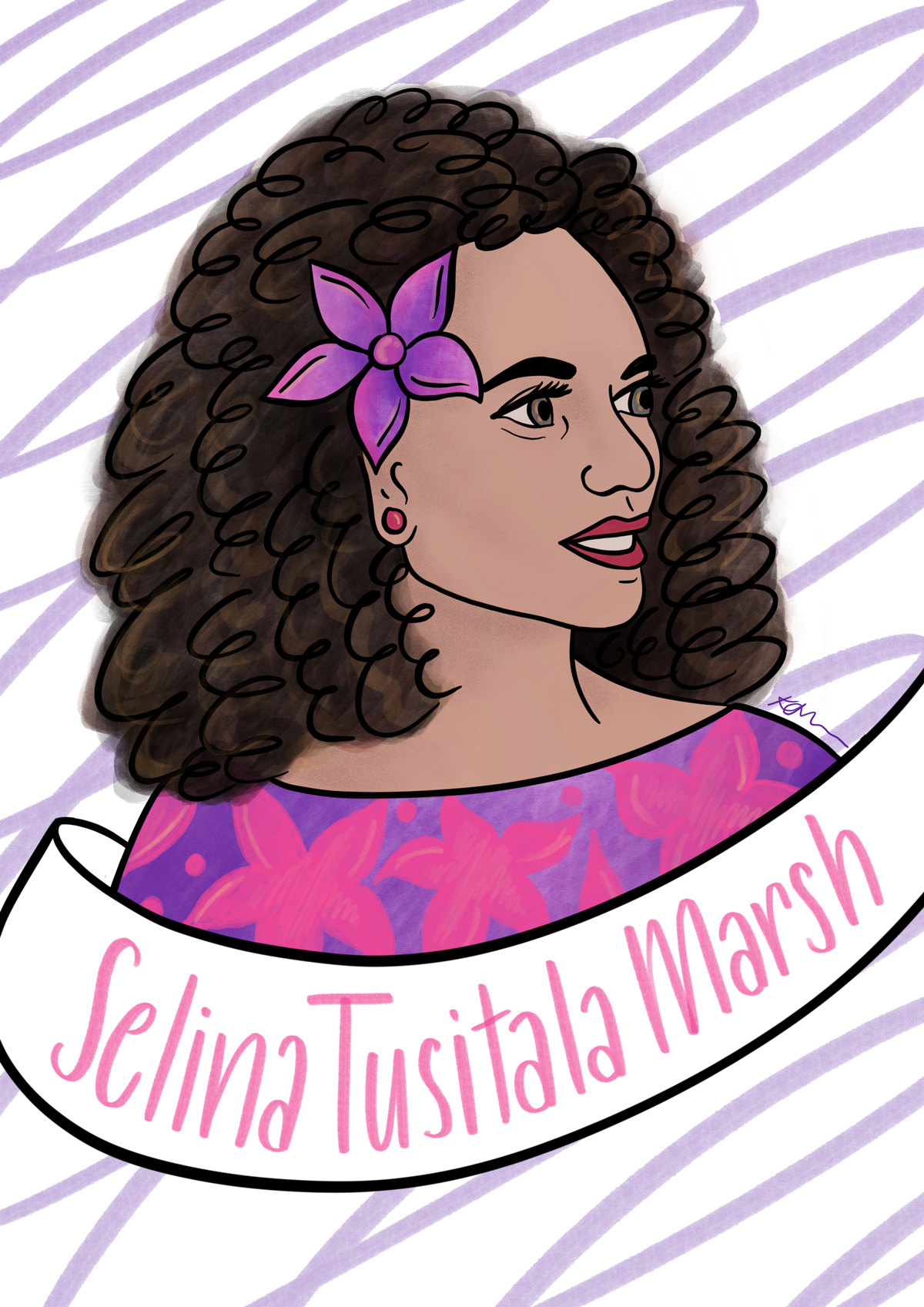
JANET FRAME
NOVELIST. SHORT STORY WRITER. ESSAYIST. POET
Nene Janet Paterson Clutha ONZ CBE
1924 – 2004
Nene Janet Paterson Clutha published under the name Janet Frame and became one of New Zealand’s most distinguished and celebrated writers of fiction, nonfiction and poetry.
Born in Dunedin, Janet grew up in Oamaru. In 1945, she was admitted to Seacliff Lunatic Asylum following an emotional breakdown where she was diagnosed as schizophrenic and treated with electroconvulsive therapy. In 1951, while still at Seacliff, Janet’s first volume of short stories, The Lagoon and Other Stories, was published and it was awarded New Zealand’s only literary prize just days before she was to have a lobotomy. The operation, which would have left her unable to write, was immediately cancelled.
Janet moved to London in 1956. Her new psychiatrist told her she was not mentally ill and had been misdiagnosed. He encouraged her to keep writing and the next seven years were her most productive. Many found her writing difficult to read and her narrative style was ahead of its time. In 1964, Janet returned to New Zealand and, during the 1980s, she wrote her autobiography, partly to ‘set the record straight’ about her decade in mental institutions.
Janet was awarded several honorary doctorates and medals, including a CBE for her services to literature. In 1990, she became the 16th appointee to New Zealand’s highest honour, The Order of New Zealand and was nominated for a Nobel Prize in Literature. Yet all her life Janet remained a very private person, untouched by the idea that she was a genius and a world renowned author.
More to Read:
To The Is-Land (1982), Janet’s autobiography Volume 1
An Angel at My Table (1984) autobiography Volume 2
The Envoy from Mirror City (1985) autobiography Volume 3
More to Watch:
An Angel at My Table - 1990 film directed by Jane Campion
Bibliography
http://www.janetframe.org.nz/Biography.htm
https://www.theguardian.com/news/2004/jan/30/guardianobituaries.booksobituaries
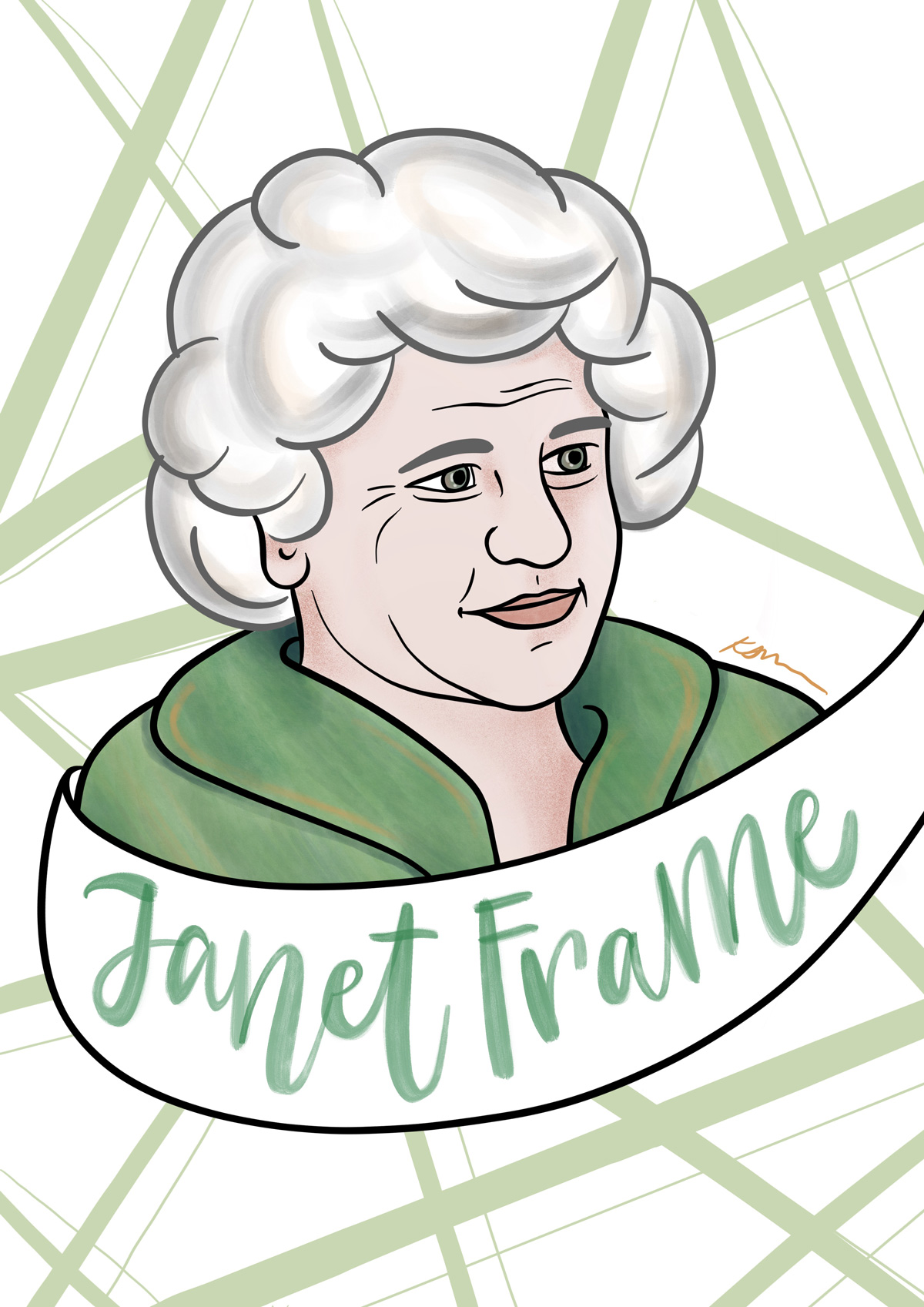
NANCY WAKE
WWII SECRET AGENT “THE WHITE MOUSE”
Nancy Grace Augusta Wake AC, GM
1912 –2011
Feisty and courageous Nancy became a fearless WWII Secret Agent. Born in Wellington Nancy moved to Australia with her family as a child. When she was 16 she ran away from home. Using a gift from her New Zealand aunt, she travelled to America and on to Europe, where she worked as newspaper correspondent. In 1939, Nancy married wealthy French industrialist Henri Fiocca, and was living a luxurious life in Marseille when Germany invaded France the following year.
Nancy joined the Resistance and helped more than a thousand escaped prisoners of war and downed Allied airmen reach the safety of Spain. Nancy was so skilled at evading the Gestapo that they nicknamed her “The White Mouse.” By 1943, she was at the top of the Gestapo’s ‘most wanted’ list. Five million francs were offered for her capture. In 1944 Nancy escaped to England and became a Special Operations Executive agent. She parachuted back into central France and led an army of 7,000 resistance fighters in guerrilla warfare against the Nazis. At the age of 89 she claimed she had never been afraid in her life. Once, when her wireless radio was broken, she cycled almost 400 km in three days through German territory, to deliver the message.
Immediately after the war Nancy’s heroic achievements were recognised by Britain, France and the Unites States. She became one of the most highly decorated women of WW II. However, it was not until 2006 that the New Zealand Returned Services Association awarded Nancy their highest honour, the RSA Badge in Gold, at last recognising her wartime work with the French resistance.
Though away from New Zealand for 80 years, Nancy retained her New Zealand passport and considered herself a kiwi. She died in London, aged 98 and as requested her ashes were scattered near the village of Verneix in central France.
A resistance comrade described Nancy as the “… most feminine woman I know, until the fighting starts. Then, she is like five men.”
Bibliography:
http://www.nzedge.com/legends/warriors/nancy-wake/
https://en.wikipedia.org/wiki/Nancy_Wake
More to Read:
The White Mouse by Nancy Wake, Pan Macmillan, 1985)

DAME SILVIA CARTWRIGHT
DISTINGUISHED JURIST AND GOVERNOR GENERAL
The Honourable Dame Silvia Rose Cartwright PCNZM DBE QSO DStJ
b. 1943
Dame Silvia is one of New Zealand's most distinguished woman jurists whose intellect and compassion have won her international respect. When she graduated from the University of Otago’s law school in 1967, law firms were reluctant to employ women. Eventually she was offered a job and quickly earned the respect of her colleagues but her requests for equal pay were repeatedly declined.
Throughout her career Dame Silvia has worked to eliminate discrimination against women. In 1988, she led the Cartwright Inquiry into cervical cancer treatment at Auckland's National Women's Hospital. Her report recommended the appointment of a Health and Disability Commissioner and was the catalyst for widespread changes in all aspects health consumer rights. The following year she was made a Dame Commander of the Most Excellent Order of the British Empire (DBE) for her services to women.
Dame Silvia was appointed as New Zealand’s first female Chief District Court Judge and High Court Judge. In 2001,she became New Zealand’s second female Governor General. Dame Silvia broke with convention and spoke out on issues such as prison reform and child abuse. She described her sometimes controversial five-year term as ‘all consuming’.
In 2007, Dame Silvia moved to Phnom Penh following her appointment as an international judge on the Cambodian War Crimes Tribunal. She regarded her seven years on the tribunal as her greatest professional challenge. In 2015, she moved to the High Commission of Human Rights in Geneva to advise on an investigation into human rights abuses during the civil war in Sri Lanka.
“She is an ordinary woman who has done extraordinary things, through kindness, truth and virtue.” - Dame Sian Elias
Bibliography
https://www.womens-health.org.nz/consumer-rights/cartwright-inquiry/
https://en.wikipedia.org/wiki/Silvia_Cartwright
http://www.nzherald.co.nz/nz/news/article.cfm?c_id=1&objectid=10393582
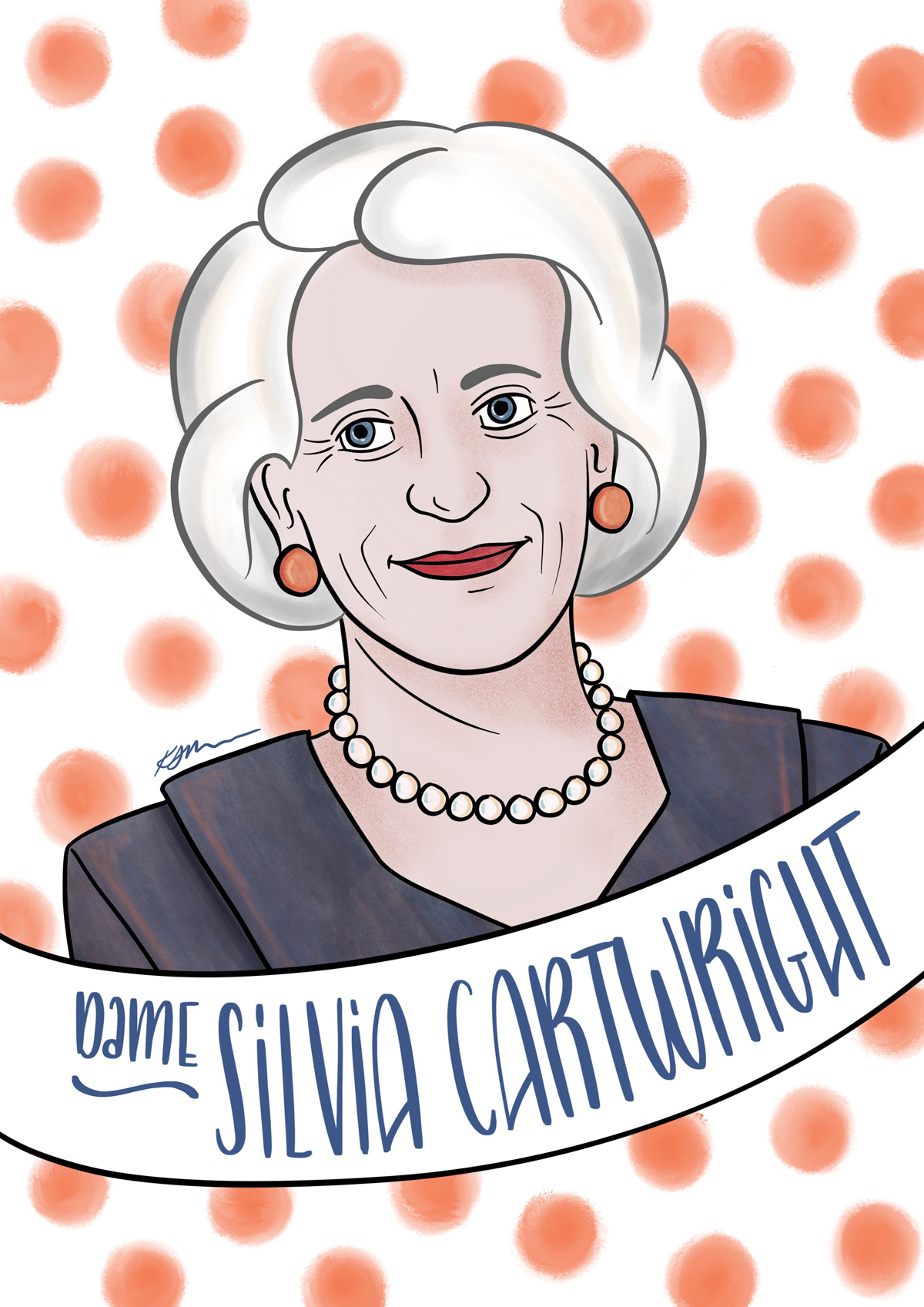
KATHERINE MANSFIELD
MODERNIST SHORT STORY WRITER
Kathleen Mansfield Murry
1888-1923
Her writing revolutionised the 20th Century short story and at the time of her early death, Katherine had already built an international reputation based on just three volumes of short stories.
Katherine grew up in Wellington and finished her schooling in London. On returning to New Zealand she rebelled against the restricted, conventional life of her socially-prominent family and, at 20, left New Zealand permanently.
In Europe, she lived a libertine, bohemian life and was a friend of writers D.H. Lawrence and Virginia Woolf. Virginia said: "I was jealous of her writing—the only writing I have ever been jealous of”. Katherine’s experiences alone in Germany following a miscarriage formed the basis of her first published short story collection, In a German Pension (1911). After her beloved brother was killed in World War I, her stories were often nostalgic recreations of the New Zealand childhood they had shared.
In 1916, Katherine met Middleton Murry. Their relationship was one of frequent acrimonious partings followed by reconciliations. They eventually married in 1918.
In 1917, Katherine was diagnosed with tuberculosis and moved to the south of France. This was her most prolific period of writing and she published her second collection of stories, Bliss, in 1920, and The Garden Party in 1922.
In 1922, disillusioned with conventional medicine, Katherine entered the Gurdjieff Institute for the Harmonious Development of Man at Fontainebleau-Avon where she died the following year. After her death, Middleton Murry published two further volumes of Katherine’s short stories together with her letters and notebooks.
“Risk, risk anything! Care no more for the opinions of others…Act for yourself’.”
- Katherine Mansfield
More to Read:
Bliss and Other Stories (1918)
Bibliography
http://nzetc.victoria.ac.nz/tm/scholarly/tei-ManBlis.html
http://www.editoreric.com/greatlit/authors/Mansfield.html
http://www.nzedge.com/legends/katherine-mansfield/
https://www.poetryfoundation.org/poets/katherine-mansfield
The Book of New Zealand Women / Ko Kui Ma Te Kaupapa. Bridget Williams (ed), Charlotte Macdonald (ed), Merimeri Penfold (ed). Bridget Williams Books, 1991

ELIZABETH McCOMBS
NEW ZEALAND’S FIRST ELECTED FEMALE MEMBER OF PARLIAMENT
Elizabeth (Bessie) Reid McCombs
1873 –1935
In 1933, following the death of her husband, Labour MP James McCombs, 60 year old Elizabeth became New Zealand’s first female elected Member of Parliament. Many in the Labour party objected to her standing in the Lyttleton that James had held for 20 years, but she won it with a much increased majority.
Elizabeth and James married in 1903 and were both committed socialists who had dreams of being in parliament together. In 1916, James became the first Labour Party president and Elizabeth was elected to the party’s executive. She was the second woman elected to the Christchurch City Council in the early 1920s.
Elizabeth spent a lifetime campaigning for women. She was a founding member of the National Council of Women of New Zealand, local president of the Woman’s Christian Temperance Union and one of the founders of the first free kindergarten in Christchurch.
In parliament, Elizabeth fought to improve the welfare system and ensure better pay and working conditions for women. She also worked to increase the number of women in the police force. Though respected by her colleagues for her hard work, clear thinking, sympathetic understanding and singlemindedness, the newspapers of the time frequently called ‘Jimmy’s wife’ and on her first day in parliament they devoted columns to the fact that she had refused to wear a hat!
In 1935, she was awarded the King George V Silver Jubilee Medal but worsening health took its toll and she died later that year.
‘By her outstanding ability, both in the House and out, she made a very effective reply to those who maintained that women are not the equals of men, either in local or national government”.
- Michael Joseph Savage
Bibliography
Coney, Sandra: Standing in the Sunshine-A history of New Zealand Women since they won the vote. Penguin Books NZ Ltd, 1993
The Book of New Zealand Women / Ko Kui Ma Te Kaupapa. Bridget Williams (ed), Charlotte Macdonald (ed), Merimeri Penfold (ed). Bridget Williams Books, 1991
https://www.villainesse.com/think/brief-history-sexist-bullshit-new-zealand-politics
https://en.wikipedia.org/wiki/Elizabeth_McCombs
https://teara.govt.nz/en/biographies/4m3/mccombs-elizabeth-reid
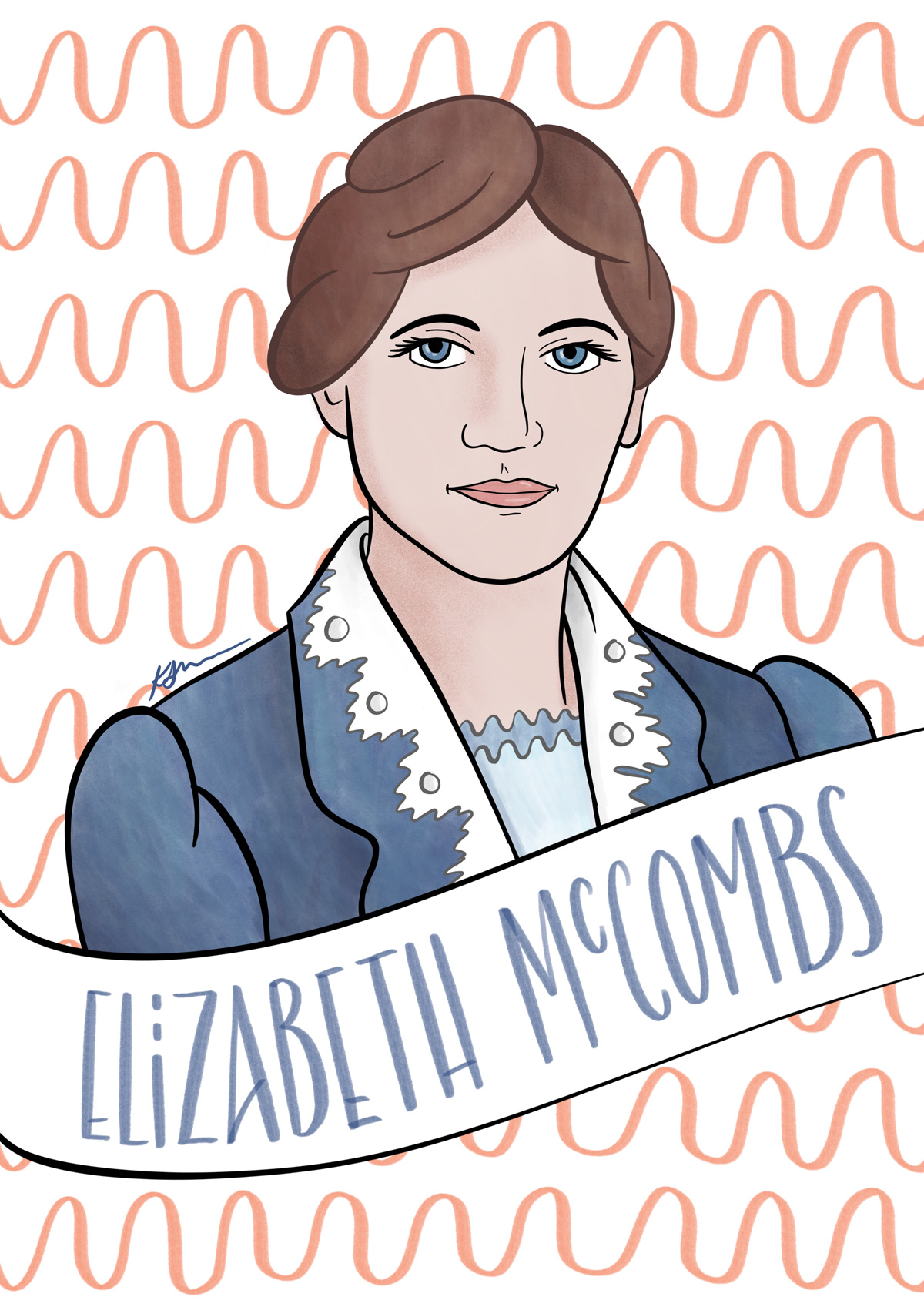
DAME VALERIE ADAMS
OLYMPIAN SHOT PUTTER
Dame Valerie Kasanita Adams DNZM
b. 1984
Dame Valerie is New Zealand’s greatest female track and field athlete. Just six months after the birth of her daughter, Kimoana, Dame Valerie stood on the podium at the 2018 Commonwealth Games, adding a silver Commonwealth shot put medal to her three Olympic (two gold), four Commonwealth (three gold), four World Outdoor and three World Indoor championship medals. In 2014, she was named World Indoor International Association of Athletics Federations (IAAF) World Athlete of the Year – the first New Zealander to win the award.
Born in Rotorua of Tongan and English decent, Dame Valerie was breaking regional junior records by the age of 13. As a young teen she met former javelin thrower Kirsten Hellier, who coached her for the next 11 years.
Dame Valerie was only 15 when she took three months off school to care for her dying mother. Together they watched the Sydney 2000 Olympics. Drawing inspiration from her late mother, Dame Valerie won the World Junior Championship the following year. Her first Olympics were in Athens in 2004 where she came seventh while still recovering from having her appendix out. Dame Valerie won her first Olympic gold in Beijing in 2008. This was New Zealand’s first track and field gold medal in 32 years.
Dame Valerie was New Zealand Sportswoman of the Year every year between 2006 and 2012, and won the Halberg Supreme Award three consecutive times from 2008. In 2017, she was made a Dame Companion of the New Zealand Order of Merit (DNZM).
“I could never see myself coming back after having a baby…I hope this inspires other mothers around the world…to do something active and healthy and live your dream.”
– Dame Valerie Adams
Bibliography
http://www.olympic.org.nz/athletes/valerie-adams/
https://www.thefamouspeople.com/profiles/valerie-adams-5544.php
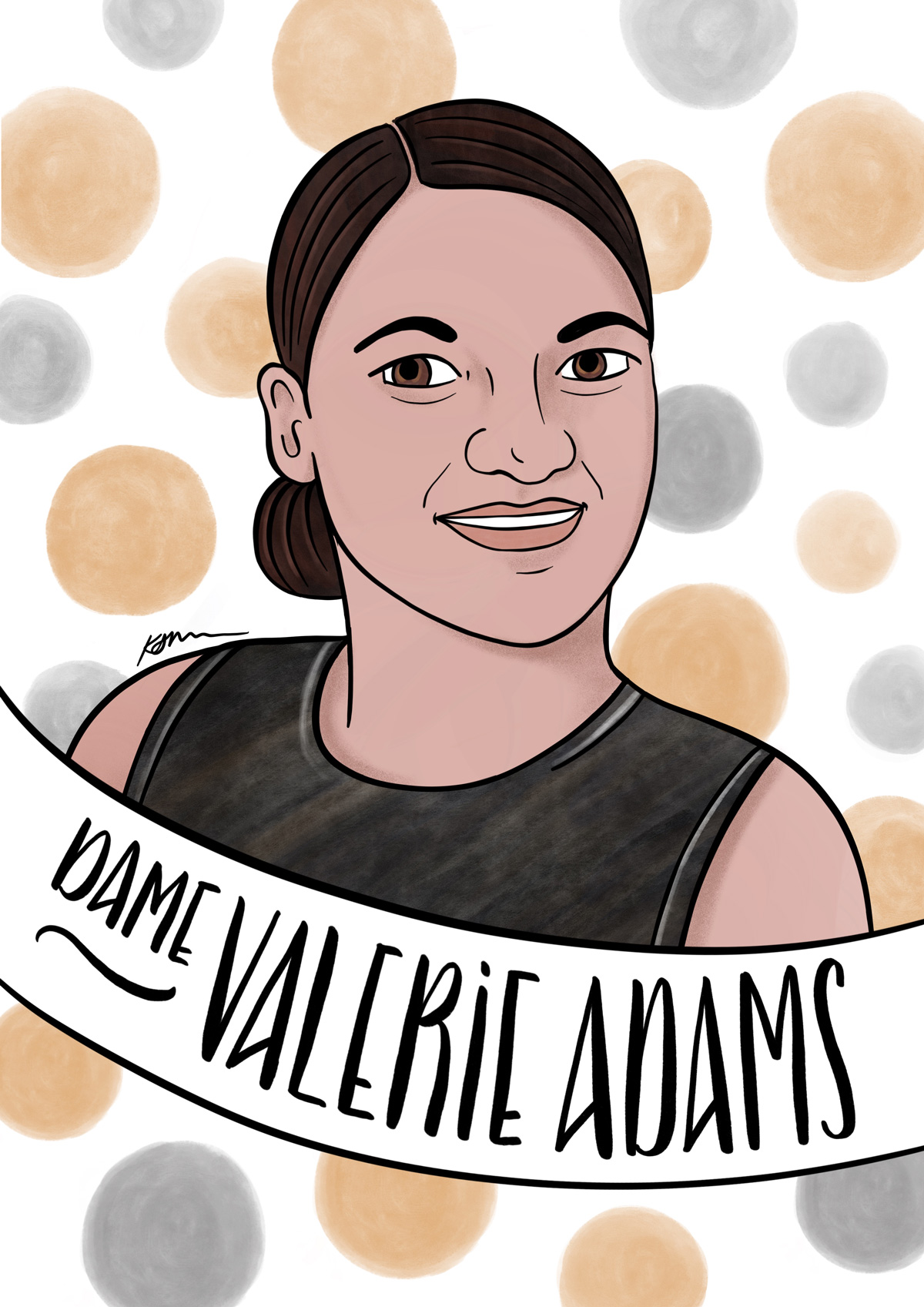
ELSA KIDSON
SOIL SCIENTIST AND SCULPTOR
Elsa Beatrice Kidson FRIC FNZIC FRSNZ
1905–1979
Elsa gained international recognition during the 1930s and 40’s for her ground-breaking research into cobalt and magnesium levels in plants and soil and she proved that cobalt deficiency was the cause of a common wasting disease in sheep and cattle. During WWII there was a severe shortage of citrus fruit and Elsa developed a method of fortifying apple juice and jam with a vitamin C powder made from Central Otago rosehips.
Her father died when she was three and Elsa and her three young brothers were raised in Nelson by her hardworking mother, Kittie, and her paternal grandfather. At Nelson College for Girls, Elsa won a scholarship to study at Canterbury College (now the University of Canterbury). In 1927, she graduated with a Master of Science degree with honours in organic chemistry and, over the next 30 years, published more than 44 scientific papers.
In 1952, the University of New Zealand awarded her a Doctorate of Science recognising her 17 years of soil science research. Elsa was the first female Fellow of the New Zealand Institute of Chemistry and first elected female Fellow of the Royal Institute of Chemistry. In 1963, she was elected a Fellow of the Royal Society of New Zealand (now the Royal Society Te Apārangi).
Elsa was also a skilled swordswoman and talented photographer. When she retired she studied sculpture at London’s Wimbledon School of Art and became well known for her life-sized sculptures of children’s heads.
Bibliography
The Book of New Zealand Women / Ko Kui Ma Te Kaupapa. Bridget Williams (ed), Charlotte Macdonald (ed), Merimeri Penfold (ed). Bridget Williams Books, 1991
Carol Markwell. 'Kidson, Elsa Beatrice', Dictionary of New Zealand Biography, first published in 2010. Te Ara - the Encyclopedia of New Zealand, https://teara.govt.nz/en/biographies/4k13/kidson-elsa-beatrice
https://royalsociety.org.nz/150th-anniversary/150-women-in-150-words/1918-1967/elsa-kidson/

HINEMATIORO
GREAT NGĀTI POROU CHIEFTAINESS
Hinematioro
c1750 - c1821
Ngāti Porou
It is said that when she was a young woman Hinematioro saw Captain James Cook and the crew of the Endeavour arrive at Ūawa (Tolaga Bay) in October, 1769. Hinematioro was a great chieftainess of the Ngāti Porou people. She spent most of her life in the Ūawa-Whangara district amongst the hapu Te Aitanga-a-Hauiti and Ngāti Konohi.
Her father, Tanetokorangi was a grandson to Konohi of Whangara and her mother Ngunguruterangi, was a great granddaughter of Rerekohu. Hinematioro was also the grandmother of the Ngāti Porou chief, Te Kani-a-Takirau.
Hinematioro was known for her kindness, hospitality and wise decisions. Such was her mana that she was fed the very best food and often carried on a litter by her people. The early missionaries described her as a 'great Queen' possessing a large territory and numerous subjects.
In about 1821, Hinematioro’s island fortress pā, Pourewa (Spooring Island, at Cook’s Cove), was attacked by a combined Tokomaru-Tūranga war party in the battle known as Paruparuwhatete. During the night Hinematioro left the pā on a waka, which capsized and she was drowned. Whangara elders believe her body was found and is buried at Te Ana-a-Paikea (Whangara Island).
Bibliography
Angela Ballara. 'Hinematioro', Dictionary of New Zealand Biography, first published in 1990. Te Ara - the Encyclopedia of New Zealand, https://teara.govt.nz/en/biographies/1h23/hinematioro (accessed 24 February 2018)
http://nzetc.victoria.ac.nz/tm/scholarly/tei-VUWMarae1986-t2-body-d4-d36-d1.html
https://maungakorero.wordpress.com/maunga-korero/issue-8-pukehapopo/hinematioro-you-cant-touch-this/

DAME LYNLEY DODD
CHILDREN’S AUTHOR AND CREATOR OF HAIRY MACLARY
Dame Lynley Stuart Dodd DNZM
b. 1941
When she sent her scruffy little canine creation off on his first adventure to Donaldson’s Dairy in 1983, Lynley had no idea that 27 more Hairy Maclary adventures would follow. She is internationally celebrated for her combination of humorous illustrations and memorable, alliterative rhyme that children and adults love to read aloud. Hairy Maclary and his gang of furry and feathered friends are now some of the most loved characters in New Zealand writing .
As a child, Lynley was a voracious reader and a big fan of Dr. Seuss. She grew up in a quiet rural area near Taupo – an environment that encouraged her imagination. She gained a Diploma of Fine Arts from the Elam School of Fine Arts and in 1973, Lynley illustrated Eva Sutton’s book My Cat likes to Hide in Boxes.Shortly after she wrote and illustrated The Nickle Nackle Tree. Forty titles followed. Neighbourhood pets inspired her characters; Whooskers, an ex SPCA cat became Slinki Malinki; Scarface Claw was modelled on a battered local cat called Squib.
She thinks adults often underestimate the skill involved in writing for children and Lynley may redraft a story 25 times before she is happy. Reviewers often try to find deeper meaning in her books but Lynley
says she is ‘out to entertain, pure and simple’.
In 1999, Lynley was awarded the Storylines Margaret Mahy Medal, New Zealand’s most prestigious honour for children’s authors, illustrators and publishers and in 2001 she was made a Distinguished Companion of the New Zealand Order of Merit (DCNZM) for her services to Children’s literature.
“A good picture book has the power to pull children away from their devices.” - Dame Lynley Dodd
Bibliography
https://en.wikipedia.org/wiki/Lynley_Dodd
http://www.bookcouncil.org.nz/writer/dodd-lynley/
http://www.nzherald.co.nz/nz/news/article.cfm?c_id=1&objectid=786871
http://www.nzherald.co.nz/bay-of-plenty-times/news/article.cfm?c_id=1503343&objectid=11489332
https://www.stuff.co.nz/entertainment/books/97541800/lynley-dodd-the-rhymer

DAME KIRI TE KANAWA
SOPRANO
Dame Kiri Janette Te Kanawa ONZ DBE AC
b. 1944
Her 1971 role as the countess in Mozart’s Marriage of Figaro launched Dame Kiri’s stellar 45-year international operatic career. She initially trained in operatic singing with Dame Sister Mary Leo at St Mary’s College in Auckland. Dame Kiri’s recording of The Nun’s Chorus became New Zealand’s first gold-selling record.
In the mid-sixties, Dame Kiri won the New Zealand Mobil Song Quest and the Melbourne Sun Aria contest and moved to London to study at the London Opera Centre. Dame Kiri most often played the roles of princesses and nobility in the operas of Strauss, Mozart, Verdi, Handel and Puccini.
More than 600 million people heard her sing Handel’s Let the Bright Seraphim at the royal wedding of Prince Charles and Lady Diana Spencer in 1981. Dame Kiri never performed the work again following Diana’s death in 1997.
Later in her career, Dame Kiri often included songs such as Pōkarekare Ana and Hine e Hine in her concert programs. She announced her retirement in 2017.
Dame Kiri now trains dedicated, talented young New Zealand singers through the Dame Kiri Te Kanawa Foundation, helping them develop international careers at the highest levels.
In 1982, Dame Kiri was appointed a Dame Commander of the Most Excellent Order of the British Empire (DBE) for her services to opera and, in 1995, she was appointed to the Order of New Zealand.
“I couldn’t believe my ears. I’ve taken thousands of auditions, but it was such a fantastically beautiful voice.”
- Colin David, Conductor
Bibliography
https://nzhistory.govt.nz/media/video/Dame Kiri-te-kanawa
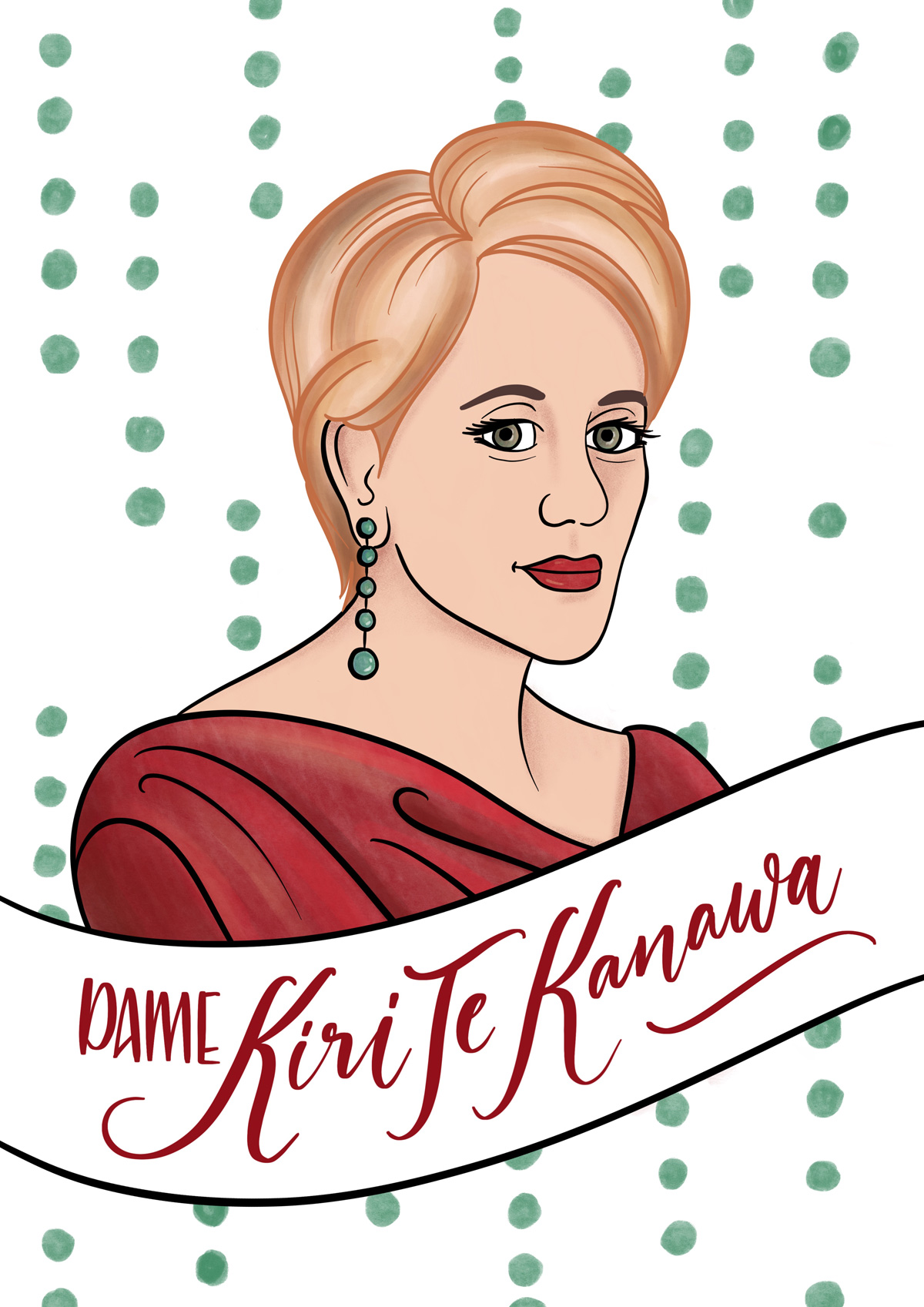
Alma Johnson
NZ’S FIRST WOMAN TELEVISION PRESENTER
Alma Rae Johnson
1931 –2017
In 1960 television was new to New Zealand. Reception was poor, and the black and white programs ran for just three hours a day, three nights a week. In 1961 Alma became the first woman presenter on New Zealand television, working as a continuity announcer. Alma said her job was to sit at a desk and act as a hostess, saying “Good evening and welcome to tonight’s program,” in very formal English.
By the mid 1960’s Alma was a household name, but she always thought of herself as a public servant and certainly not as a celebrity. People would stop her in the street and give advice on how she should dress on screen. Hair was very important - and bouffant was the style of the day. Alma’s hair was indeed very bouffant. She continued working as television presenter through the 1960’s and 70’s. Alma was also a highly respected speech and drama teacher and she continued to teach with enthusiasm and passion into her final years.
Bibliography

FRANCES HODGKINS
AVANT-GARDE ARTIST
Frances Mary Hodgkins
1869 – 1947
With a professional painting career spanning more than 50 years, Frances is considered one of the outstanding artists of her generation. Growing up in Dunedin, her father William was an accomplished landscape painter. Both Frances and her elder sister Isabel inherited their father’s artistic talents and painting and exhibiting were a normal part of their family life.
In 1901 Frances left New Zealand and studied, travelled, painted and exhibited in England and Europe. She held her first solo exhibition in London in 1907 and then moved to Paris for four years. There she was influenced by the impressionists and the post impressionists. In 1910 she was the first woman to teach at the Académie Colarossi. The following year she started her own successful School for Water Colour. Frances returned briefly New Zealand to exhibit her work, but left permanently in 1913. When Frances was in her late 60’s her work became more abstract and incorporated modernist ideas and she became established with a group of progressive young painters in England. By the end of her career she was a key figure in British Modernism.
The peak of her career was a Frances Hodgkins retrospective held at the Lefevre Gallery in November 1946. The exhibition included 64 paintings and 17 drawings produced between 1902 and 1946.
Frances prized her independence and was single-mindedly devoted to her career. Her courage and dedication have inspired many emerging artists. The London Press described Frances as one of the most remarkable women painters of all time.
Bibliography
Linda Gill. 'Hodgkins, Frances Mary', Dictionary of New Zealand Biography, first published in 1993. Te Ara - the Encyclopedia of New Zealand, https://teara.govt.nz/en/biographies/2h41/hodgkins-frances-mary (accessed 21 January 2018)
The Book of New Zealand Women / Ko Kui Ma Te Kaupapa. Bridget Williams (ed), Charlotte Macdonald (ed), Merimeri Penfold (ed). Bridget Williams Books, 1991
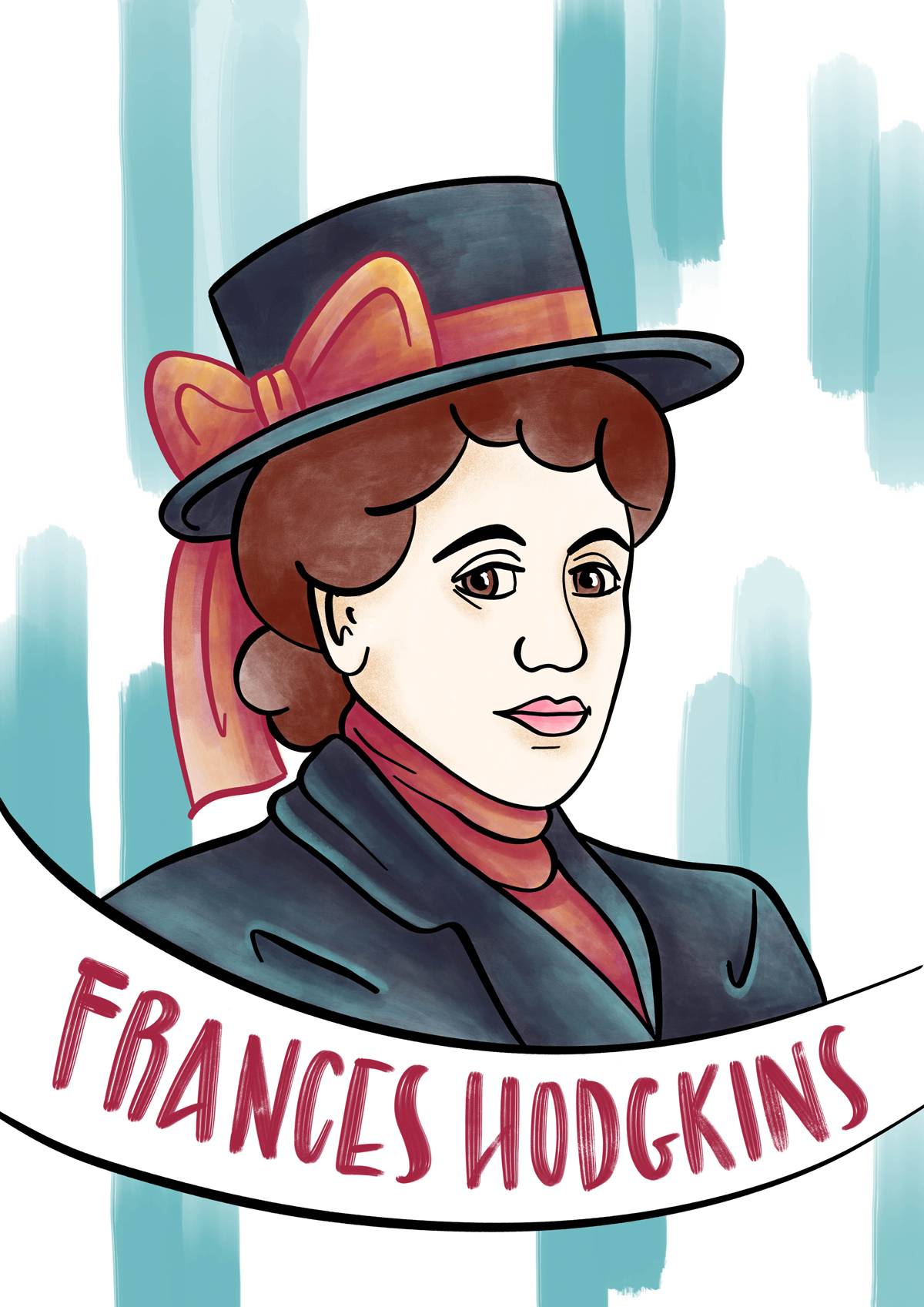
DAME JANE CAMPION
SCREENWRITER. PRODUCER. DIRECTOR
Dame Elizabeth Jane Campion DNZM
b. 1954
Following a childhood immersed in the New Zealand theatre world of her parents, Dame Jane initially chose to study Anthropology at Victoria University and art at the Chelsea Art School. In the early 1980’s she became frustrated with the creative limitations of painting and began four years of study at the Australian Film, Television and Radio School.
Dame Jane is now one of New Zealand’s most acclaimed film makers, having made some of cinema’s strangest and strongest films. Often they are dreamily surrealistic and mental illness is a recurring theme. Many of her films are immersed in the everyday experiences of women.
Dame Jane’s first feature film was Sweetie (1989). The following year she portrayed the New Zealand writer Janet Frame in the highly acclaimed Angel at my Table. But it was with The Piano (1993) that Dame Jane gained global recognition when she became the first woman director to be awarded the Palme D’or at the Cannes Film Festival. The Piano also won an Oscar for Best Original Screen play and Dame Jane was nominated for Best Director.
In recent years Dame Jane has moved from film to television, writing and directing the highly acclaimed mini-series Top of the Lake. She feels television now offers her more creative freedom than film.
Twenty five years on, no other woman film director has received the Palme D’or and Dame Jane is one of only five women ever nominated for an Oscar for Best Director. In 2013, the French Film Directors' Society awarded Dame Jane the Carrosse d'Or, recognising her “innovative qualities, courage and independent-mindedness in directing." In 2016, she was appointed a Dame Companion of the New Zealand Order of Merit for her services to film.
“Jane Campion has never made an uninteresting or unchallenging film … The Piano is as peculiar and haunting as any film I've seen.”
- American critic Roger Ebert, November 1993
Bibliography
https://en.wikipedia.org/wiki/Jane_Campion
https://www.theguardian.com/film/2017/jul/22/jane-campion-clever-people-film-tv-top-of-the-lake
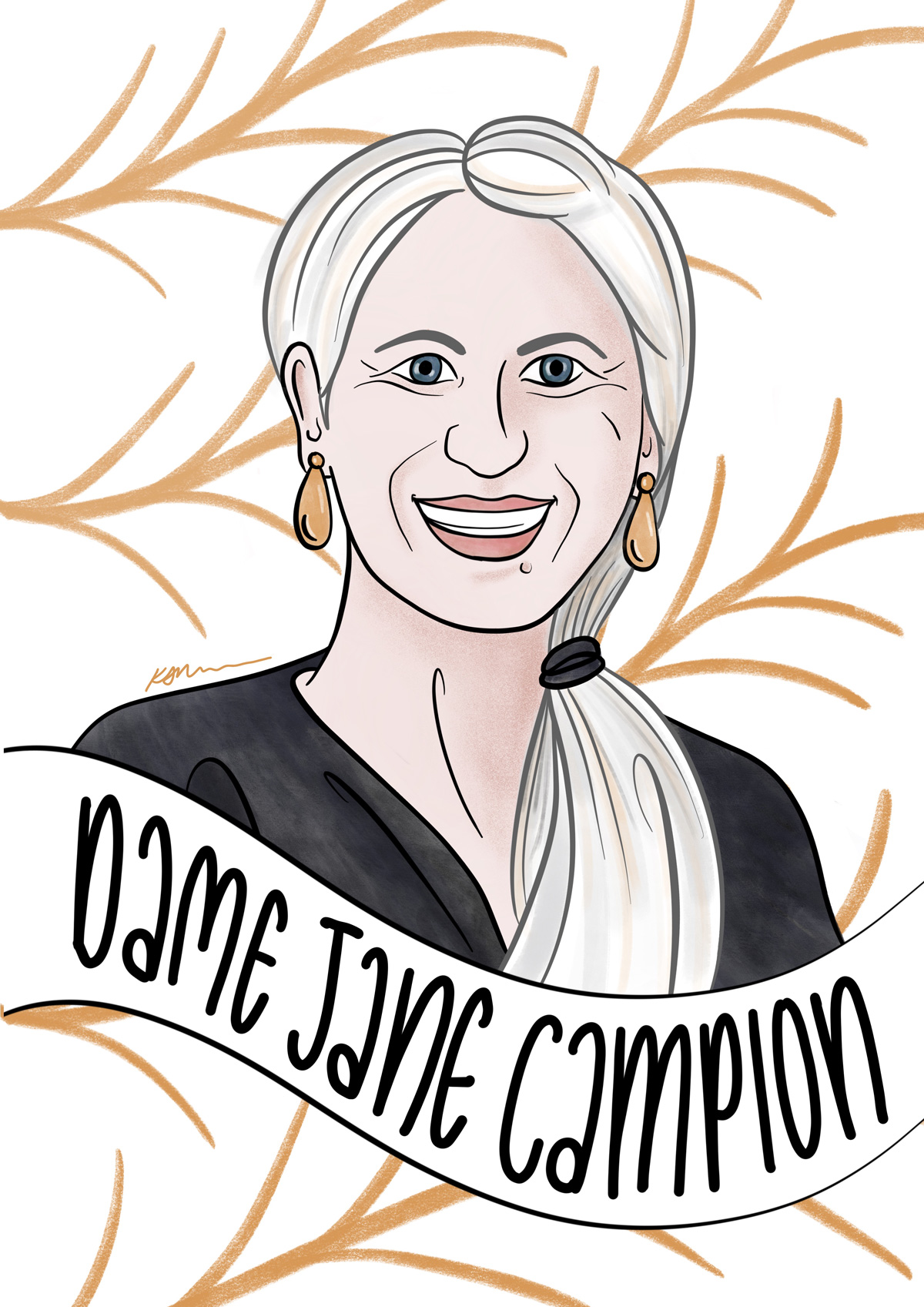
MERI TE TAI MANGAKAHIA
WOMAN OF MANA AND SUFFRAGIST
Meri Te Tai Mangakahia
1868 – 1920
Te Rarawa
Meri Te Tai was a descendant of Te Rarawa chiefs of the highest mana from Waihou, northern Hokianga. She went to school at St Mary’s Convent in Auckland and later married Hamoria Mangakahia, of Ngāti Whanaunga from Whangapoua, Coromandel. He was involved with the Kotahitanga Māori parliamentary movement.
Meri Te Tai was on a committee formed by the wives of the Kotahitanga leaders. In May 1883 she became the first woman to speak to the Kotahitanga parliament, requesting the right for women to vote and to be members of the parliament. Meri Te Tai was concerned that under colonial law, Māori women landowners were losing their rights to inherit and manage their lands. She believed the appeals of the chiefs to Queen Victoria to protect Māori lands had not helped Māori women. Meri Te Tai felt the Queen would be more likely to listen to requests from women.
In 1897 Māori women won the right to vote in the Kotahitanga Parliamentary elections.
Meri Te Tai continued to be active in Māori politics welfare. She started a column named Te Reiri Karamu (‘The Ladies’ Column’) in partnership with Niniwa i te Rangi of Wairarapa. The articles and letters published in the column show Māori women robustly debating women’s issues. Meri Te Tai is remembered as a suffragist who inspired future generations of Māori women. She died of influenza in 1920 and is buried at the Pureirei cemetery, Lower Waihou, near her father.
Bibliography
Coney, Sandra: Standing in the Sunshine-A history of New Zealand Women since they won the vote. Penguin Books NZ Ltd, 1993
The Book of New Zealand Women / Ko Kui Ma Te Kaupapa. Bridget Williams (ed), Charlotte Macdonald (ed), Meri Te Tai Meri Te Tai Penfold (ed). Bridget Williams Books, 1991
Angela Ballara. 'Mangakahia, Meri Te Tai Te Tai', Dictionary of New Zealand Biography, first published in 1993. Te Ara - the Encyclopedia of New Zealand, https://teara.govt.nz/en/biographies/2m30/mangakahia-Meri Te Tai -te-tai (accessed 7 March 2018)
https://en.wikipedia.org/wiki/Meri Te Tai _Te_Tai_Mangak%C4%81hia
https://www.radionz.co.nz/news/te-manu-korihi/255059/Meri Te Tai -te-tai-honoured-on-suffrage-day
https://unwomen.org.nz/news/speeches/international-womens-day-dame-anne-salmonds-speech
'Meri Te Tai Mangakāhia, advocate for Māori women ', URL: https://nzhistory.govt.nz/media/photo/so-that-women-can-get-the-vote, (Ministry for Culture and Heritage), updated 7-Mar-2018

DAME NGAIO MARSH
"QUEEN OF CRIME"
Dame Edith Ngaio Marsh DCBE
1895 – 1982
Recognised worldwide as one of the original four “Queens of Crime”, Dame Ngaio dominated the golden age of crime fiction writing in the 1920’s and 30’s and became one of New Zealand’s most successful authors.
As well as writing crime novels, Dame Ngaio also wrote short stories, drama scripts and non-fiction. But she wasn’t just a writer- she was also a theatre producer, a painter and a critic.
Dame Ngaio was a very tall, imposing figure and she often wore dramatically styled designer clothes. She had a distinctive, deep voice and spoke with a particularly ‘cultured accent’- Dame Ngaio never really liked the New Zealand accent!
After studying art at the University of Canterbury she toured with theatre companies before writing her first “whodunit” in 1931. Dame Ngaio went on to write 32 detective novels centred on the character of Roderick Alleyn, a gentleman detective working for the London Metropolitan Police. Millions of copies of her novels have been sold and her books are still in print today.
In the 1940’s Dame Ngaio returned to the theatre and with her imaginative, meticulous, autocratic style she directed over 20 full scale Shakespearean productions with the Drama Society in Christchurch.
Dame Ngaio never stopped writing and she published her final detective novel in 1982, just before her death at the age of 87.
Bibliography
Jane Stafford. 'Marsh, Edith Ngaio', Dictionary of New Zealand Biography, first published in 1998. Te Ara - the Encyclopedia of New Zealand, https://teara.govt.nz/en/biographies/4m42/marsh-edith-ngaio (accessed 17 December 2017)
https://en.wikipedia.org/wiki/Ngaio_Marsh
Title: Ngaio Marsh, 1895–1982 Author: Bruce Harding
Publication details: Victoria University of Wellington, 2008, Wellington
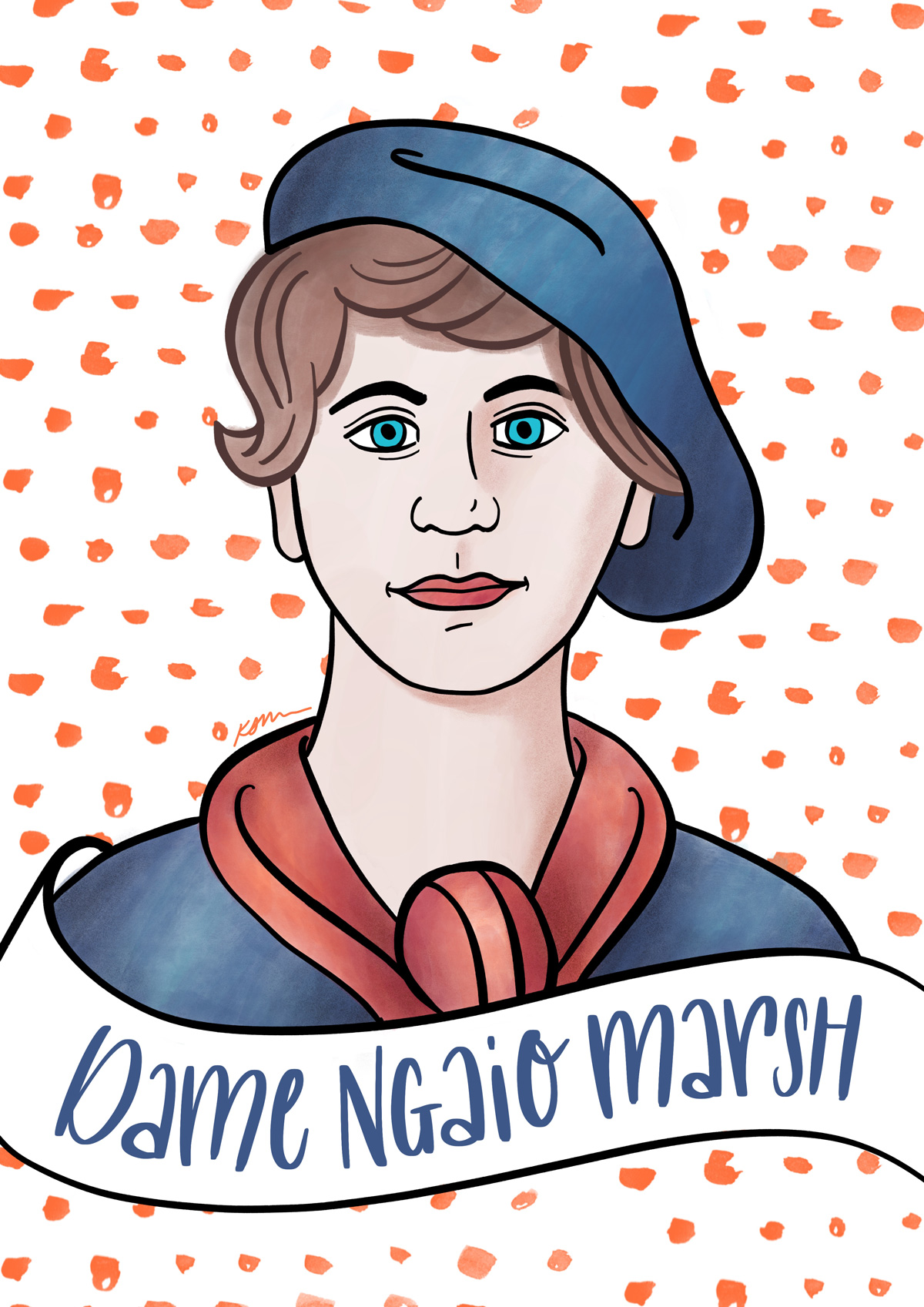
DAME SISTER MARY LEO
CATHOLIC NUN, MUSIC AND SINGING TEACHER
Dame Sister Mary Leo, DBE
1895 –1989
When Kathleen Agnes Niccol entered St Mary’s Convent to join the Sisters of Mercy she took the name of Sister Mary Leo. From 1930 she was in charge of music at St Mary's College and trained some of the world’s finest sopranos.
Dame Sister Mary Leo had no formal training in vocal technique and said she didn’t follow any particular method. Instead she had her own approach to teaching, which was tailored to each of her pupils. The result was a pure, floating quality of sound, known as bel canto, that became a hallmark of her pupils' singing. Dame Sister Mary Leo was sustained by her deep religious beliefs. She believed that both her pupils’ voices and her ability to creatively train those voices, were gifts from God.
She was a perfectionist, very sparing with her praise and expected ‘nothing less than one’s best.’ Some students found her too severe and demanding but most, especially her mature students, found her warm and affectionate. Her most famous pupils include Dames Malvina Major, Kiri Te Kanawa and Heather Begg. All three became world acclaimed sopranos. Dame Sister Mary Leo became a Dame Commander of the Order of the British Empire (DBE) in 1973.
Bibliography
Margaret Lovell-Smith. 'Niccol, Mary Leo', Dictionary of New Zealand Biography, first published in 1998. Te Ara - the Encyclopedia of New Zealand, https://teara.govt.nz/en/biographies/4n8/niccol-mary-leo (accessed 2 February 2018)

HURIA MATENGA
TRIBAL LEADER, LANDOWNER AND HEROINE
Huria Matenga
c. 1842 –1909
Ngāti Tama, Te Ati Awa and Ngāti Toa
Of Māori descent, Huria identified with the Ngāti Tama, Ngāti Toa and Te Ati Awa iwi and she could trace her genealogy back to an ancestor in the Tokomaru canoe. Her parents, Wikitoria Te Amohau of Ngāti Te Whiti and Wiremu Katene Te Puoho were leaders of the settled community at Whakapuaka, near Nelson. In 1858 Huria married Hemi Matenga Wai-punahau, who owned much land in the Waikanae area. Huria also held significant areas of land in Porirua and Taranaki.
On the stormy night of September 3, 1863, the brig Delaware was wrecked on rocks at the foot of the cliffs at Whakapuaka, near Nelson. Huria, her husband and three others repeatedly swam into the wild surf, heroically rescuing all but one of the crew and passengers. The newspapers praised both Huria’s bravery and her beauty. At the time there was fighting between Māori and Pākehā in Waikato and Taranaki and her selfless actions were welcomed as a sign of a common humanity between the two races.
The government recognised Huria’s heroic actions with an award of £50 and the people of Nelson raised enough money for a gold watch, which was presented to her at a ceremony in the Nelson town hall. Huria’s bravery made her one of the few Māori women of her time to have a permanent place in Pākehā history and more than more than 2,000 Māori and Pākehā attended her tangi in 1909.
Bibliography
Mary Louise Ormsby. 'Matenga, Huria', Dictionary of New Zealand Biography, first published in 1990. Te Ara - the Encyclopedia of New Zealand,
https://teara.govt.nz/en/biographies/1m24/matenga-huria (accessed 24 February 2018)

CONSTANCE BARNICOAT
INTERPRETER, JOURNALIST AND MOUNTAINEER
Constance Alice Barnicoat
1872 – 1922
Constance was an intrepid traveller who worked in Europe as a highly respected, multilingual journalist and interpreter. She came to know Lenin and Trotsky and was a passionate supporter of the war against German Imperialism. Home schooled in Nelson, Constance went on to complete a BA at the University of Canterbury and then worked as New Zealand’s first official female shorthand reporter. In England, she became fluent in four languages and attended the 1899 Hague Peace Conference as a secretary and interpreter. Constance settled in Switzerland with her husband Julian Grande. They both worked as correspondents for British, American and New Zealand newspapers and she became one of the most respected women journalists of her time.
Constance was a passionate mountaineer and the first woman to cross the Copeland Pass from the Hermitage (Aoraki/Mt Cook) to Westland. Though quiet, she was also persevering and indomitable. For the climb she defied the strict, impractical dress codes for women of the day, instead wearing practical heavy boys’ boots, a white wool jersey and trousers. Her greatest mountaineering achievement was her 1911 winter ascent of the 4000m Great Schreckhorn in the Swiss Alps.
After her untimely death, her husband Julian honoured her dying wish and travelled to New Zealand to meet her family and friends. He climbed a peak in Westland and named it Peak Barnicoat in her honour.
Bibliography
Coney, Sandra: Standing in the Sunshine-A history of New Zealand Women since they won the vote. Penguin Books NZ Ltd, 1993
Janet McCallum. 'Barnicoat, Constance Alice', Dictionary of New Zealand Biography, first published in 1996. Te Ara - the Encyclopedia of New Zealand, https://teara.govt.nz/en/biographies/3b10/barnicoat-constance-alice (accessed 8 January 2018)
http://www.theprow.org.nz/people/constance-barnicoat/#.WmP0u66WaUk

KAREN WALKER
NEW ZEALAND FASHION MOGUL
Karen Elizabeth Walker CNZM
b. 1969
As one of New Zealand’s most successful fashion designers, Karen Walker has become a global brand in the highly competitive fashion industry. Karen now has 1020 stores, in 200 cities, in 42 different countries, and she has chosen to stay based in New Zealand. She started sewing Barbie clothes on her grandmother’s machine when she was five and by the time she was 25 she had established her first outlet stores. In 1998 Karen showed her first runway collection and she is the only New Zealand designer to show at London Fashion Week. Today her designs are worn by celebrities worldwide.
Karen admits to being a rebel and an outsider, never one to just go with the flow. She’s committed to excellence and has a down-to-earth approach to business and creativity, which has inspired new generations of aspiring Kiwi fashion designers.
Thinking outside the box has helped Karen drive her brand in new directions. She collaborates with a range of New Zealand businesses. In addition to her ready to wear range, she now offers eyewear, jewellery, handbag collections and even a paint range. Karen has displayed her styles beside titles from New Zealand’s oldest bookstore, and recently she worked with the Cook Island Kuki 'Airani Creative Māmās, creating a tivaivai dress that was revealed at Buckingham Palace.
For more than a decade Karen has been an ambassador for the Breast Cancer Foundation and has designed one-off jewellery pieces and clothing for auction to raise funds for the Trust. In 2014 she was made a Companion of the New Zealand Order of Merit (CNZM)
Bibliography
https://en.m.wikipedia.org/wiki/Karen_Walker_(designer)
https://www.nbr.co.nz/article/2014-new-year-honours-top-10-profiles-ng-150496 https://www.tvnz.co.nz/one-news/new-zealand/biographies-new-zealander-year-semifinalists
http://www.viva.co.nz/article/culture-travel/karen-walker-and-david-hedley/
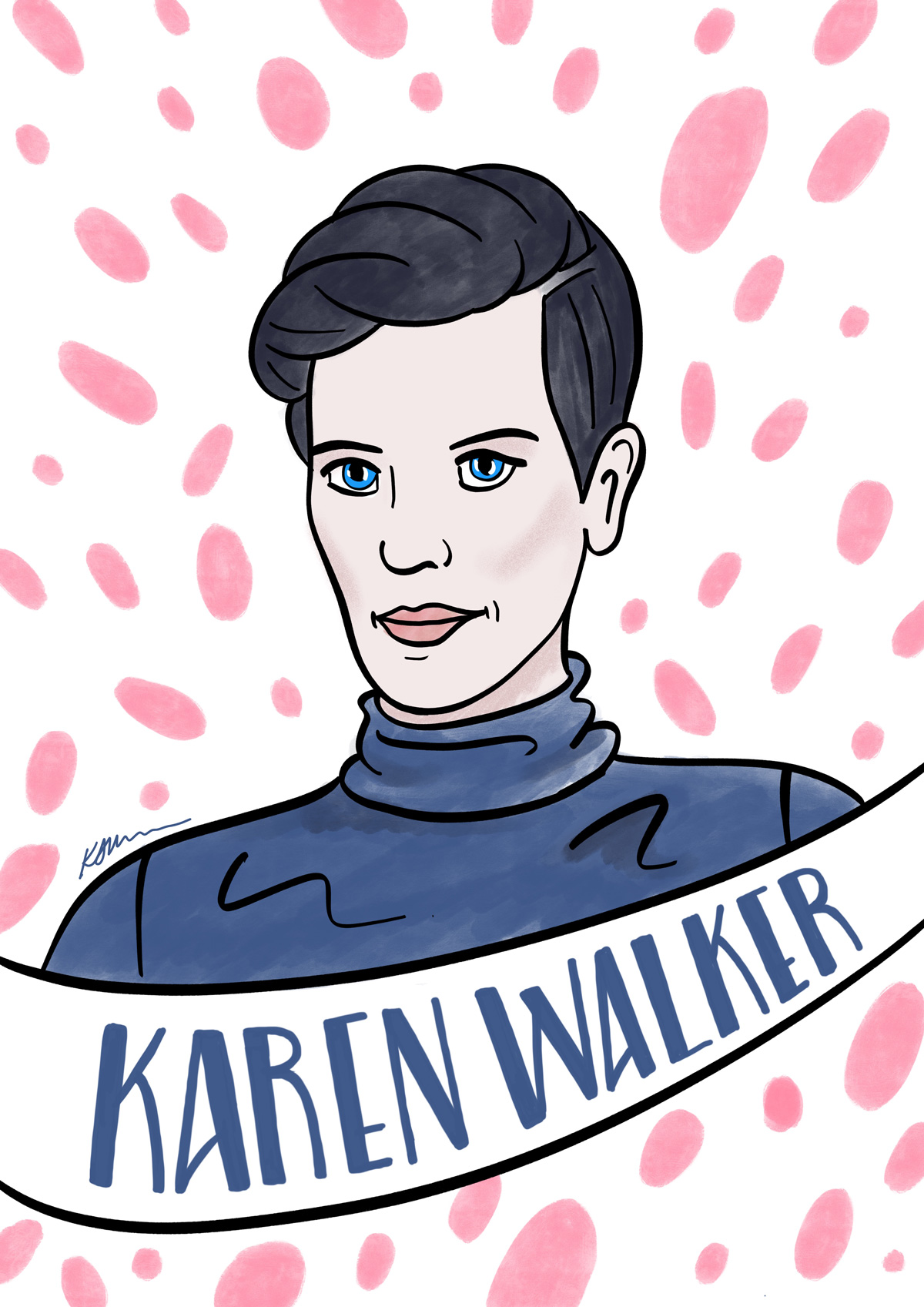
EVA RICKARD
KAITIAKI OF HER PEOPLE'S LAND
Tuaiwa Hautai "Eva" Rickard
1925 -1997
Tainui Awhiro
Of Tainui descent, Eva was born and brought up at Te Kōpua, Raglan. As a young woman she saw the land at Te Kōpua taken and her people moved away, so that a wartime airport could be built. After the war the government’s promise to return the land to Tainui was not honoured. Instead the land became the Raglan golf course.
For Eva this was the start of a long struggle. She told of seeing and hearing the spirits of her dead mother and brother in her dreams. She said they urged her to fight and reclaim the ancestral homeland of their people. During the 1970’s she led this fight and became a kaitiaki (guardian) of her people's land. In 1978 Eva was arrested, with 19 other protesters, during a sit-in protest on the 9th hole of the Raglan Golf Course. Her arrest was shown on national television and became a defining moment in this struggle. Eventually the golf course land was returned to Tainui Awhiro. It became a farm, with a marae and training centre site. Eva’s struggle resulted in changes to the law. If land taken for public works is no longer needed, the government must now return it to the original owners.
In 1984, Eva led over 2000 tribal representatives, church leaders and some Pākehā on Te Hikoi ki Waitangi, demanding an end to Waitangi Day celebrations until all Treaty grievances were settled. All her life she also fought for women’s rights within Māoridom, encouraging other female activists to ignore traditional Māori protocol and speak at official Māori gatherings, including on the Marae.
While Eva was often criticised for her views and actions, she held true to her values and her desire for justice for her people.
Bibliography
'Eva Rickard', URL: https://nzhistory.govt.nz/people/eva-rickard, (Ministry for Culture and Heritage), updated 17-May-2017
https://en.wikipedia.org/wiki/Eva_Rickard
http://uriohau.blogspot.co.nz/2007/05/eva-rickard.html
https://teara.govt.nz/en/photograph/11589/eva-rickard
Coney, Sandra: Standing in the Sunshine-A history of New Zealand Women since they won the vote. Penguin Books NZ Ltd, 1993
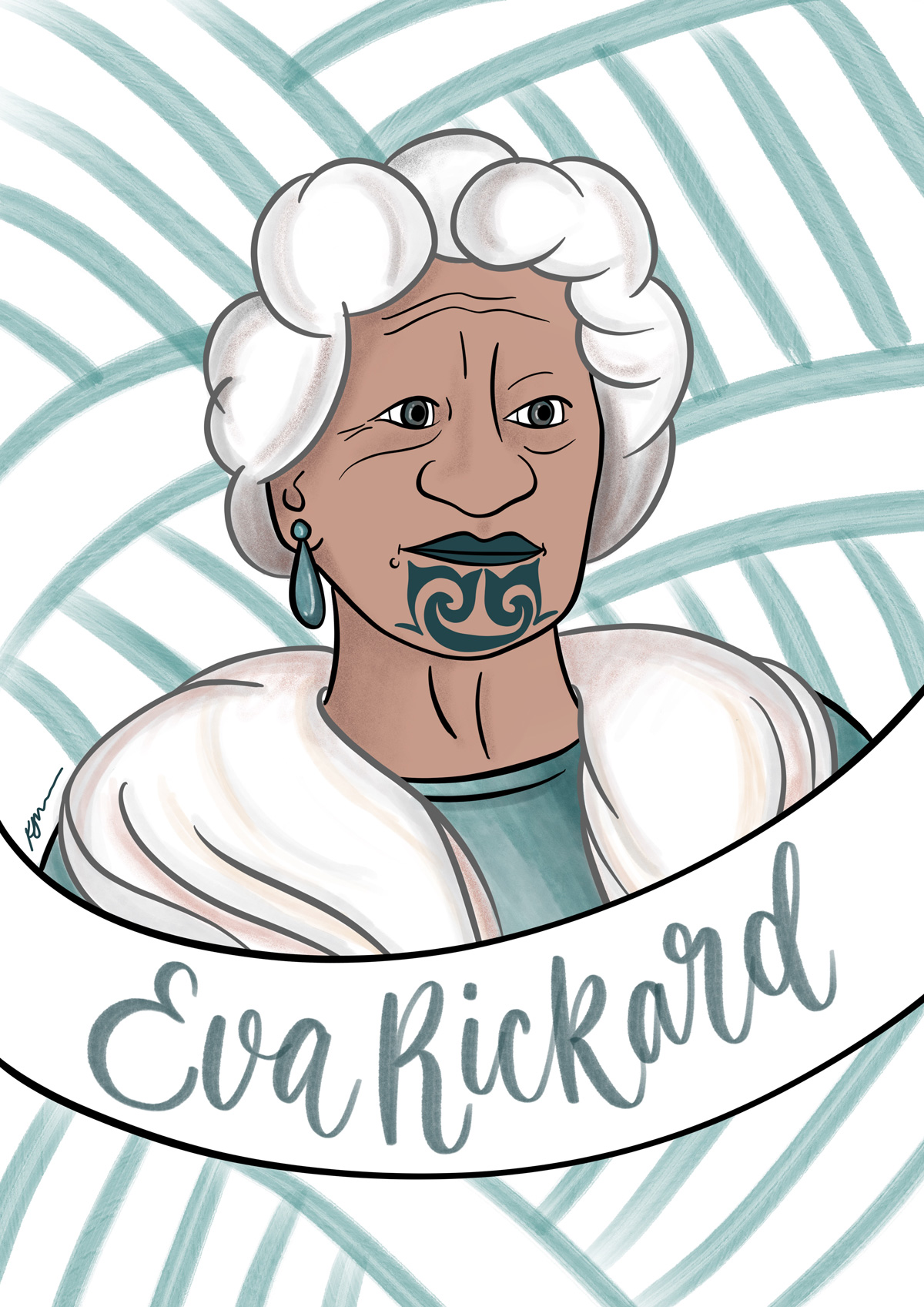
ROSEMARY ASKIN
ANTARCTIC GEOLOGIST
Rosemary Anne Askin
b.1949
A fascination with rocks and fossils led Rosemary to the study of geology and zoology. She was the first New Zealand woman to undertake her own research programme in Antarctica. Before Rosemary, Antarctic research was an exclusively male domain, but her research skills and fortitude in the harsh Antarctic climate set a benchmark for the women who followed her into Antarctic science.
In the summer of 1970, 21 year old Rosemary became the first woman to work in a deep field setting, living for weeks in a tent camp, far from the relative comfort of Scott Base. This expedition discovered Antarctica’s richest-known site of fossilised fish remains. She was also a member of the research team that discovered the first mammal fossils in Antarctica.
Rosemary visited the southern continent many times over the next 30 years, studying fossilised pollen and spores and looking at the way the vegetation had changed over time. The naming of Mount Askin in the Antarctic Darwin Mountains recognised her special contribution to Antarctic research.
Bibliography

MAVIS RIVERS
THE PUREST VOICE IN JAZZ
Mavis Chloe Rivers
1929 – 1992
Considered by Frank Sinatra as the ‘purest voice’ in Jazz, Mavis is remembered as New Zealand’s finest jazz singer. Just a teenager when America joined WWII, she became a troop mascot, singing to thousands of serviceman stationed in American Samoa, with her father’s band. After moving to Auckland Mavis soon became one of NZ’s most popular female singers, performing on radio, in cabarets and recording on the fledgling New Zealand TANZA and Zodiac labels. These recordings form an important part of New Zealand’s history of recorded music.
In the mid-fifties she moved to the USA, studying in Utah before settling in Los Angeles. Mavis signed first with Capitol records and then with Frank Sinatra’s Reprise Label and in 1960 she was nominated for the Grammy for Best New Artist. She continued to perform until her sudden death after a performance in Los Angeles.
Bibliograpy
Shane Rivers. 'Rivers, Mavis Chloe', Dictionary of New Zealand Biography, first published in 2000. Te Ara - the Encyclopedia of New Zealand, https://teara.govt.nz/en/biographies/5r13/rivers-mavis-chloe (accessed 28 November 2017)
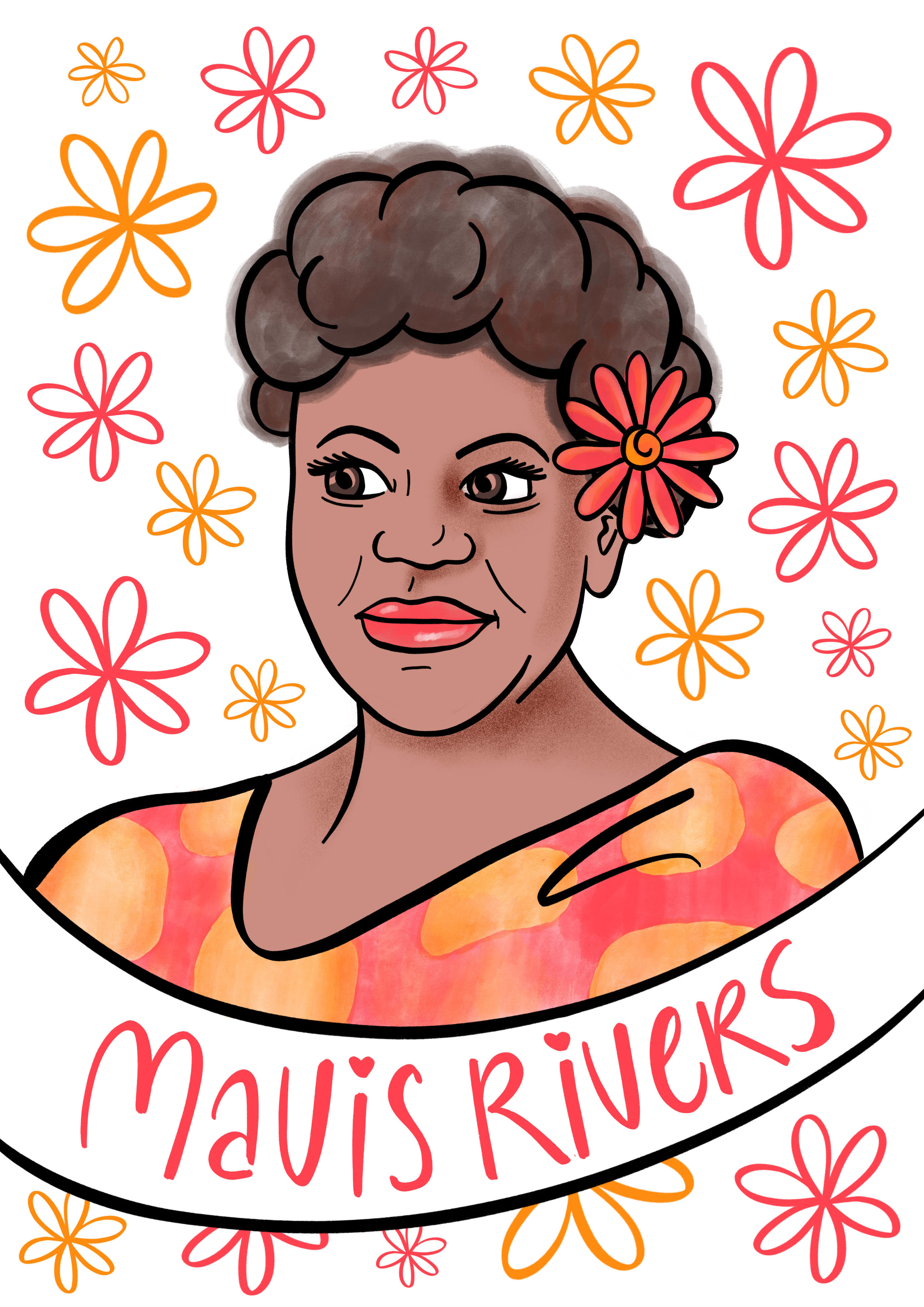
BEATRICE TINSLEY
"QUEEN OF THE COSMOS"
Beatrice Muriel Hill Tinsley
1941 – 1981
Dubbed the Queen of the Cosmos, Beatrice rose to the top of the male dominated field of astronomy. Her creative thinking and original research changed scientists’ understanding of the origin and size of the universe. She pioneered models of galactic evolution and changed the way the distances to far- away galaxies were calculated (all before computers!).
From the age of fourteen Beatrice wanted to be an astronomer. In the 1950’s only men were astronomers but that didn’t deter her and she graduated with an MSc in Physics in 1961. Unfortunately Beatrice didn’t realise that when she married a fellow physicist, she would no longer be allowed to teach at any university where her husband worked. When he took a university appointment in Dallas, Beatrice commuted 300km to work part time at a different university, as well as completing her PhD in half the usual time. Because she was a married woman her ground breaking PhD research was initially not taken seriously. Eventually she had to choose between her marriage and her career.
Following her divorce Beatrice was appointed to the staff at Yale University and three years later she became their first female professor of astronomy. She was just thirty eight years old. Beatrice also was a gifted teacher. She developed new teaching methods and mentored young women scientists in New Zealand and North America, right up until her early death from melanoma.
Bibliography
http://www.nzedge.com/legends/beatrice-tinsley/
More to Read:
Cole Catley, Christine :Bright Star - Beatrice Hill Tinsley Astronomer, Cape Catley, 2006,
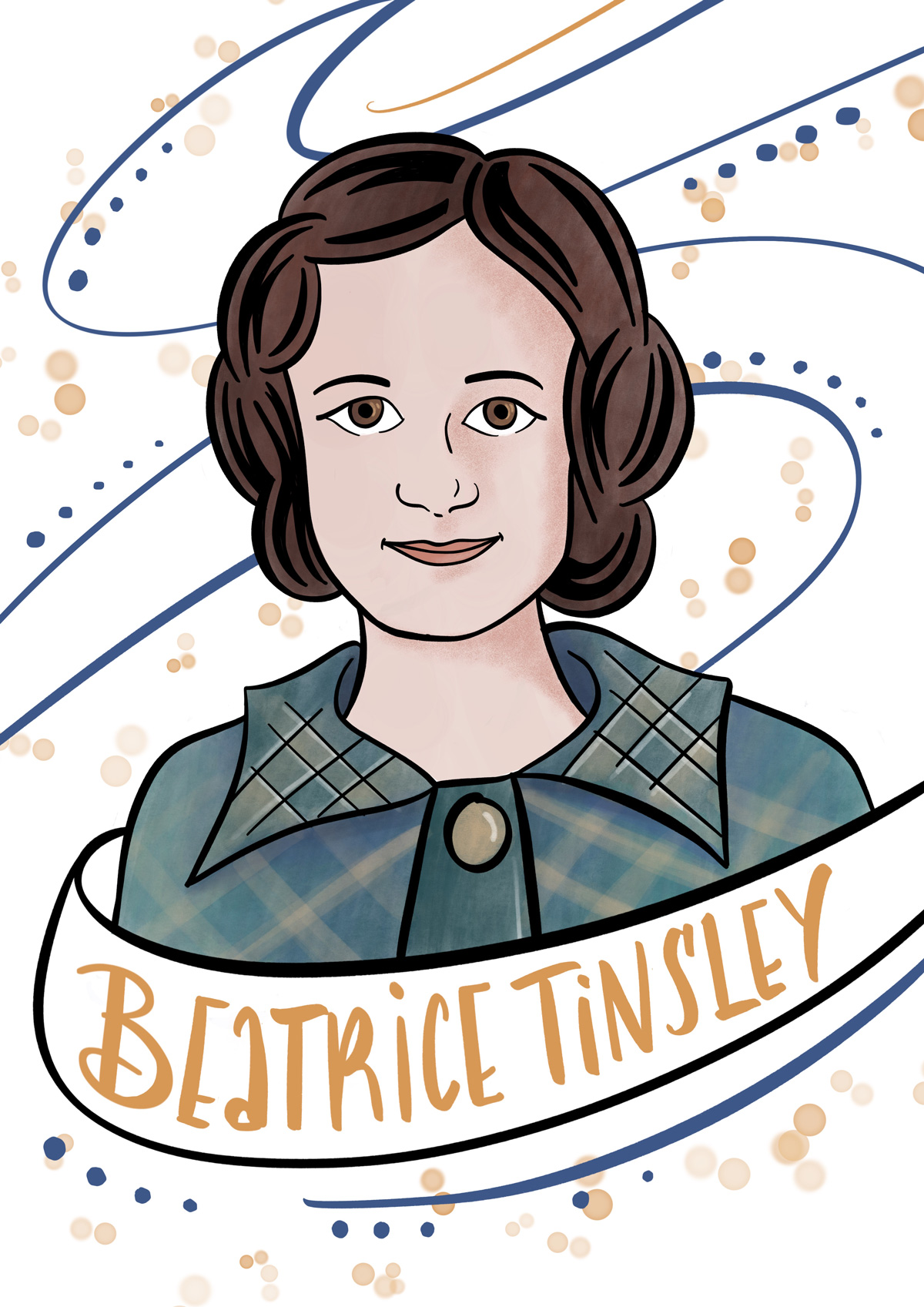
IRIAKA MATIU RĀTANA
FIRST MĀORI WOMAN ELECTED TO PARLIAMENT
Iriaka Matiu Rātana OBE
1905–1981
Te Āti Haunui-a-Pāpārangi
Born on the Whanganui River, Iriaka Te Rio had connections to Te Āti Haunui-a-Pāpārangi through both parents. She was a talented singer and at 16 went to live at Rātana Pā. She performed in and trained the cultural groups that travelled around New Zealand with prophet Tahupōtiki Wiremu Rātana.
In 1925 she became the prophet’s second wife. After his death, Iriaka married Matiu Rātana, her late husband’s son by his first marriage. They ran a dairy farm at Whangaehu and after Matiu won the Western Māori seat in 1945, Iriaka often had to run the farm and the family alone.
When Matiu died four years later Iriaka decided to step into his place. Despite some vehement opposition she was selected as the Labour Party candidate and was comfortably elected in November 1949 becoming the first woman to represent Māori in the New Zealand parliament. After giving birth to her seventh child a month later, she entered Parliament. Iriaka was eloquent, gentle and always polite and she was listened to with respect by both sides of the House. Her electorate covered much of the North Island. She didn’t drive or fly but often covered 10,000 km a month by bus and train, working tirelessly to improve living standards of Māori, particularly at the church settlement of Rātana Pā. Iriaka retired from Parliament in 1969 and in 1971 was appointed an Officer of the Order of the British Empire for services to the Māori people.
Bibliography
Angela Ballara. 'Ratana, Iriaka Matiu', Dictionary of New Zealand Biography, first published in 2000. Te Ara - the Encyclopedia of New Zealand, https://teara.govt.nz/en/biographies/5r7/ratana-iriaka-matiu (accessed 2 February 2018)
'Iriaka Rātana ', URL: https://nzhistory.govt.nz/people/iriaka-ratana, (Ministry for Culture and Heritage), updated 8-Nov-2017

BARBARA KENDALL
FIVE TIMES OLYMPIC BOARDSAILOR
Barbara Ann Kendall OBE
b.1967
As an Olympic superwoman on the water and the only NZ women to compete in five Summer Olympic Games, Barbara won a gold, silver and bronze medal in boardsailing. She and her brother Bruce are the only Kiwi brother and sister to both win Olympic gold medals.
At school she competed in swimming and athletics, but her greatest passion and talent was dancing and by the time Barbara was fourteen she was teaching her own dance classes.
She spent her summer school holidays with her family on their old yacht ‘Sunlight’ and learnt to sail in the weekends, initially competing in P class then moving on to Starlings.
Barbara took up boardsailing when she was 17 and three years later she joined the professional boardsailing circuit. She was twice NZ Sailor of the Year, five times winner of the Halberg Award for Sportswomen of the Year and she was awarded an OBE in 1993 for services to boardsailing. Barbara retired in 2010 after 24 years at the top of her sport.
Bibliography
http://www.olympic.org.nz/assets/Uploads/NZOC-Ambassador-Profile-Barbara-Kendall-final.pdf
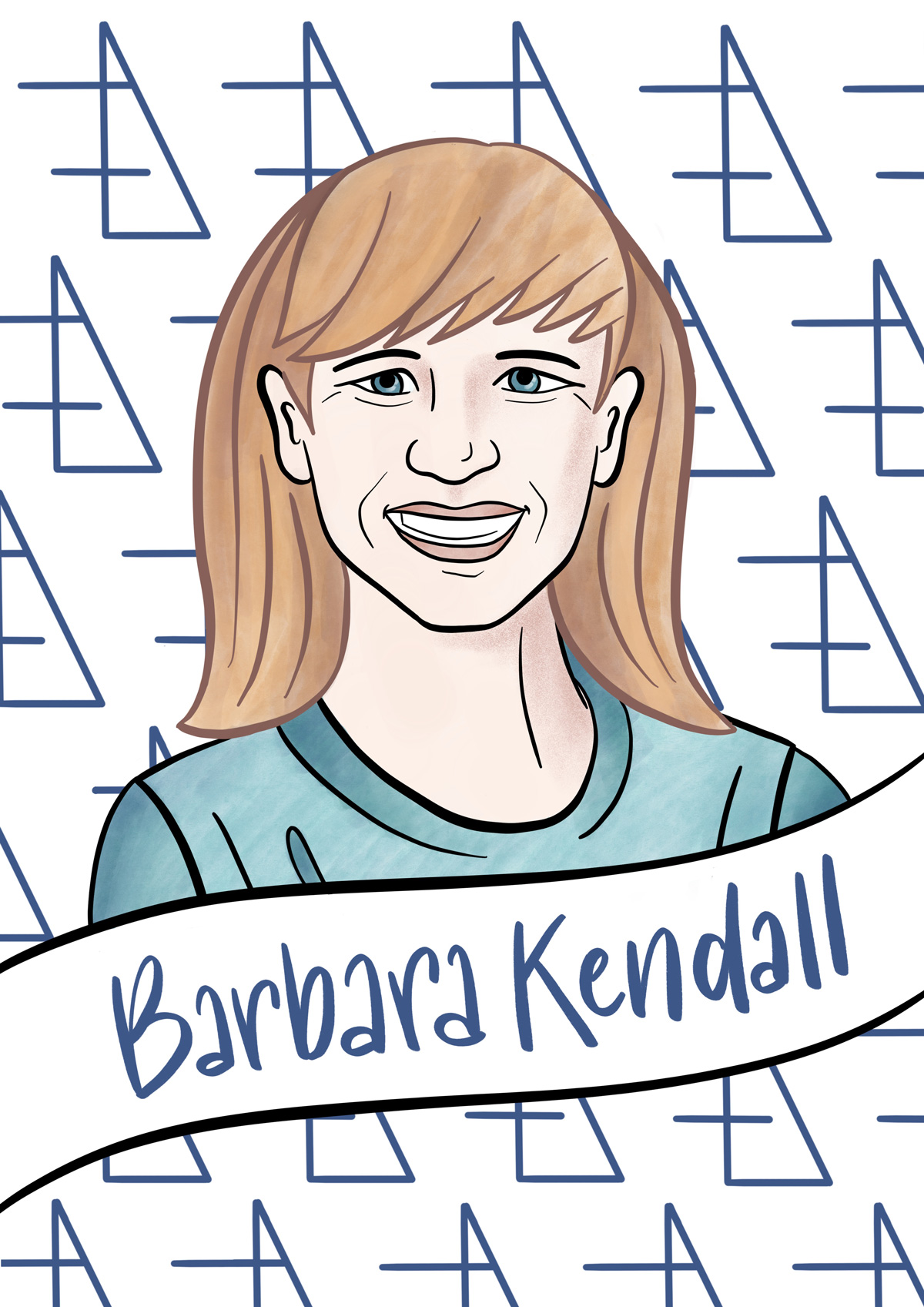
DAME AUGUSTA WALLACE
NEW ZEALAND'S FIRST WOMAN JUDGE
Dame Georgina Catriona Pamela Augusta Wallace DBE
1929 – 2008
In the mid- seventies, only two percent of New Zealand’s lawyers were women and so it was an exceptional achievement for Dame Augusta to be appointed as the first woman judge in the District Court in 1975. She served in this role for 18 years.
After graduating from the University of Auckland, she was admitted to the bar in the mid 1950’s and practiced independently for eleven years before being appointed a judge. Dame Augusta said she had spent a lot of time fostering a grim, dragon image because in the legal profession it often helped to look forbidding; but beneath her brisk manner on the bench she had a great sense of humour. Her consummate professionalism was important in increasing the acceptance of women in legal practice in New Zealand.
In 1990 while presiding over the Otahuhu Youth Court, a young man lunged at her with a machete, slashing open her face and breaking her jaw. This incident lead to a national review of court security.
Dame Augusta also chaired the Abortion Supervisory Committee and served on the Waitangi Tribunal and throughout her life worked tirelessly for several community organisations including Age Concern, the Hope Foundation and Victim Support. In 1993 she became a Dame Commander of the Order of the British Empire.
Bibliography:

MERATA MITA
LEADER IN MĀORI FILMMAKING
Merata Mita, Companion of the Order of Merit
1942-2010
Ngāti Pikiao, Ngāi Te Rangi
As a film director, producer and a passionate voice for Māori, Merata broke down nearly every barrier known to Māori women. For her, image was a powerful means of communication. She also pioneered Maori current affairs on television, acted, lectured and mentored the next generation of filmmakers.
Merata worked tirelessly for Māori creative control because she believed that Māori bought a unique passion and intensity to the telling of their stories. She became a leader in Māori filmmaking and was the first NZ woman to produce a feature –length documentary, Patu (1981), a passionate record of the clashes between police and protestors during the 1981 Springbok Rugby tour. In 1988 her film Mauri, became the first feature written and directed by a Māori woman.
Throughout her life Merata used film to push for for social change in race relations, justice, the portrayal of Maori history and workers’ rights. She was made a Companion of the Order of Merit, not long before her sudden death in 2010.
“Swimming against the tide becomes as exhilarating experience. It makes you strong. I am completely without fear now.”
Bibliography
https://www.nzonscreen.com/person/merata-mita/biography
Peter Sharples – Tribute https://www.thebigidea.nz/stories/tribute-merata-mita
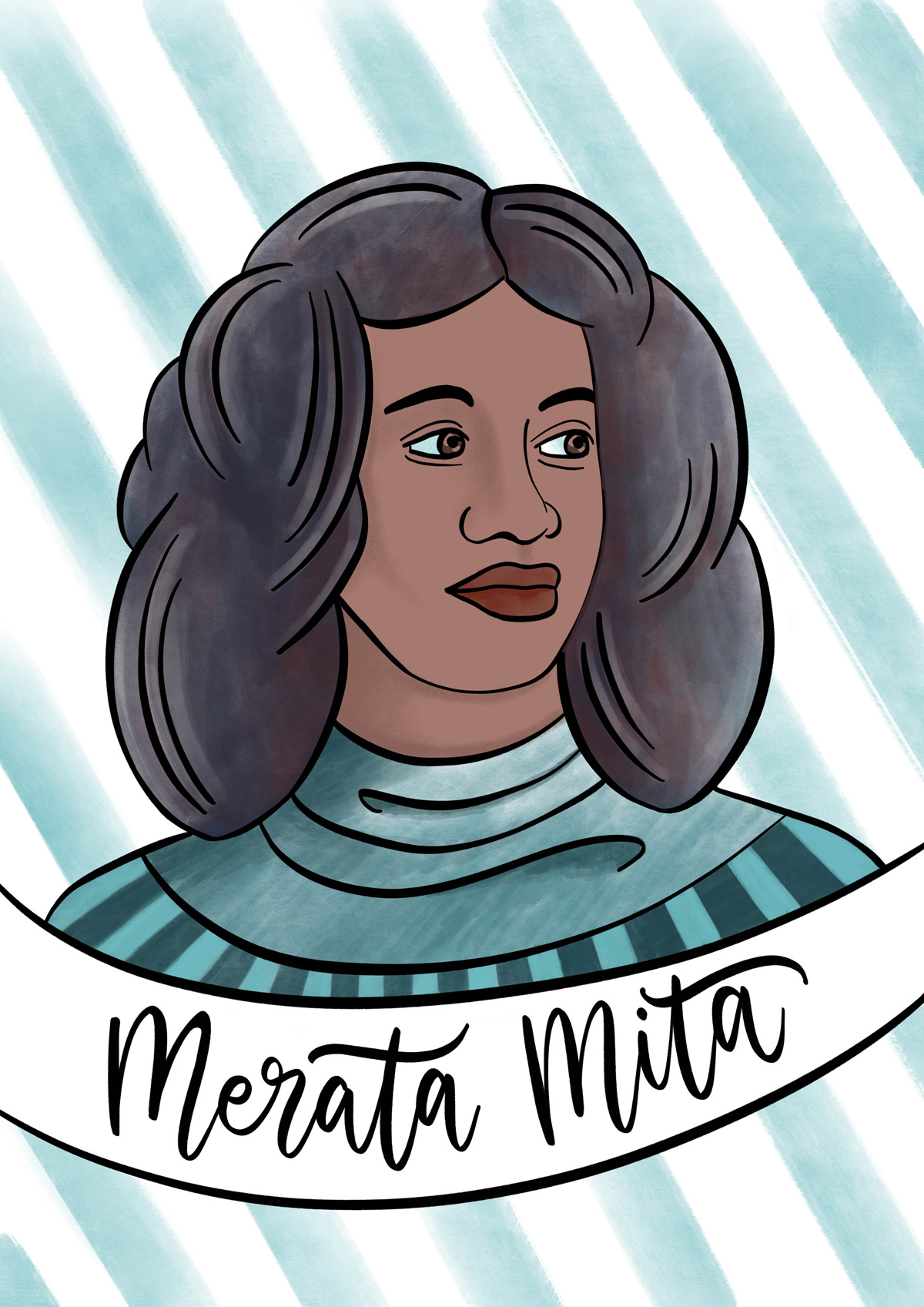
TUI FLOWER
NEW ZEALAND'S JULIA CHILD
Tui Flower QSM
1925 –2017
She was a small woman with a big personality and Tui single-handedly changed the way New Zealanders cook. She invented ‘food writing’ in New Zealand during her time as food editor of the New Zealand Women’s Weekly from the 60’s to the 80’s. Her clear, common sense recipes showed a new generation how to serve up more than ‘meat and three veg’. Her recipes included ‘exotic ingredients’ such as wine, garlic, capsicum, eggplants, broccoli avocado and oil and Tui showed women how to embrace new kitchen technology.
After studying Home Science at the University of Otago in the 1940’s, Tui travelled through America attending Cordon Bleu courses and discovering food journalism. In the 50’s she moved to Paris and became the only woman in her class at the École Hôtelière de Paris, in an environment where women were barely tolerated.
Tui had great respect for the generations of women cooks who had come before her, women who could create meals on coal ranges with the minimum of equipment. She in turn became a mentor to many young New Zealand food writers and chefs and has been described as “New Zealand’s Julia Child”.
Bibliography
https://www.nowtolove.co.nz/news/real-life/tui-flower-in-full-bloom-5738
https://cclblog.wordpress.com/2010/05/14/tui-flower-legend/
More to Read
Self Raising Flower by Tui Flower. Viking, Auckland 1998
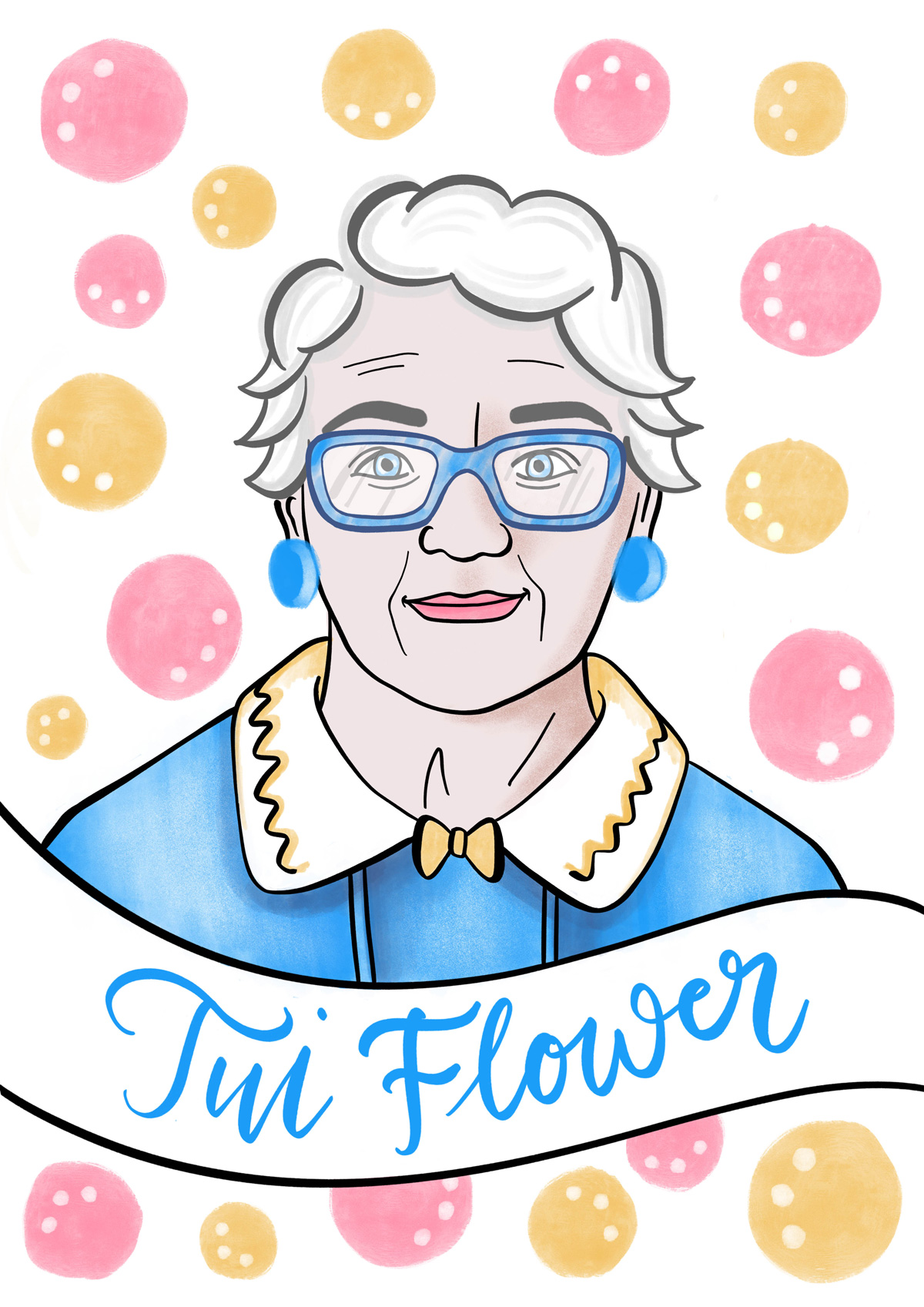
DAME YVETTE WILLIAMS
STELLAR ATHLETE AND FIRST NZ WOMAN OLYMPIC MEDALLIST
Dame Yvette Winifred Williams DNZM, MBE
1929 - 2019
She was the running, jumping, throwing, hurdling athlete of the early 1950’s and New Zealand’s athlete of the century yet Yvette had shown little athletic ability at school. She joined the local athletic club for the social life but two months later won the national shotput title and Jim Bellwood became her coach. While most believed weight training was bad for women, Yvette often ran in heavy army boots carrying brick weights. Conscientious training, outstanding physical ability and determination helped her win a gold medal in the long jump at the 1952 Helsinki Olympics.
She was first NZ woman Olympic medallist and the first New Zealander to win a medal in an Olympic field event. During her stellar career she held the world long jump record for 18 months and won 21 national titles in shotput, long jump, discus, hurdles and javelin and has inspired generations of NZ women athletes.
Yvette died in Auckland on 13 April 2019 at the age of 89, 12 days before her 90th birthday.
In the 2019 Queen's Birthday Honours, Williams was posthumously promoted to Dame Companion of the New Zealand Order of Merit, for services to athletics; the Queen's approval of the honour took effect on 12 April, the day before Yvette’s death. She had been advised of the award before her death.
Bibliography
'Yvette Williams', URL: https://nzhistory.govt.nz/people/yvette-williams, (Ministry for Culture and Heritage), updated 27-Feb-2017
Moses, Ken (6 February 1951). "Jumpers are her speciality". The Argus. p. 11.

ARAPERA KAA BLANK
MĀORI POET AND TEACHER
Arapera Hineira Kaa Blank
1932 – 2002
Ngāti Porou, Ngāti Kahungunu,
Rongowhakaata, Te Aitanga a Māhaki
Articulate and opinionated, Arapera was a celebrated writer and thinker and one of New Zealand’s first bilingual poets. She was part of a group of Māori writers also writing in English in the 1950’s, and won a special Katherine Mansfield Memorial award in 1959 for one of her first pieces of writing. In her essays, poems and short stories she explored the clash of Māori and Pakeha culture, the migration of Māori to the city, and the role of women in New Zealand – particularly Māori women.
Born in Rangitukia on the East Coast, Arapera was proud to be a Maori woman. She was regal, glamorous and funny. For 25 years she was a passionate high school teacher and many of her past students still think of themselves as “Ma Blank’s girls.”
"I enjoy words that sparkle, whether they be in Māori, my mother tongue, or English. What a privilege it is to inherit and to appreciate a language, and to enjoy another equally."
Bibliography
https://www.komako.org.nz/person/78
http://www.nzherald.co.nz/lifestyle/news/article.cfm?c_id=6&objectid=2348913
http://www.nzbooklovers.co.nz/book-reviews/for-someone-i-love-a-collection-of-writing-by-arapera-blank/
http://teaohou.natlib.govt.nz/journals/teaohou/issue/Mao29TeA/c4.html
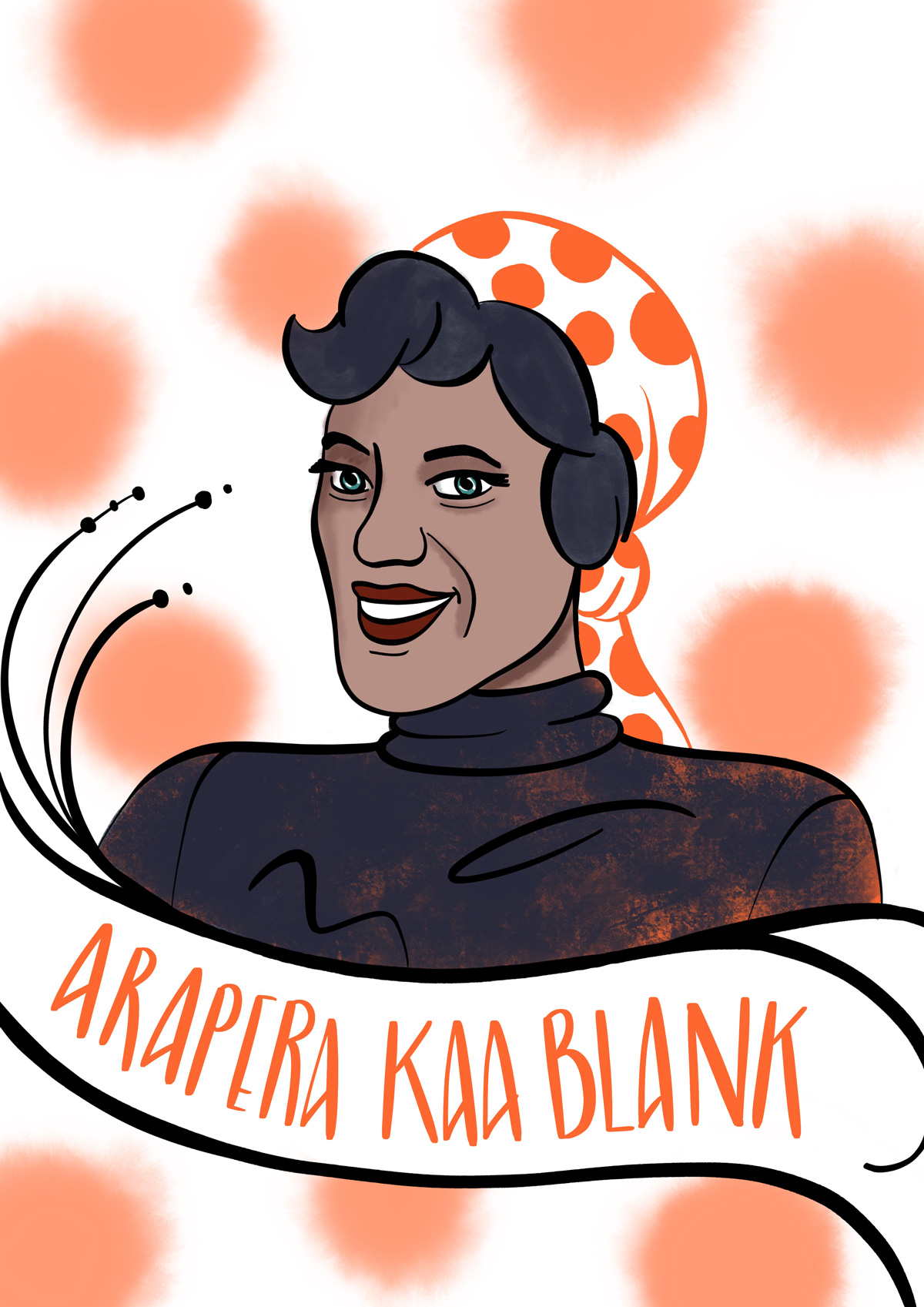
EMILY SIEDEBERG
NEW ZEALAND'S FIRST WOMAN DOCTOR
Emily Hancock Siedeberg-McKinnon, CBE
1873 –1968
After pursuing a career chosen for her by her father and studying at the University of Otago Medical School, Emily became New Zealand’s first woman doctor when she graduated in 1896. The university had no objections to her studying medicine but her male classmates were not happy. They fired at her with pea shooters during lectures, threw bits of flesh her way in the dissection room and subjected her to hoots and catcalls. She was even asked to leave some ‘sensitive’ anatomy lectures and be taught alone.
Emily was a strong, courageous and determined woman, who was unafraid to say what she thought. All her practicing life she worked to improve the health of women and children but she found it hard to establish herself in practice. Many viewed her not as a real doctor, but rather as superior kind of nurse. For thirty years she had to supplement her private practice income by working as a medical superintendent at St Helens Maternity Hospital.
She was the founder and first president of the New Zealand Medical Woman’s Association. But change was slow. Thirty years after Emily graduated only 7% of NZ medical graduates were women. Today, 120 years later, more than 50% of New Zealand medical graduates are women.
Bibliography
Coney, Sandra: Standing in the Sunshine-A history of New Zealand Women since they won the vote. Penguin Books NZ Ltd, 1993
Patricia A. Sargison. 'Siedeberg, Emily Hancock', Dictionary of New Zealand Biography, first published in 1996. Te Ara - the Encyclopedia of New Zealand, https://teara.govt.nz/en/biographies/3s16/siedeberg-emily-hancock (accessed 2 February 2018)
